#yes I am basing this entirely off of one sixty second exchange
Explore tagged Tumblr posts
Text
I’m calling it - Weir and Lorne are fucking.
#stargate atlantis#evan lorne#elizabeth weir#yes I am basing this entirely off of one sixty second exchange#but no one talks to their boss like that#S2.10
12 notes
·
View notes
Text
mists of celeste ➻ 30
➻ pairing: ??? x fem reader ➻ genre: space au, pirate au, space pirate!ateez, angst, smut ➻ Word Count: 12.0k ➻ Rating: M ➻ Warnings: language, violence, guns and weaponry, blood, future warnings tba ➻ summary: Sneaking aboard the ship of a renowned space pirate may not have been the best idea, but you’ll have to make do with what fate has handed to you
⇐ previous | next ⇒ | masterlist

✧✧✧ act four ➻ part five
“I hate playing a waiting game,” Jongho mutters as he runs a finger over the rim of his glass. The liquor inside trembles from the faint touch, small waves rippling over the surface before coming to a rest again when Jongho pulls his hand back.
You pay little attention to the movements. You’re far too preoccupied with the dainty hand-drawn map in front of you: the small blueprint you hastily drew before coming to the dingy bar thirty minutes ago. Too much of your time in the military is hazy, and the parts that are clear and at the forefront of your mind are most certainly not diagrams of whatever the military bases look like. You have little hope that your memory is serving you well, and even so, there is no guarantee that the military here on Kebos hasn’t changed their systems in the past few years. Jongho holds much more faith in your abilities, however, and he hums as he glances over your work.
“It looks good.”
You can’t keep from rolling your eyes at the tone of his voice, mostly thanks to the constant thrum of anxiety in your gut.
“There’s a big chance that this base won’t even be built the same as in the past,” you mumble. You retrace a few lines off to the side in efforts to busy yourself and quell your nerves, but it does little to help. Jongho shakes his head, and you catch the motion out the corner of your eye.
“This one has been standing for at least sixty years, according to Seonghwa. It’s merely been repurposed time and time again, so… layout should be the same. Even if it’s a little different, you know what you’re talking about. Surely Yeosang can manage it too with his experience.”
“No, he’s – he wouldn’t have spent his time in warehouses and inventory bases. Not with a royal background.” You blink down at the table with little interest, taking your lower lip between your teeth and gnawing lightly at it. “It’s too quiet. Isn’t it? Are San and Yeosang okay?”
A sigh passes Jongho’s lips as he looks over at you, then he shakes his head once more.
“They’re probably fine. They–”
As though on cue, the comm pressed to the shell of your ear crackles to life, and Jongho winces as his does the same, the suddenness of the action catching you both off-guard.
“Hey, it’s me.” You and Jongho both exchange a glance, one that holds a bit of disappointment as it’s only Seonghwa’s voice that crackles through the comms channel. “I’m just checking in – have you made it yet?” You know that the ‘you’ in his sentence is figurative — something to keep Hongjoong from catching onto what’s really going on behind the scenes.
“No, they haven’t – we, I mean, we haven’t gotten there yet,” you reply, keeping your tone to a quiet minimum.
“Can you hear me? Hello?” Relief finally comes, and San’s voice is like warm honey against your ear.
“San,” you exhale. Your jaw stutters a bit as you try to come up with something else to say, but San continues speaking before you get the chance to say anything.
“We just got past a radio barrier. I’ve been trying to reach you guys for at least ten minutes.”
“Well, comms are back online, it seems,” Seonghwa responds, voice fading a bad at the tail end of his sentence. Jongho extends a hand towards you and drops it atop your thigh. It’s a small comfort, but a comfort nonetheless, and you pass him a smile of gratitude.
“I told you not to worry,” he murmurs quiet enough to escape the comms. Your smile devolves into a slight frown, and you bring your chin forward again.
“That was the easy part. Now they need to get past the militia barrier and scanners.”
“You don’t have any faith in us?” It’s Yeosang’s voice that crackles over the comms this time, and you huff out a laugh.
“Stay quiet. There might be guards or patrols nearby.” You refuse your attention back to the map before you, trying to pinpoint where the pair might be at this point. “Hey, one of you look to the left. There should be a grey box on the wall. It’s a router to the laser scanners. Maybe tucked closer to the floor?”
“Yeah, yeah, I see one,” San responds quickly.
“Okay, you’ll need to shut that down by pulling a… um, hopefully a red wire out and cutting it? I never took care of these mechanics on jobs.” You swallow around nothing, feeling the heat of Jongho’s stare on the side of your head, but you try to push it out of your mind in favor of focusing on the task at hand.
“On jobs?” San echoes, curiosity clear in his tone. “You were a soldier. What use would have for jobs like these?” You inhale sharply, and the sound carries over the comms with haste.
“Focus, San,” Seonghwa cuts in without giving you a chance to answer his question.
“Yeah, okay. I’ll cut the wire righ–”
“No, no! Wait a second, you need to know something before going in. As soon as that wire is cute, you’ll only have a limited amount of time to get to the infirmary where the serums are stocked. The guards will notice that something is off and that there’s a break-in within the facility so speed is key,” you explain, maintaining your hushed tone from earlier as you trace a finger over the map on the table. “The infirmary will be straight down the hall, then you’ll need to take the first left, two rights, another left, and it’ll be the last door on the left at the end of that corridor. There is a chance that they don’t store the serum in the infirmary, but all new recruits are taken to one before going through induction. I’ve seen it happen too many times to forget it, so I’m fairly confident that that’s also where the operations happen and the serums should be there.”
“And what are we supposed to do if someone is there?” Yeosang inquires. You hesitate a moment, not realizing that he’s speaking to you and not Seonghwa until the lieutenant provides no response.
“Um… kill them,” you mutter. Jongho’s expression doesn’t shift in the slightest, and he remains unreadable as you search his eyes for some sort of reaction. The only response you get is from Yeosang in the form of a huff of air.
“That’s more like the killer I know you to be, Ghost.”
“You don’t know anything about her,” San sneers back without missing a beat. Yeosang hisses through his teeth – a sound that is nothing more than a whistle over the comms channel.
“Am I stepping on little lover boy’s toes, is that it? Seems like you need to bring that up with someone else before you go around claiming things for your own.”
A crash resounds, then a bang against metal that is so loud it rings in both your ears. You can only imagine what’s happening on the other side of the line, whether San and Yeosang are merely fighting with each other or in serious danger.
“Don’t you fucking call her a thing! Should I start referring to Wooyoung as ‘slave’ again?”
“You fuc–”
“Knock it the fuck off, you two.” Seonghwa’s voice growls over the line. His tone is so severe that both you and Jongho sit up a bit straighter in your seats even though he’s not referring to either of you. San and Yeosang fall silent at the sound of Seonghwa’s harsh tone, not daring to make a sound as the lieutenant continues speaking. “Fight over who has a bigger dick later. This is more important than fucking feelings.”
“I’m not the one having trouble keeping feelings in check,” Yeosang spits.
“God, Hongjoong is a fucking moron for putting the two of them on a mission together,” Jongho mutters as he rubs the skin between his eyes. “Like putting fire and ice together and asking them to cooperate.”
“Yeosang. Don’t make me tell you twice. Do not start shit, and get the damn mission done without further trouble.”
“Yes, Lieutenant.” It’s more than obvious that Yeosang is biting his tongue through the words, holding back what he truly wants to say in efforts to be cooperative, and you almost respect him for it if not the preexisting annoyance you have surrounding the man.
“You two need to hurry this along,” you say once the silence becomes too palpable to handle. “It’s almost time for a unit to make the rounds and check the systems. You need to get going before the half-hour.”
You don’t get a verbal response from either San or Yeosang, and instead, a reply comes in the form of a loud clang of metal. The line falls quiet after that, not because it’s gone dead but because neither man is speaking anymore, and now it comes down to playing the waiting game as they make their way through the base. You drop a hand atop where Jongho’s rests against your leg and clench your fingers hard around his. The wait causes you to hold your breath. You expect the worst to happen, for one of the two to say that they’ve been caught, or that your map was wrong entirely and you’ve led them into a dead end. The possibilities of failure are endless, and your mind won’t stop running through all of them.
“You said the last door on the left?” Yeosang huffs, radio crackling with noise. You exhale a sigh of relief, and tension falls away from your shoulders once you hear San’s footsteps falling beside Yeosang’s.
“Yes, yes, at the end of the corridor.”
“Yeah, we’re in the right place.”
“Are you certain?”
“It’s a big white door with the word infirmary on it, I’m fairly certain we’re in the right place,” Yeosang retorts through a scoff.
“Well, be careful going in as there could be–”
A crash interrupts your train of thought, leaving you to cut off with a deep sigh, and you roll your eyes to keep from snapping at the pair on the other side of the line.
“Do you have to be so loud and obnox—holy shit.” San’s voice falls quiet, and the insult he threw in Yeosang’s direction must not process because the Elitist doesn’t say a word in reply.
“What’s going on?”
“There’s… There have to be hundreds if not thousands of vials in here. Hell, if only you guys could see this.”
“The serum?” You murmur even though you can assume what San’s answer will be.
“Every single one… all have this strange-looking blue liquid in them.”
A stab of a needle, a syringe going into your skin, a strange blue liquid being pushed into you. Warmth, then the feeling of your blood turning to ice.
Your eyes flutter shut. You bite the inside of your cheek sharply to ground yourself, keep yourself from slipping too far into the memory, and Jongho’s hand twists so that his fingers slip through yours. You couldn’t be more grateful for the gesture now; the warmth and comfort in it grounds you just enough to stay on track.
“That’s it.”
“You’re sure?” San inquires, more of a precautionary question than anything else.
“Positive,” you mutter back without hesitation. Seonghwa’s voice crackles over next, a coolly spoken command falling from his lips that has a chill running down your spine.
“Secure the package then.”
“You want us to destroy them all?” San asks. Something twists in your gut, something so unpleasant that you could vomit just from the thought of it. This was the agreement, was it not?
“As many as you can, yes.”
Morality is far too muddy for your liking. Too many hazy and thin lines, too many places where one should read between the lines, and far too many instances in which morals can clash. Life would be much easier if morals didn’t exist at all.
Of all people, you should want these vials destroyed more than anyone else. Yet you can’t shake the thoughts that intruded the precious day, the ones which haven’t left you alone since.
No matter which way you look at the situation, you can only see it as taking away Mingi’s choice. No one is asking him what he wants, and while you understand the reasoning behind that, you cannot grasp how this is the just thing to do. Whether you give him the serum or not, he won’t have a say in the matter. Where is the line drawn? When it comes to morality, when is it okay to take away someone’s consent and leave them with nothing? Surely when it comes to protecting them, but both these options... both can defend him. What then?
“I… Jongho, we – we can’t do this,” you stutter. Jongho’s hand slips away from yours as he turns to look at you. The confusion across his features is more than evident, and you wish you had a proper explanation for him, but your mind is running a hundred miles per second without slowing down. “I can’t do it.”
“What do you mean?” Jongho’s tone holds too much warning in it. You ignore it all.
“Don’t destroy them,” you call over the comms. “San, Yeosang, don’t destroy them.”
“Why? This is what we agreed on! We were supposed to destroy them!” In the back of your mind, you wonder if San might hate you for this.
“I agreed to nothing,” you murmur, unable to keep your voice steady for much longer. Yeosang snorts.
“Then what was the point of coming here? We aren’t going to do anything except break in and leave empty-handed?”
“What are you doing, Y/N?” Jongho presses further, and his tone is much firmer than before. You can’t bear to look him in the eye – the weight of that feels too heavy on your shoulders.
“I – this is – I’m sorry. I’m sorry, J-Jongho, I–” Your words fail you. You want nothing more than to curl into a ball and shy away from Jongho’s lingering stare. There’s a certain kind of disappointment hiding behind his dark irises, one that takes you back to an all too unpleasant memory.
“How could you do this, Y/N?” This is the last memory you want to revisit right now, but you can’t keep it from overwhelming you in mere seconds.
“How could you be so selfish?” Iron bars separate you from the man, but it doesn’t keep you from catching the gleaming emotion in his eyes. “They won’t give you the luxury of death, don’t you realize that? They’ll take everything from you. Leave you as an empty shell. Throw you to the wolves. They’re going to take you away from us, Y/N.”
“Hyunwoo, I already said t–”
“Just give me some more time. We’ll get this sorted out.”
“How? There’s no fixing this, Hyunwoo! We were caught. I was caught! How do you expect to fix that?”
“I would rather die than see them take your memories of us away.”
Your chin falls to your chest. Your body no longer feels like your own, more like someone has possessed you and taken control, and that’s the only way you can justify the next words that tumble from your lips.
“Yeosang, secure some vials, as many as you think is reasonable.”
“What the hell are you thinking? Are you even thinking?” San’s words sink deep into your chest, penetrating your skin with a pain that’s worse than a knife or bullet. Out the corner of your eye, you can see Jongho’s eyes blow wide open as shock overtakes him as well. “This isn’t the time to joke around, Y/N!” You bite at the inside of your cheek, letting the metallic tinge of blood hit your tongue and swirl through your mouth rather than offering any sort of response to San.
“…Seonghwa?” Yeosang is asking for confirmation, for Seonghwa to overrule you or agree with you, and you don’t know what to expect from the lieutenant until he breathes deeply from his end of the comms.
“Do as told. Secure some vials and get the hell out of there.”
Yeosang is in the midst of replying to Seonghwa’s order when the sound of shattering glass resounds. You don’t need to be present to know what is going on, and Yeosang’s shouts confirm those suspicions easily.
“San, you fucking idiot, what are you doing?”
“I refuse to let this happen!” San counters, tone equally scathing and booming.
“I’m not – San, please, I’m not saying to give the serum to Mingi!” You argue. Every ounce of your tone is weak, too fragile to compete with the rage filling San’s, and you’re certain the words fall on deaf ears. “I can’t do – I can’t take away Mingi’s choice like this, San. If he wants it, then please. Please, if he wants it then we will need to have the serum on hand. If you would just listen to reason for a mo—”
A shrill ringing hits your ear so hard that you wince, and Jongho does the same at your side.
“He just triggered a fucking alarm,” Yeosang hisses through the din. “And won’t quit with his idiotic behavior of knocking the vials off the shelves.”
“You need to stop him, Yeos—”
“I already got three, Hwa. All that’s left is to knock the idiot out seeing as this was not part of the mission.”
“You – You can’t leave without him,” you stammer, head throbbing from the insistent blaring of alarms surrounding Yeosang’s voice.
“I know that. Your little lover boy will be fine once he’s done fucking things up royally.”
The table shudders and your cup clatters as Jongho pushes to his feet, thighs bumping against the lip of the metal, and you have to strain your neck to examine his face.
“Yeosang can’t get out of there with San alone,” he explains without sparing you even the smallest glance. Your heart strains painfully in your chest. What was the cost of your morality? To have Jongho not bear to even look at you? To hear San speak to you with such disdain in his voice? You cannot imagine morality is worth it at all if this is the cost.
“Please sit down,” you beg, hand stretching out desperately to catch hold of Jongho’s sleeve. “There should be – there’s a back exit across the hall, through the door and to the right. Yeosang, you can get out through there.”
“Easy enough. San’s like a feather compared to you, Jongho. I’ll be fine on my own.” The claim appeases the dark-haired Berserker for the time being, and he sinks back down to the bench without another word. You’re more than grateful for the huffs coming from Yeosang and ringing alarms in the background that fill the messy silence hanging between you and the man. “The exit is right here. Where do I go after?”
“Um, you take the first left you can find and follow the path you used to get there. You’ll recognize it, at least you should. Hopefully, all the guards will be inside thanks to the alarms. We should meet you near the hangar bay.”
“Meet him closer than that,” Seonghwa cuts in. His voice has fallen to whisper, no doubt to shroud the words from Hongjoong’s ears. “He can’t carry San the whole way back with the vials on his person too. He’ll need help getting back with both in one piece regardless of what he claims.”
“He’s right,” Jongho mutters. This time when he stands up, he takes hold of your arm and pulls you with him. The grip is surprisingly gentle and light, and for a moment it feels as though you have done nothing wrong in his eyes. “Can’t believe how quickly things went to shit.”
It is an opportunity to apologize. You recognize that much, but your damn pride screams at the edges of your thoughts and tells you not to apologize for doing the right thing.
“It’s fine,” you utter instead. Defeat creeps in like a plague. “Everyone got out in one piece.” Jongho’s gaze shifts to meet yours.
“At what cost? Hongjoong will tear the crew apart because he can’t think straight, and now – now you would join him in that? What are you thinking?” The confrontation hits you square in the chest, and you nearly trip over your own feet as Jongho continues to guide you along. For several moments, all you can manage are a few shakes of your head.
“I know this isn’t what you wanted. This wasn’t the agreement for you to stay but… Mingi needs to make this choice. Not Hongjoong, not Yunho, not San, not you. It has to be Mingi.” Silence ensues between the two of you. You can only drink it in for the few precious moments it lasts before Jongho struggles through his next statement.
“Deep down… I know you’re right, and deep down I know that my desires are selfish and biased.” Jongho manages to maintain his steady pace, eyes so focused on the ground before him that he nearly walks into a wall before you move him aside. “But if I let him go through with this procedure, I don’t know what I will do. Remaking Mingi is a cost too high. I would not be able to have my redemption, I would not be able to see my family ever again, and I – I would not be able to forgive myself either.”
You come to a sudden halt where you are, and the pause forces Jongho to jerk back and face you at last. His eyes shine in a way that hurts to look at, tears that threaten to spill over, but he pulls them back before they can fall.
“Listen, Jongho, I don’t know what happened with your family, and I’m not asking to know that either. That needs to be something that comes from you when you are ready and no one else. But there are no rules for redemption. Believe me, I have tried to find them and I have tried to follow them. It can come from anywhere and anything. My redemption – mine is in the form of a handful of pardon papers with no signature on them, and I am waiting for the day where I can forgive myself enough to put that name on there and hand them over. That door – it has been closed many times, but that doesn’t mean that the door is locked. It means that there will be another opportunity in the future. The same goes for you and Mingi. Giving Mingi this choice could be your redemption for all you know. Helping him and making sure that he gets to do something for himself, that he gets to make a choice based on what he wants.”
“It’s… it’s always been about helping Mingi,” Jongho whispers. His lip quivers as he speaks the words, raw emotion pouring through, and in that moment you can truly see the level of restraint and control Jongho has over his emotions. Even when on the verge of tears, the Berserker exudes no anger, no aggression – merely pure and untouched feelings. As vulnerable as the moment is, you know that if you don’t get moving now, Yeosang will be at risk of getting caught especially with an unconscious San and stolen goods on his person. You force your feet back into motion, and Jongho moves alongside you with little resistance.
“There can be a solution then, Jongho, by making sure that Mingi is the one to make the decision.”
“You’re r-right. I know that that has always been an option but I fear what Mingi might say. And I fear the hold that Hongjoong’s word has on Mingi. I cannot trust him to make a completely individual decision without being influenced by Hongjoong in some way.”
“And what if Mingi didn’t know where Hongjoong stood on the issue?”
“That’s… a possibility, for sure. He may not know what Hongjoong would want or ask of him; he could only assume. But he doesn’t operate on assumptions, just as he doesn’t make choices for himself. How is he supposed to know which one is right?” You wish you had the time to stop Jongho again and look him in the eye.
“I can’t pretend to know or understand Mingi better than you do, Jongho. But of all people, you should be the one able to answer that question, no?”
“I should be, yes.” Jongho lets his sentence trail off with a sigh, and he brings a hand up to comb through his hair, pushing it off his forehead with the movements. “I know that Mingi will make the decision that feels best to him. I worry because there are so many unknowns involved. However, I-I want to give the choice over to him, and I want to give him a chance, if nothing else. At the end of the day, all I want is for Mingi to be alright.”
“Then be the one to give this to him, please.” Perhaps you are merely searching for some sort of justification, something that makes your decision okay and fair, and perhaps it is selfish of you to thrust this onto his shoulders rather than bear the weight yourself. But as Jongho nods, everything feels okay for that brief moment. Then the Berserker disappears from your side before you can blink, and a flash of blond appears in front of you. It takes some time for you to recognize Yeosang standing there, profusely sweating to the point where his bangs are glued to his forehead thanks to the moisture. You hardly process the limpness of San’s body around Jongho’s shoulders as Yeosang passes him over to the Berserker, and you think that if you dwell on it any longer, the pain will be too much to handle.
Then, all of a sudden, Yeosang is facing you head-on and it’s as though you are staring down the gauntlet of death just from the look in his eyes. It doesn’t soften even as Jongho shifts San’s weight in his arms and begins to guide the way back to the hangar.
“Did you get the serum?” You ask, tone so thick that your voice is hardly audible. Yeosang falls into step with you when you move to follow Jongho.
“Of course I did,” Yeosang scoffs as he exposes three vials of stark blue liquid. You blink away before the memory comes swirling back.
“Do you still think it was the right thing to do?”
“What of you? Was your decision the right one?” Yeosang counters without missing a beat.
“Of course it was. Actually giving Mingi a choice in the matter is what’s fair.”
“Then you are naive and narrow-minded, only looking at one part of a larger picture. Think about San’s reaction. Truly stop and think about it. Because of your decision and what you chose to do, you took away his choice in the matter. Jongho’s choice. Seonghwa’s. Mine. The people who didn’t want this did not get a choice, did they?”
“Sometimes, not everyone gets to make a choice. There is right and wrong, and the right thing to do was what I did. Jongho understands that and he agrees with me. He is willing to cooperate and talk with Mingi about this matter.”
“Would San think the same? It didn’t sound like he would earlier. In fact, it sounded like San was so vehemently adamant about it being the wrong thing to do that he was ready to do anything to stop it. You can handle me hating you but I wonder — can you handle San hating you?” You sink your teeth into your lip. The skin splits under the pressure, and you taste blood on the tip of your tongue.
“He will understand that it had to be done,” you whisper. “He has to.”
“Yet you only say that to save yourself from the pain of reality, do you not? You don’t truly believe it. Because after all that he’s been through, don’t you imagine that San finds more security in his own morals than those of others?”
“Stop.” You intend for the word to be spoken with force and anger, but the syllable breaks on your tongue as the corners of your eyes burn with unshed tears. Your lip quivers dangerously, and despite all your efforts, you cannot keep it from happening. Yeosang’s glare is nothing compared to the pain ripping through your chest.
“You don’t even try to pretend to be an Elitist. Perhaps Wooyoung’s suspicions were right.”
“What are you talking about?” You hiss between gritted teeth. Yeosang merely shakes his head and refuses to answer your question.
“To answer your original question,” he continues after a small pause, “yes, it was the right decision. It was the right thing to do. And you – you need to be secure in that. You need to stand by it and be strong. If you knew beforehand that you would not be able to stick to the plan, you should not have dangled opportunity and empty promises before San and Jongho’s eyes.”
“And what would you have done?” You spit.
“I would have done the same as you,” he admits, shrugging his shoulders as though it’s the most casual thing in the world. “I cannot pretend that I would not make the same mistakes you have for my weaknesses are far too obvious in that regard.”
“Wooyoung.” It is spoken more as a statement rather than a question, a mere confirmation of what Yeosang said, and his small nod only adds to that.
“It is clear that you care for San. Whether that care runs as deep as the care Wooyoung and I share for each other is yet to be seen, but I would encourage you to tread carefully. Most pain can be fixed with time, but certain mistakes are irreversible. You’re toying a dangerous line between what can be undone and what can’t.”
“Is this a warning, Yeosang?”
“Not one spoken out of spite, as surprising as that may be. One spoken from experience.” Yeosang’s tone falls a bit quiet with the words, and even though it lasts less than a second, you spot a flickering emotion in his dark eyes. The briefest moment of vulnerability that is gone before you know it. “Regret is a disease, Y/N. Once it blossoms even the smallest bud, it won’t leave as long as you live, even if the worst is yet to come. Even if you haven’t done what you set out to do yet. Even if you have only dreamed about crossing that line in your worst nightmares. It never leaves you, and I would not wish that pain on even my worst enemies.”
It hurts to swallow, like you are trying to down a brick that has somehow lodged itself in the column of your throat, and you couldn’t be more grateful for the silence. You don’t have to suffer in it for much longer either, because the shadow of the ship looms before you, tucked away inside the hangar and shrouded from prying eyes as it has been throughout your whole stay on the planet. Jongho shifts San’s weight on his shoulders as he slips through the airlock and turns to face you and Yeosang.
“I’ll take San to the medbay to let him rest. You two should probably head straight to the bridge.” His gaze lingers on your face for a little while longer. You wait, expecting him to say something more, but that never comes and you are left with his silence until he turns on his heel and heads down the corridor.
Yeosang doesn’t wait for you to gather your bearings before doing the same, walking in the opposite direction, and you nearly trip over your feet in your rush to chase after him. He provides no conversation, although given what he shared with you not long ago, you aren’t sure you even want to hear him speak out of fear of how much it might hurt. His warning has left the bitter taste of ambiguity and curiosity on the back of your tongue. It was always clear that he cared for Wooyoung more than anyone else, but for him to speak with such pain in his eyes – however brief that pain may have been – means that the pair have been through more together than you initially imagined. And if Yeosang could barely conceal his pain effectively as an Elitist, you cannot imagine what kind of pain you would have seen had Wooyonug been the one telling you that. And somewhere in the back of your mind, a vague and fuzzy image arises of San’s face, eyes filled with that pain and tears that you wish not to think about. You can at least be glad when you reach the bridge to find Seonghwa standing there alone, eyes watching the entrance with bated breath. He heaves a deep sigh when you and Yeosang step through, fists relaxing by his sides.
“Jongho and San?”
“Medbay,” Yeosang mutters, stepping around the lieutenant to get to Hongjoong’s quarters. Seonghwa lets him go without a fight, but the moment you try to do the same, he slips in front of you. Hands find your shoulders, and his grip hovers between a firm hold and a gentle touch. It is the most minimal form of intimacy, but it’s more than you have had from Seonghwa in at least a week.
“What happened out there?” You know what he’s referring to and what he’s asking but you cannot provide the answer he’s searching for.
“Nothing happened,” you mutter back. Seonghwa’s touch disappears, and you curse yourself for missing the warmth so much. It returns less than a second later as he presses his hands to the underside of your jaw and cradles your face as though you’re made from glass. He doesn’t utter a word for too long; instead, his gaze continues to trail over every centimeter of your features like he’s trying to memorize the sight in front of him or see through you to find the truth. You know it’s not logical but it feels as though hours pass before he speaks again.
“We can talk later. Right now we ought to see Hongjoong about this mess.”
“I would rather be anywhere else.”
Seonghwa tilts his chin to the side, pondering your words for a few seconds, and then he nods slowly. It’s like he can see straight through your walls without having to do more than blink.
“You should go see San. Check on him and see if he’s doing well. Yeosang and I can easily handle Hongjoong on our own.”
You return the words with a nod of your own and pull away from Seonghwa to do as told. You don’t get more than a foot away, however, Seonghwa’s fingers closing around your wrist and pulling you forward once more. Air catches in your lungs. Your eyes find his nearly onyx ones, refusing to break contact even to blink as he guides you back with hesitant steps. You gasp out a shaky exhale when your back hits the wall. Seonghwa doesn’t stop moving forward until he’s intruded on your breathing space, lips so close to yours that if you exhale too much, your mouths would connect.
“How foolish of me to think that I was going to… forgive me for being greedy, I – I missed this,” Seonghwa whispers.
“Being physical or me?”
“Need I remind you that I swore I would not have you unfairly?” Seonghwa tilts his head back only to huff out a laugh. When he returns to his original position, you are right there to greet him with a kiss, slotting your lips against his with a force that surprises the both of you. Seonghwa inhales sharply, and his shoulders tense from the shock of the action before he settles into the touch and presses back into your lips with equal fervor. You refuse to part until you’re desperate for air, pulling away to breathe in each other’s air. “I suppose that means you missed me as well?”
The question is meant to be teasing and nothing more. You are well aware of that, and yet it flips an invisible switch in your head that sends you reeling.
“Did you miss me, Y/N?”
Bright, bright eyes sparkling with all the love in the universe.
“Y/N? Are you alright?”
“I would give my life for yours if you would just let me.”
Your chin dips closer to your chest, shrouding yourself from Seonghwa’s prying gaze until he shifts with you in attempts to make eye contact.
“I’m here, Y/N, talk to me.”
“Don’t subject me to a life without you in it, Jisung.”
Seonghwa’s fingers brush over your chin, and he lifts your face just enough to examine your distraught expression with one that is equally concerned and distressed.
“I-I…” The words you truly want to say die on your tongue.
“I could never. I love you far too much to do that.”
Gone.
“I’m here, Y/N.”
“Promise me that you won’t.”
Jisung is gone.
“I’m not going anywhere, Y/N.”
“I swear on my life that I’ll never leave you.”
Perhaps promises are made only to be broken and that is the only reason why he could not maintain the one he made to you. You’re certain that your life could be described as the sum of broken promises, and all you can amount to is a gross combination of bitterness and pessimism. Even though Seonghwa says he isn’t going anywhere, you can’t shake the pain that has overstayed its welcome yet refuses to go away. You would put all your trust in him if not for that same pain. You owe him an explanation – a decent one in the very least, and a proper one since he’s been so patient and gentle with you – and yet all you can manage to do is slip out of Seonghwa’s grasp.
“I – Hongjoong needs you more than I do right now,” you whisper. Looking up at Seonghwa’s expression provides a completely new punch in the gut, and you could burst into tears on the spot just from the sight of it.
“Yet even if you did need me more, would you let me help you?’ Seonghwa asks. His tone does not rise about a whisper, and you know that is merely because it conceals most of the wobble in his voice.
“If I knew what I needed, then yes.” You release a dry laugh, and it sears your throat as it breaches the air before you, hand coming up to comb through your hair. Seonghwa says nothing more. It may not be an opportunity to leave but you take it as one, slipping back out through the corridor and leaving in the direction you came.
Each step away from the bridge seems heavier than the last. You aren’t sure if it’s the exhaustion finally catching up to you and hitting hard or if the emotional distress has caused it, but walking all the way to the medbay is a struggle of its own. The hazy thoughts that occupy your mind don’t help in the slightest, especially those surrounding the fuzzy and unwelcome memories of Jisung. Sheer willpower is the only thing keeping you on your feet at this point surely because otherwise you would collapse or pass out on the floor outside the door.
The metal door slides open to reveal the white expanse of the medbay, only disturbed by San’s presence on one of the beds and Yunho’s form sitting at the foot of his bed with a tablet in hand. Yunho snaps his chin in your direction the moment you step through, eyes flipping from apprehension to something more relaxed once he realizes who you are. San seems to be comfortably asleep with no wires or tubes connected to him. Just resting. You wonder how long it’s been since he had this sort of opportunity to rest without being disturbed.
“You just missed Jongho,” Yunho says, returning his focus to the tablet. “Couldn’t bear to be around me any longer.” A scoff follows, and you shift your weight from foot to foot.
“Is everything alright between the two of you?”
“I’m supposed to be the doctor, not you.” Yunho laughs, a sound that is loud and clear but does not disturb San’s rest in the slightest. Your gaze trails over the Spectre before coming to a halt on Yunho’s side profile. You shrug even though he isn’t looking at you, hoping that he will catch the motion in his peripheral.
“What happens when the doctor needs someone to talk to?”
“He goes to the captain.”
“What about now? Would you go to the captain now?”
Yunho pushes the tablet onto his lap. Sharp brown eyes flitter up to meet yours, and the first and only thing you notice is a certain lackluster gleam in them. The usual confidence and grandeur to his aura is dull and dismal. He nods his head towards a spare stool, and you’re quick to drag it forward and sit near the foot of the bed.
“No, I wouldn’t. But you’re probably wondering what I’m thinking too. After preaching about how awful the military was for taking away your choices, how could I of all people stoop so low?”
“Everyone sees situations differently.”
“I regret bringing it up and making it an option.” Yunho toys with a loose thread on the blanket under him as he speaks. You’ve never thought the man to be young – childish and immature in some regards, mostly thanks to his jokes and sense of humor – but he has never looked to be a child in your eyes.
Right now, with his legs pulled under him and hands clenching the white blanket, you can say with confidence that Yunho looks like a child. One who is lost and without direction, seeking answers to questions that he cannot ask. And yet, it only makes sense that he would appear that way. He mentioned how he grew up in his mother’s profession learning medicine and tending to wounded people day in and day out. The festival was a luxury he only got once a year, and from the way he spoke of it, it sounded like it was the sole luxury he had.
So no, you have never seen Yunho in this light, but now it is clearer than ever that Yunho suffers and struggles because he was a child who was forced to grow up too quickly.
“A good doctor wouldn’t do that.” He speaks in such a way that sounds as though he is trying to convince himself of that fact rather than you.
“Are you a bad doctor for one mistake?”
“I am a bad doctor for not being able to properly help Mingi.”
“Why is that your job though? Especially when Jongho says that he’s the one best equipped to handle it.”
“I witne–it’s just in my nature. I have seen too much pain in my life to sit idly by and watch others suffer. I have to help people, no matter who they are or what they are. I have to fix them because if not then — then I… what am I if I don’t? A failure of a doctor. So if this fixes Mingi then why would I not take that chance?”
“Would a good doctor take away someone’s choice?” You inquire. “Do you not give every other member of the crew one? Why is Mingi different?”
“Nothing else works. What am I supposed to do? All possible treatments over the past six years have failed. The progress we’ve made is minimal at best but Mingi is still in pain. As a doctor, I am supposed to take that pain away but I only see it getting worse and worse with time as he learns more and understands his feelings better. For what? I know that it’s because of me. I just… I want to take it away.”
“What are you trying to do, Yunho? Are you afraid? Is that it?”
Yunho doesn’t respond right away; instead, he glances down at San’s resting face with tears welling in the corners of his eyes. His next breaths come in shaky gasps – desperate attempts to keep from falling apart. You have only seen him look so fragile and vulnerable once before: when he held a gun to a thug’s head and told him to move out of the way.
“I am only afraid of one thing and that is failure,” Yunho admits once the silence has dragged on for a bit. “And every time I look at Mingi, I see a reflection of my failures. Forgive me for doing things that will take away that reflection.”
There is a stark selfishness in Yunho’s words, an inherent interest to save himself rather than Mingi, and that sends a surge of anger through your veins. You huff air through your teeth, letting the sound ring before standing up and moving towards the door once more. You hesitate just before stepping out and turn to face Yunho head-on as you speak your next words.
“I won’t forgive you for being a coward who is afraid to face the thing he fears most or for being a selfish prick who only cares about his own pain. You can run all you want but don’t ask for forgiveness.”
It puts Yunho on the defensive; his eyes blaze and he sits up a bit straighter with a hardly concealed venom to his gaze.
“And you would know that feeling well, wouldn’t you?” He laughs, and this time the sound holds none of its usual mirth and brightness. “Running? That’s all you’ve ever done. You can’t outrun who you used to be because you are too afraid to lose it. Letting go and moving on is your biggest fear and the thing that holds you back the most. You can stand there and preach about how I should face my fears that are practically trivial compared to yours while you do what? Keep running and clinging to the past?”
You aren’t aware of the tears in your eyes until they hit your cheeks, leaving a path of messy streaks down to your jawline. Yunho has surely already seen the effect his words have on you, but you jerk your head away from his prying gaze anyway and glare at the metal of the door.
“So much for being a good doctor,” you hiss out with as much stability as you can manage. Then you are out the door and gone into the hall. There is nothing more to say, and his words have already taken root in your chest, stretching its reach far into your veins, and every fragmented memory and broken flashback you’ve had throughout the day comes rushing back with the force of a typhoon.
“I could never. I love you far too much to do that.”
“Promise me that you won’t.”
“I swear on my life that I’ll never leave you.”
Every muscle in your body feels heavier than lead, and you aren’t sure how you manage to keep pushing yourself forward without collapsing. The tremble in your fingers is a sign of what’s to come, panic surges through your veins and swells around your vision, and you reach out to brace yourself on the wall.
“Just give me some more time. We’ll get this sorted out.”
“How? There’s no fixing this, Hyunwoo! We were caught. I was caught! How do you expect to fix that?”
“I would rather die than see them take your memories of us away.”
What would they say if they could see you now? Perhaps you replaced them too quickly? You were quick to push them out of your life? What did Hyunwoo sacrifice himself for? Your self-destructive plan to pardon his crimes and put yourself back in jail?
The memories swirling around you are so vivid that you can almost feel Jisung’s hand in yours when he appears at the forefront of your mind. That vision doesn’t last for long though because something new and unwelcome hits you out of nowhere. It strikes with enough force to make you stumble and collapse to your knees, fingers clenching against the cold floor as a new image comes to life.
Everything is dark around you, save for the pale yellow moonlight that filters through a small grate in the ceiling. You can hardly see the scenery outside thanks to the puffy clouds covering the round and full moon. Your prison rattles as the driver hits a bump in the road, then a horse neighs, and you curl into yourself more. The shackles around your wrists are heavy, chains dragging on the floor of your walled cage, but the thick collar about your neck is the only one you can feel. It’s tight enough to choke you, letting you breathe just enough to stay conscious but nothing more than that. Somewhere off to your left, there is some whispering. You can’t understand it – the language is foreign and strange to your ears – but when you glance over, you find a child bearing similar shackles as you.
“Lasu – lasu kan tan wogo?”
You don’t respond even as her eyes meet yours.
“Lasu kan tan wogo?”
The image disperses, her whispers fading into a vague nothingness as you return to reality, and all you can see is the haze of the lights above you blurring with the walls. The edges of your vision are speckled with black dots, and your head hurts so badly you can barely keep your eyes open. You don’t have to for much longer because you can feel yourself slipping into unconsciousness, but just before you do, you see a pair of unfamiliar black boots approaching you.
Warmth. Everything is warm as strong arms slip around your body and lift you high with overwhelming ease. Nothing about the touch or scent of the person is familiar, and you know that it can’t possibly be Jongho or Wooyoung. It shouldn’t be San or Yunho either, but that’s more logical than a random intruder coming onto the ship. A hand brushes over your forehead, hot against your clammy and cold skin.
“I could sense your distress all the way from the cargo bay.”
A man. Cargo bay. Sensing your distress. A Berserker? A Siren? Seonghwa? Not possible, he wasn’t anywhere near the cargo bay.
“It’s okay; you can calm yourself some. Just rest for now.” His tone is so gentle and warm. He could put you to sleep just like this, and it only takes one more sentence for him to do so. “I’ll bring you to Healer.” Your body falls completely limp in his grasp and darkness takes over you, a pleasant sense of calm rushing to greet you as you slip into unconsciousness.
…
The walled prison has returned stronger than before. The road remains bumpy and rocky as you ride along in the darkness, the same child still sitting a foot away from you with her knees tucked close to her chest. You eye her form with a sense of wariness; her nonsensical mutterings haven’t ceased. In fact, they’ve only increased in both volume and quantity no matter how obvious you try to be about ignoring her.
“Lasu kan tan wogo? Cezi, lasu kan tan wogo?”
“I don’t know what you’re saying,” you mutter as a new word comes into her sentences.
“Hosun gatu lu!”
“I don’t know what you’re saying. I’m sorry, I-I can’t help you.”
“Lasu kan tan wogo?” Her ceaseless mutterings return, and you let her voice fade into the background as you look around the cell. You don’t know how long things carry on like that, with noisy chains and neighing horses drowning out the foreign words. When the prison comes to a halt at long last, you don’t know what to expect next. Ahead of you, a door bursts open to reveal several cloaked figures shrouded by the moonlight. One reaches forward and grabs hold of your chains, jerking you roughly. You blink against the harsh light filtering in behind them, unable to defend yourself as the person pulls you out of the cage.
More cages just like your own fill your vision. They are all around you, filling the rocky and flat terrain like they belong there, all containing people of all ages in chains like yourself. Another figure tugs your companion out of the prison, and her voice grows in volume as she continues to repeat her question over and over. No one answers her.
You don’t know what comes over you – perhaps a surge of panic and fear – but you yank against your captor’s grip with as much force as you can manage.
“H-Help! Someone – someone help!” You cry out, voice croaking like a frog, and your throat burns from the effort. One of the chained prisoners in front of you turns at the sound of your voice. Dark charcoal hair flutters in the still air as he whips around to face you, eyes wide and curious as they land on you. All the air leaves your lungs. Your heart constricts painfully in your chest, and you choke on nothing as his face comes into focus.
Wooyoung.
A cloaked man steps in front of you and effectively blocks your line of sight before you can examine the sight further.
Wooyoung.
A searing pain blossoms over your cheek, and it takes a moment for you to process that the person has just punched you.
Wooyoung.
Another blow comes down on your head. You feel your body go down before your mind catches up, and you enter a harsh freefall. Your chains clatter as you tumble to the ground.
“Y/N!”
“Wooyoung!” You jolt awake, chest heaving as you gasp in deep breaths of air. There’s only one person in the room with you when you wake up, and you don’t need to see him to know who it is thanks to the shrill yelp he releases upon hearing your outburst. He slips backwards and falls off the stool he was sitting on, ass hitting the floor roughly. Ironically enough, it’s Wooyoung who now sits on the floor with wide and curious eyes.
“Holy fuck, you scared the shit out of me!” He exclaims, lips folding into a soft pout. “You’re up earlier than I thought you’d be though. You haven’t even been resting for that long.”
You glance around the room, taking in the white walls of the medbay, and your gaze shifts to the bed where San had been earlier. It’s empty now, made in such a way that makes it look like no one was ever there to begin with.
“S-San? Where is he?” You stammer as Wooyoung pulls himself back to his feet.
“He woke up not too long ago and went straight to the bridge to talk to Hongjoong.” Wooyoung brushes his hands over his thighs, rubbing the fabric of his pants until it’s clean of dirt. When he sits back on the stool, he folds one leg under him and peers at you with a skeptical gaze. “Why’d you say my name when you woke up?”
“I…” How are you supposed to explain your dream when you don’t understand it yourself? The strange language, the weird scenery, Wooyoung – you aren’t sure where to even start with it. “Di-Did – I, um, have a question. Did w-we know each other at one point?”
Wooyoung’s frown deepens. He leans back a bit, eyes scanning your expression for any sign of humor or sarcasm there.
“Did you hit your head or something?”
“No, no, just – did we know each other at one point?”
“Um… before you came to the ship, I had never seen you or known who you were. I only heard about you through word of mouth and bounties. Why do you ask?”
“I had t-this dream, and you were in it. In chains and a collar like the one you have now, but… but I was too? I don’t know what it means.”
“It was just a dream, Y/N,” Wooyoung says. He shakes his head a bit, bangs shifting on his forehead, and the image of him whipping around to face you in that misty landscape returns.
“It felt real. It didn’t feel like a dream – more like a memory.”
“I really didn’t know you before you came to the ship, Y/N. I don’t know what you think – who you think I am, but… I don’t know. Maybe you heard me and Yunho talking while you were asleep? And that’s why I showed up in your dream?”
That is debatable at best, but you opt not to voice your doubts.
“Where is Yunho anyway?”
“Ah, he didn’t want to be here when you woke up. Thought you wouldn’t want to see him.”
“It’s probably the opposite actually,” you huff.
“Yeah, I – Yunho told me what happened,” Wooyoung explains. He tilts his head from side to side as he ponders his next words then slides his stool forward so that he can prop his elbows on the bed. “You know Yeosang and I have spent a lot of time together. Lots of years at each other’s side and lots of time in each other’s space. We’ve said a lot of things that were harsh. We’ve been cruel to one another with our words and what we say. Been hurtful and mean and torn each other apart. Not because we don’t care – quite the opposite really. Sometimes our fear overshadows how we feel about one another. Misunderstandings happen, tempers flare, people say things they don’t mean in the heat of the moment. But that doesn’t mean that it should or will ruin your relationship with them. Hell, Yeosang is an Elitist. He barely shows an ounce of emotion most of the time, and I struggle with that because I just have to take his word for his feelings. I don’t get the pleasure of seeing how much he cares about me all the time because he can’t always show it. We’ve struggled with that together and individually, but we never let it destroy us.”
“You and Yeosang must really love each other if you’re so confident about that.” Wooyoung offers a weak smile in response to your words, but the light doesn’t reach his eyes.
“We do…”
“Why don’t you sound certain then?”
“I love him, and he loves me. That’s it. It can’t go anywhere, and we don’t put a label on anything because we simply can’t.” Wooyoung stops himself from saying anything else, and his gaze drops to the mattress.
“Why not?” You don’t get an answer straight away, although that isn’t Wooyoung’s fault.
“Crew to the bridge.” It’s Seonghwa’s voice, as even and steady as ever, and both you and Wooyoung glance up to the speaker in the corner of the room. Wooyoung doesn’t move a muscle, however, and he continues to stare at you with an unchanging expression before he answers your question.
“We went to a fortune teller once – just the two of us before we even joined the crew or knew anything about pirates. To see my future, not Yeosang’s, but… when the woman looked into my future, Yeosang wasn’t in the picture. She said that we were not meant to be in each other’s lives. Our meeting was a mistake, and it was not what fate had planned for us. And as such, any attempts we made to stay close to each other would inevitably end in flames. All because the stars didn’t align for us.” Wooyoung laughs weakly before he glances back up to your face.
“Do you truly believe it?” You inquire in a quieter tone, matching Wooyoung’s solemn expression. The man heaves a deep sigh. A smile stretches his lips but it isn’t kind or humorous in the slightest, merely painful. That thought you had of seeing how much pain Wooyoung would be in when speaking of Yeosang suddenly comes to life before your eyes, and it is far worse than you imagined it would be.
“Every time I kiss him, it feels like someone is digging a hole in my chest and prying my ribcage open so they can carve my heart out. Does that sound like fate to you?” Wooyoung pulls himself up and sits straight as a board. “I don’t care for fate or destiny. I would rather it not exist, but I can’t deny the feeling that I get in my chest in those moments of intimacy. In a perfect world, I would get to call him mine without worrying about what fate has planned for us. But this? This is far from a perfect world.”
Whatever words you thought to say die on your tongue in the face of Wooyoung’s dismal explanation.
“Crew to the bridge,” Seonghwa repeats, sounding a tad more exasperated this time around.
“Come on, let’s get up there before we make them mad. You’ll be okay to walk?”
“Yeah, I’ll be fine,” you reply with a nod, letting Wooyoung pull you to your feet. “Who was it who brought me in here anyway? I think I passed out before I saw.”
“Mingi!” Wooyoung beams, and his smile stretches so wide that his nose scrunched up and his cheeks shine. “I stepped out of my room right as he was walking by with you, and he told me that he found you having a panic attack in the hallway.”
“All possible treatments over the past six years have failed. The progress we’ve made is minimal at best but Mingi is still in pain.”
“It’s amazing, honestly. A few years ago, he probably would have killed you to put you out of your misery had he found you. But now – now he knows how important saving people is to Yunho, and he understands it even if he doesn’t agree with it.”
“And every time I look at Mingi, I see a reflection of my failures. Forgive me for doing things that will take away that reflection.”
It is clear to you in that moment that somewhere along the way, Yunho got things twisted. He viewed progress and growth in terms of the amount of pain a person was in, not the shifts in their decisions and opinions. And surely there are reasons for that – perhaps that story Hongjoong mentioned of how Mingi killed Yunho’s lover affected things in some way – but you cannot shake the feeling that it runs deeper than that. The boy who grew up too fast thanks to his profession as a healer is all too similar to the one who was robbed of his childhood to be a killer.
You and Wooyoung are the last to reach the bridge. The crew is spread out more awkwardly than the last time you all were here together: San and Yunho linger off to the side with flat expressions while Mingi and Jongho stand closer together, and Yeosang stands near the captain’s chair, keeping his hands folded neatly behind his back. Seonghwa is on the opposite side of the chair, and he bears a similar stance to Yeosang except he rests a hand on the back of Hongjoong’s chair. It’s close enough to brush over the man’s shoulder, but Seonghwa opts not to and keeps the distance he has currently. You try not to let your thoughts wander back to your exchange with Yunho. He glances up at you when you step onto the bridge though, and the neutrality in his visage crumbles into regret and guilt the moment you lock eyes. Wooyoung has to nudge your arm to get you to continue moving.
“Right, now that we’re all here…” Hongjoong clears his throat and sends a pointed look toward you and Wooyoung that has you both mumbling quiet apologies. “And now that Jongho and Mingi have had time to speak one on one, we need to come to a decision about this whole ordeal prior to leaving tomorrow morning. After no shortage of discussions with the lieutenant, we at last reached an agreement to allow the choice to be Mingi’s and Mingi’s alone.”
Wooyoung’s hand darts out to grab yours, and you’re just as caught off-guard as he is. While he releases an audible gasp, your lips part in a silent one that has you looking over at Seonghwa to gauge his expression. Despite the exhaustion, you find a certain degree of relief there along with a faint smile that blooms when he blinks down at Hongjoong’s head.
“And I believe you’ve explained everything to him, Jongho?”
“I have. As promised, no biases.”
Hongjoong nods only once then turns to Mingi. He stretches a hand out, fingers unfurling to reveal two vials of blue liquid in his palm.
“What would you have me do, Captain?” Mingi inquires the moment Hongjoong reaches forward. For a moment, you think Hongjoong will answer that question truthfully. However, all he does is offer a tight smile.
“I would have you decide what’s best for yourself.”
The tension throughout the room is so thick that you could cut through it with a knife, and Wooyoung’s grip on your hand increases with each second that passes in silence. Anxiety still bubbles in your gut despite the fact that you got what you wanted. You wanted this for Mingi, you were so desperate for it, but you can’t keep yourself from wondering if it will all go to waste when Mingi makes the choice.
“I… don’t like being in pain,” Mingi starts. Hongjoong’s jaw shifts and his hand wavers, but he manages a steady nod. “And I do wonder what it would be like if I took the serum but… at the same time, I have memories I do not want to let go of. All that’s left of my father are my memories of him. Even if I should despise him for the choices he made, I would not like to forget those things. I have many regrets and have made many mistakes as well but – those are not things I would like to forget. I need them to learn more and better understand why they are mistakes and why I regret them. But I can’t pretend not to know that you would rather me put it behind me and move forward without having that hold me back.”
“I wou–I will not share my bias,” Hongjoong says, lips pressed tight together.
“Even if you did, my decision would remain the same. I don’t want it. Captain, I – Hongjoong, I would rather they be destroyed.”
Hongjoong’s face falls so flat that it terrifies you. You cannot read his next move, whether he’s angry or relieved, any of the thoughts running through his mind are lost on you in his stillness. There are signs of relief on San’s face, as well as Seonghwa’s and Jongho’s, which you expected from them. Yeosang seems to be thinking of something else, and based on Wooyoung’s wavering hold on your hand, he is grateful to hear Mingi’s decision as well. Yunho won’t look up from the floor.
Hongjoong stands up slowly then steps down from the chair to be face to face with Mingi. The Berserker towers over him, but when Hongjoong looks up at the man’s face, you see zero intimidation or fear in either one of them. He lifts one of Mingi’s hands and pushes the two vials into his palm, closing his fingers around Mingi’s.
“However you see fit to destroy them, I would only ask that you be the one to do it.” Hongjoong pulls away from Mingi after that and returns to the captain’s chair to sit back down. “Lieutenant Park constructed the plans for if this was Mingi’s decision, so… he will provide the details himself.”
Seonghwa pulls his arm off the back of Hongjoong’s chair to stand up straighter, nodding to the captain before speaking himself.
“The planet is home to many bunkers thanks to the asteroids circling the planet. In the event that these asteroids fall into the atmosphere and collide with the planet, the inhabitants are to use these bunkers as safe havens to protect themselves from harm. Over time, many bandit crews have taken to claiming bunkers for their own, including our allies in the Bloodletter Crew. I exchanged a call with them last night to discuss the usage of one of these bunkers, and we came to an agreement about allowing Mingi to reside in one of their bunkers for as long as we are out on this mission. It will prevent him from having to go see Vladimir with us, but also protect him from Vladimir’s men circling the ship while we’re gone. They will also take some of the cargo off our hands as that was the price they named for this exchange. A bit of lost money in the long run, but well worth it for the safety of the crew. The bunker they’re providing is not far from our destination, so San and Jongho will accompany Mingi to the bunker and reconvene with the rest of us outside. From there, we conduct the mission as discussed. San and Jongho will take left-wing while Yunho, Wooyoung, and Y/N maintain the right. Yeosang and I will accompany Hongjoong to meet with Vladimir. The wing teams are merely there to watch for any tricks Vladimir might have up his sleeve. He is not beyond assassination attempts in plain sight, so all of you need to be as alert as possible.”
“Is that all?” Hongjoong asks, glancing up at the lieutenant.
“Yes, Captain, everything as we discussed.”
“Very well then, I would advise you all to go and rest now. It’ll be an early morning and a long day tomorrow. And Jongho, if you please stay a moment so we can talk in private. Mingi as well, if you would.”
“Okay, can we have a celebration dinner right now, please! If Jongho is gonna be a while that means he doesn’t get to cook!” Wooyoung exclaims as he tugs his hand away from yours. “Seonghwa, please give us a decent meal for once, I am not too ashamed to beg for it.” The lieutenant snorts and rolls his eyes but steps down from where he’s standing nonetheless.
“Unlike Yeosang, I would not like to hear you beg for anything. I’ll still treat you all either way though.”
Wooyoung sputters at Seonghwa’s comment, cheeks flushing a bright red in seconds, and you can’t keep from smiling at the small exchange. San moves with Seonghwa when the man steps forward, and Wooyoung returns to grab your hand before trying to drag you from the bridge in his excitement. Jongho stays behind as asked, and Mingi lingers at his side as asked. Yeosang is the last to move, waiting for Yunho to catch up before falling into step with him. You are about to bring your chin forward to focus on making sure that Wooyoung doesn’t guide you into a wall, but something happens to keep you from doing so.
It is as discreet as possible, but you catch sight of the exchange nonetheless. As you do, your breath hitches in your throat and you forget how to function for a moment. It's the flash of blue that passes from Yeosang's hand to Yunho's, slipping under sleeves with haste so that no one sees it, and the hushed whispers Yeosang hurries to send in the healer's direction. You don't know what they're talking about, but there is a growing hunch that it has nothing to do with Mingi or Hongjoong. Yeosang would not be this secretive if that was the case; no, this is something quite different, something outside of the current situation entirely, and that scares you more than anything else.
✧✧✧ a/n: lmfAO 12K?!? bITCH HOW!!! okay but anyway i honestly forgot what to do with myself it feels like it’s been years since an update and i was so anxious to get this one out and it ended up being !!! 12 fucking k!!!! what the hell!!! crazy stuff fr oml i hope you enjoy seriously, this one was a joy to write and i enjoyed it so much so i hope that translates and you enjoy as well!!
taglist: @faeriewoobin @sugarrimajins @atinyinwonderland @2504-life @lil7bluedragon @sparklychangbin @jeong-uwu @jeonartemis @anothershorthuman @xxbluestrifexx @haotheheckk @noonawriter @lostscenarios @nlost21 @mirror-juliet @okokokok123-45 @purple-aeon @theoinkypiglet @toothlessshiber @atinyarmyx1 @simpforhyunjin @hwangwoosan @takitaro @vampire-jimin @softyubi @drumboydowoon @chatsgotmytongue @just-a-starfruit
This work is licensed under a Creative Commons Attribution-NonCommercial-NoDerivatives 4.0 International License.
#ateez#ateez x reader#ateez smut#ateez fluff#ateez angst#hongjoong#seonghwa#yeosang#yunho#wooyoung#san#jongho#mingi#mists of celeste#mingi x reader#hongjoong x reader#seonghwa x reader#yeosang x reader#jongho x reader#san x reader#wooyoung x reader#yunho x reader#ateez hongjoong#ateez seonghwa#ateez yunho#ateez yeosang#ateez wooyoung#ateez san#ateez mingi#ateez jongho
383 notes
·
View notes
Note
I MEAN IT GAVE ME CHILLS IN A GOOD WAY. and also it would be hilarious to write imo; just these 6 dudes that all look the same and just made up A Guy.
“Thomas,” Roman announces quite suddenly, with a triumphant gesture that manages to inadvertently sweep half of the script drafts off the couch in the process.
“I still can not believe we’re doing this,” Virgil says.
“Oh, you’d better believe it, Way Down Gay-destown, ‘cause I just got the perfect name for him. Thomas. That’s his name – Thomas Sanders.” Roman pauses, and wiggles his fingers a bit. “Thoughts?”
Remus perks up. “Oh, our fictional character has thots now?”
“Crawling all over him like weevils,” Virgil nods.
“I thought we were calling ourselves ‘Sides’,” says Janus.
“Guys, please,” Roman begs.
“Thomas sounds good to me,” is Patton’s opinion. “It’s nice and friendly, and also it has two syllables, like the rest of us! It kind of fits in like that.”
“It is a surprisingly apt name, especially when you take into consideration that Roman most likely did not know of the linguistic root when picking it,” Logan muses.
Remus waves a hand lazily from where he’s draped backwards over the couch, writing Transformers inflation porn on the notes app of his shitty phone. “Uh, noparoni, falsehood, all that jazz. I was watching. He went on babynames dot com and everything for this.”
“...What he said, yeah.”
“Ah, yes, babynames dot com, the internet’s premier and leading source for all accurate name derivations,” comes the dry response.
“Thomas means twin,” Roman says. “It means twin, and it’s funny because we all look identical! It’s like another layer of meaning! A fun little injoke, just for us.”
“Yes,” says Virgil, “you’re right. We need many, many deep layers of meaning and in-jokes woven into the shared identity we’re crafting as part of Roman and Remus’s wild, spur-of-the-moment internet scam.”
“How dare you,” Roman objects loudly, flailing so suddenly that he nearly falls off the couch. “This is polar opposite of a scam, we’re – we are merely taking advantage of our uncanny shared appearance to... share joy amongst the humble Youtube vlogging community! And perhaps show off. Just a little. But to say that it’s a scam – ”
“No, this is definitely a scam,” Janus says. “I mean, look at us. We’re inventing an entire person for internet clout.”
Patton looks like he’s having second thoughts about this whole thing. “I’m having second thoughts,” he says. “Like, on an ethical, moral sort of level, is any of this... really a good idea?”
“People invent other people for shittier reasons all the time, I think we’re fine,” Virgil says. “I mean, look at internet catfishes. Or every male fiction writer with a very obvious and creepy fetish. Or J.K. Rowling.”
“J.K. Rowling doesn’t exist?” Janus says. “Excellent. We won, boys.”
Roman grabs a pen and scribbles it into the notebook, next to a hasty little stickman doodle of an average-looking guy and a list of qualities and attributes and skills. “Well, all that aside, nobody seems to have an objection to this, so Thomas it is! Thomas Sanders. Thomas I’ve-Just-Realized-He-Needs-A-Middle-Name Sanders.”
“Thomas F Sanders,” Remus suggests.
“The F stands for ‘Fucking’, doesn’t it,” sighs Patton.
“Well, yeah.”
“Way to go for the low-hanging fruit, dude,” Virgil says. “Okay, put a pin in the middle name for now. Our collective brainchild has a name, so... that’s something. I guess.” He grabs the notebook from Roman and squints down at the short-ish list they have so far. “Any more character traits we wanna give this guy?”
“Intense love of Disney films,” Roman says.
“We’ve already got that; you suggested it about five times already.”
“Maybe he can play the ukulele!” Patton suggests.
Virgil nods, and starts to write it down before stopping abruptly. “Wait. Can any of us play the ukulele?”
Silence.
“He can only have traits that we already have,” Virgil reminds them. “That’s the whole idea. We’re derivatives of him.”
“Well, I’ll work on the ukulele thing,” Roman says decisively. “Put it down anyway. Anyone else?”
“He can’t cook to save his life,” Janus says.
“Catholic guilt,” Logan provides, with a little wince and a slight adjustment of his glasses. “It provides a good base for many of the plotlines we wish to include in this, I believe.”
“Give him a huge dick,” Remus says.
“Remus,” Roman growls.
“Just a humungous badonker of a penis. He beats his meat and the entire earth rumbles.”
“Remus,” Patton groans.
Remus grins. "He’s packing some real chunky meat down there. As in, his drill is a five star excavator. A proper manmade wonder. It's the kind of meal you get a prize for finishing. A bridge between two warring nations. And the girth! God had to resize the Earth so the radii wouldn't match. You can use his cast iron pelvic greatsword as a radiation shield in Chernobyl. His – "
“Remus, weren’t you listening? We’re only giving him traits that we already have,” Virgil says, looking Remus dead in the eyes. “I’m not going to let you misrepresent yourself like this.”
The room almost immediately erupts into a loud chorus of enthusiastic oohs. Quite a few people throw things at Virgil, who lets out a snort of amusement and ducks to avoid getting nailed in the eye by a stray television remote control. Remus just cackles.
“We’re going to have to tone back the dick jokes, probably,” says Janus with some regret, once everybody calms down a bit. “Don’t want to get demonetized within the first few weeks.”
“Well, Remus already broke the Youtube demonetization speedrun last week, so at least we know what not to do,” Patton says absently. “The real question is, though – who’s going to actually play this Thomas person?
“Don’t look at me,” says Janus. “I’m looking forward to getting the play the villain for once.”
Patton points at him, mock-glaring. “Hey, don’t think you’re missing out on a redemption arc just because you like the evil aesthetic!”
Janus lets out a little affronted hissing noise at that, but doesn’t actually object.
“Well, I’m not shaving my moustache for any of you fuckers, no matter how much internet clout we’re gonna get for it,” Remus declares.
A quick, meaningful glance is exchanged between the four remaining people in the room.
“Leave me out of it,” Virgil decides.
“I don’t really mind, either way,” Patton says.
“In that case, I shall arm-wrestle you for the honor of portraying our glorious, talented and entirely fictional centre of being on our upcoming Grammy-award-winning sixty-part webseries,” Roman declares, flexing dramatically.
“Which may or may not be a scam,” Logan says.
“...Look, are we doing this or what?”
“Absolutely.” Logan places down his book, and shrugs off his jacket. “I should warn you, however – I am what I believe is colloquially referred to as ‘absolutely fucking ripped’.” He breaks out into a surprisingly wicked smile. “Roman, let me be clear. I am going to be the one to portray Thomas Fucking Sanders, our beloved nonexistent media superstar culmination-of-our-collective-selves. And I am about to flat-out destroy you. Let’s go.”
There’s a beat of silence as everybody stares at Logan. The stares range from impressed to terrified to obviously horny. All of these are equally valid emotions to be feeling, because Logan is ripped, and somehow none of them have ever realized this before.
“Well, before we do that, give me five minutes to make popcorn,” says Janus. “Because I have a feeling we’re going to need it.”
#storytime#asks#this got out of hand and is extremely stupid#also warning for Remus and his dumbass dick jokes#Anonymous
186 notes
·
View notes
Text
Prologue
Julie Ann Sarif sat in the chilly examination room, one bare foot dangled above the freezing tiles, the other sat flat on the pullout stand. She wore one of the ugly paper dresses but she felt naked. Dr. Morgan had excused himself to take a call, but before she left, she had told Julie Ann that her blood pressure was high and had kindly asked why. This was why Julie Ann felt naked; always a private person, sixty seconds with a cuff around her upper arm had revealed that Julie Ann had had one hell of a year!
As she watched her dangling foot bounce, she realized she did not have to say anything at all. Dr. Morgan was her doctor, not her therapist or her friend, but Julie Ann was so desperate to unload everything on somebody anybody. Maybe that was why when the doctor returned a simple, “Now where were we?” Turned into an hour in that room that stank of disinfectants, with tears running down her face and the other woman hugging her awkwardly.
When Julie Ann left, she felt a lot better, but that did not stop Dr. Morgan from giving her a prescription for a half-dose of blood pressure medicine. Julie Ann was fifty-one years old and had never had blood pressure issues; then again, she had had one hell of a year!
Christmas was the prologue to the Hell Year.
“Nah, this doesn’t feel right.” Julie Ann had said to her husband Ahsan that morning.
“What?” He asked, she covered his mouth with her hand when she saw his lips begin to form the words you worry too much. He was right, Julie Ann always worried, but there was always a reason to worry. Ahsan was in the military, as soon as she got comfortable they would have to move, Julie Ann felt like they had dragged their poor children all over the damn world and back again. They had been in Florida for a long while, Julie Ann had started to get comfortable, she had started working at a bank again and could feel the promotion to manager coming when Ahsan walked into the kitchen and announced that he would be moving back to West Virginia. For a brief second Julie Ann had considered beating her husband to death with a skillet. He had promised that this would be his last assignment.
“I want to retire at home, Ma and Pops are old, I want to be near them.”
Once again her eyes fell on the skillet, maybe she wouldn’t kill him but bringing the pan upside his head would make her feel a hell of a lot better. “You want to move me from sunny Florida, to Wasteland Virginia int the middle of Winter? On top of all that you want me to be with crazy Miya?”
“Come on JuJu.”
“Don’t you JuJu me you son of a bitch!” She snapped and stormed past him, skillet still in hand. Ahsan was six feet, six inches and nearly three hundred pounds of pure muscle, she would have to jump to reach his bald ass head and he would easily avoid the blow.
“JuJu…”
“No Ahsan, you said this would be your last assignment. You said once the kids were grown you’d retire and we could finally start taking those vacations. You said Florida was cool, especially after Daddy died, you know how I feel about Momma being by herself. You always promise me things.” She gasped, “You’re selfish!”
“I am not selfish.”
“Yes, yes you are.” She rounded on him, “Stop following me.”
Ahsan took two steps back, hands up, eyes on the skillet. He had tried her once or twice before.
“It’s not the middle of Winter.” He muttered weakly.
Julie Ann flung the skillet at him, and he had the nerve to catch it! She spun on her heels and stomped upstairs, “Mind your damn business.” She shouted at their eldest, Nia on her way to their bedroom.
Her children and their alliance with their father was another source of irritation. Ahsan could do no wrong in their eyes.
Julie Ann sat on the bed and pouted. It would be nearly a week before she would speak to Ahsan again, and another week before he was allowed back inside their bedroom. He had spent time in the living room and in the nursery with their grandson. Julie Ann had told him to go to West Virginia by his damn self, yet when the time finally came for him to leave, she followed.
Looking back, Julie Ann had to admit that things were not as bad as she thought they would be, in fact, they were not even close to the way she imagined it. Ahsan did not have to live on base, and they got the gorgeous three-bedroom home in Magnolia Park, with the stuck-up neighbors and the pool in the back.
“Oh, your boyfriend’s here.” Julie Ann had said when they were moving in and Silas Johnson swung into their driveway. “Is he why we moved back here?”
“Stop.” Ahsan grumped and kissed the top of her head. The pair had been childhood best friends and Julie Ann hated Silas since the day she met him. There was something about him, he was cocky and every time Ahsan got into serious trouble, Silas was right there by his side. Not to mention Silas was a whore!
“Goddamnit, Ahsan.” She huffed when the passenger door opened and Silas’ new wife Grace. climbed out.
“Please be nice.” He begged.
Julie Ann was nice, and to her surprise she found that she actually liked Grace. The woman was the same age as they were but looked so much younger, she was tall and shapely; a dancer’s body! Grace was quick to smile and was an all-around pleasant person. Pity. Julie Ann had hated this woman for years without actually knowing her. When Julie Ann met Ahsan, Silas was already married to his first wife Esther. The two were close friends and most of their children were the same age. Silas’ daughter Sonja was two years older than Nia; his second daughter Amore was two months older than their second daughter Rayne, and their son Amir was two hours older than Silas and Esther’s daughter Zion.
Poor Esther had struggled during her last pregnancy, she had finally found out about Silas’s whoring ways and the stress had drained her. Silas had a daughter who was a few months older than Zion, but by the time the girl was born Silas had already moved on to Grace.
It was through Grace that Julie Ann joined Mamas & Mimosas, a small women’s club for mothers. She made new friends who helped with her transition. Julie Ann also started her home-based craft business and with the help of the Mamas, the business took off online and grew to something lucrative very quickly.
Julie Ann also stressed often about Rayne because of her crazy boyfriend…also named Rayne. She lost sleep over that relationship. “He’s going to kill her,” was what Julie Ann lamented a lot. She knew she was driving Nia crazy always calling and asking if she heard from her sister. On the other hand, “Amir is going to kill him.” He son was as big and buff as his father, it took a lot to make Amir mad, the boy was some kind of saint—but at the same time Amir had a temper and once triggered he became a beast.
“Rayne is grown.” Ahsan would remind her, but she had heard him threaten to kill boy-Rayne on more than one occasion.
That situation resolved itself when one morning, Ahsan opened the door on his way out to work only to find Rayne standing there with a suitcase. “Yeah, I nearly killed Rayne.” She announced and strutted into the house like she owned the place. “What’s for breakfast Ma?”
Ahsan was on her heels, “What happened? Did he hurt you?”
“That nigga cheated on me—again, and had the nerve to swing on me when I confronted him about it. I defended myself with a rolling pin. Anyways, I’ve got court in January.”
“Your sister and brother already know about this don’t they?” Julie Ann questioned.
“Amir posted my bail and Nia drove me to the airport.”
Julie Ann and Ahsan exchanged a look, their children always screamed that they wished each other was not born but would protect each other feverishly.
Rayne had always been the most daring of their children, so she often found herself in sticky situations. She was also the most hot-headed and provoking so she usually started fights with her siblings. She was closer to Amir than she was to Nia, although the pair were always at each other’s throats. Nia was the most stable of the children, she married her high school sweetheart Timothy and the pair had a son, TJ, together. Amir was a chaotic neutral, he was the most affectionate and shared a close relationship the entire family. He was the one who convinced Julie Ann to move with Ahsan. “I’m in this weird traditional phase with work, so I still have to go up to Louisiana all the time. I’ll keep an eye on Gran’Mere for you Honey.” Amir never called Julie Ann Mommy, or Ma, or Momma because Ahsan always called her honey, so somehow, he thought that is what he was supposed to call her.
Nia, Tim and TJ came up the week before Christmas, Amir was not sure if he would be able to make it since the Coast Guard had finally transferred him fully to Florida and people tended to be idiots during the holidays. When the front door flew open and Rayne strode in from her shift at the bar Christmas morning with her brother behind her, rather than feeling excitement, Julie Ann’s feeling of dread grew worse.
“Something’s going to happen to my baby.” Julie Ann told Ahsan when she caught him away from the children.
“Is this about the psychic thing?”
“You know my feelings are never wrong.” Ahsan did not believe in—as he puts it—mumbo-jumbo, but he had to admit that these strange inklings Julie Ann got were never wrong. She knew something was going to happen to his older brother, and not long after he ODed. She knew Nia was going to have a baby and a year to the day she told her, TJ was born.
“Let’s not focus on that. Let’s just try to enjoy the day with our family and friends, okay?”
“Yeah…”
All in all, it was a good day. Two year old TJ was his usual, dramatic self being the center of attention. He wanted to go swim in the pool since he did not understand that water froze in the Winter. He was usually attached to Tim or Amir’s legs and would rather play dominos with his Papa and the men than with the mountain of toy he received as gifts. There was an awkward moment when Esther passed by for some food and met Grace and the Mamas at the house. “We’ll get brunch on the weekend, okay?” Julie Ann said as a way of apology.
Silas disappeared for about an hour and the girls grilled Grace on where their father could have gone but she just smiled.
“Oh shit, that boy done brought his girl here?” Ahsan’s father Armand said.
Amir laughed, “Come on Pops, you remember Zion.”
Armand’s eyes bugged out of his head, “That’s Lil ZiZi? Got damn!”
“Stop.” Ahsan slapped his father on the arm and tried to swallow his laugh. The other girls swarmed their sister, there was a lot of giggling and squealing.
“Look at that fool.” Amir grumbled when Rayne pushed her way through the Johnson girls. When they were little and Rayne was mad at Amir, she always told him that she wished Zion was her sister instead of Amir being her brother and he would cry every single time.
Ahsan chuckled, “It’s so good to have my family all together in one place.”
Julie Ann felt his eyes on her.
Two days after Valentine’s Day, Ahsan came home early from work looking terrible and Julie Ann wondered if he was sick. He made her sit on the couch and took a seat beside her. “We’re going to Florida. Tim called. Something happened…with Amir…”
1 note
·
View note
Text
A whole lot of Nothing
For @ginger-canary in the @arrowversequarantinefic-exchange!!!
Ship: Dinahsiren
Prompt: Long Distance
Read on AO3: https://archiveofourown.org/works/23926276
Laurel hates away missions.
Ok, she doesn’t hate away missions as a concept. What she hates is that every time an away mission comes up it always ends up being her mission. It makes sense; she can’t argue that fact, which is possibly the most infuriating part of it all. Their little team Arrow whatever.0 thing is still new. Mia and Zoe aren’t ready yet, and someone has to stay behind to make sure they don’t do anything too stupid. True, she could petition for that to be her and for Dinah to go on these stupid missions, she could even argue that Dinah used to be an undercover cop and therefor she is perfectly suited for the blending in work that comes with away missions.
But, would she really rather be on babysitting duty? No, she wouldn’t.
What she would very much rather be doing is lounging on Dinah’s couch, sprawling herself across the space like a cat until Dinah decides it’s time to watch some terrible reality TV and kicks at her legs until she moves them. Yes, that would be ideal, certainly more so than freezing her ass off walking across a parking lot in the midst of an April night. April! In Star City it’s a livable sixty-five right now – she checked – and were she back there she might be lounging in shorts just to prove a point. But this is not Star City. This is some no name, nowhere town on the very edge of the East Coast and it is thirty-six degrees with a wind chill.
She really hates away missions.
With her hands already shoved as deep into her pockets at they’ll go Laurel fumbles her numb fingers around the surprisingly warm and sweaty metal of her key, apparently there is some warmth in her pockets, even if she can’t feel it. Bracing herself for the onslaught of more cold on her skin she take her hand from her pocket and puts the key in the lock, turning it and then checking her hip into the door to get it to open.
Inside her motel room is at least warm, even if that warmth does carry a faint scent of burning metal like the radiator isn’t used to being on even after what she can only assume has been sixty years of icy winters that start far too early in the year and end far, far too late.
Still, it wouldn’t surprise her if this room has only been used on a handful of occasions in all that time.
She’s sure she is the only out-of-town guest in this whole place. There are some other cars parked outside five of the eleven other rooms, but she’s gotten the feeling everyone else is either a junkie hiding from a parole officer, a disloyal spouse meeting with a “friend”, or very narrowly avoiding homelessness.
Leaning against the closed door Laurel balances one ankle on her opposite knee and starts untying her stiffly frozen sneaker, and then switches to do the other foot. With her shoes off she pads across the room to the little bathroom adjoined to the main room. The room and the bathroom are, at least, cleaner than she had thought they would be based on the exterior of the motel. Not that it is overly filthy on the outside, but the plastic coverings of the support beams are cracking and stained with dirt, and the walls are clearly in desperate need of a power washing.
She takes a quick shower to get the chill out of her bones then towels off, runs a quick brush through her hair, and heads back into the room to get in her pajamas.
Her pajamas which include a police academy t-shirt she stole from Dinah.
After debating between seeing what’s on TV and going right to bed she takes out her phone and scrolls to Dinah’s contact, then taps it and listens to the proceeding four rings before-
“Hello.”
“I am never traveling for work again.”
There’s a moment of quiet in which she can perfectly envision the amused smirk that must be on Dinah’s face, just as she’s sure Dinah can picture her scowl.
“Strike out?”
“Big strike out.” She deadpans, the edge of a snarl in her voice. “Do you know why all those sappy Christmas movies you like are set in New England? Because there is nothing here! Nothing! No mobsters, no super villains, no mad scientists, nothing!”
What comes through the line next is a genuine laugh and Laurel scowls even deeper, half tempted to add on how cold it is even at this time of year. Not even cold and wet, but dry and frigid and really, really irritating.
“That’s what makes it a perfect place for a crime lord to hide out.”
Laurel rolls her eyes and starts to adjusting herself, pushing her back off the bed’s headboard and getting onto her stomach on the mattress.
“Well there isn’t one hiding in this town.” She says, “Or any of the surrounding ones. It only takes fifteen minutes to cross this whole place so I’ve been to four different towns and guess what? A whole lot of nothing in every single one!”
“New England takes up thirteen states, I’m pretty sure the entire thing isn’t as small as the little corner you’re in.” Dinah mocks her and Laurel rolls her eyes.
“Then next time send me to a bigger part.”
“Sure, as long as the next target’s credit card pops up in a bigger part.”
“Has he canceled it yet?” She asks, slipping back into business mode.
If there is something here, she needs to catch it.
“Yeah.” Dinah answers, sounding disappointed.
She hums, not that they didn’t see this coming. Someone like Zsasz is too smart to use his credit card when he knows he’s being hunted. When they first got the alert they figured it was more likely than not he drove through here, “dropped” the card at a gas station, and let it be picked up by any random lowlife to throw them off his trail. The only reason she’d come to check it out was because they have no other leads, and while he is smart enough to stop using the card he might also be crazy enough to do it anyway just for the rush of playing them.
Either way, it’s useless now.
“So we’ve got nothing.” She laminates, and she can easily picture the disappointed pursed lips of Dinah on the other end.
The thought of that lingers in her mind maybe a little too long.
“Yeah.” Dinah huffs, “Looks like we sent you on a wild goose chase.”
“Well then we’re in luck, this place has plenty of those.”
Dinah laughs on the other end, and she laughs too, then it’s quiet.
Of course it’s quiet, that’s all she’s had for a report. Nothing. There is nothing here; they have nothing to go on, nothing.
She isn’t ready to hang up and stop talking about nothing.
“So what are you wearing?”
She’s almost disappointed she doesn’t hear even the smallest hint of Dinah choking, as she is surely sitting on the couch with a glass of wine by now. The line is quiet, no mocking or gasping for a dignified answer, and then it isn’t.
“Jeans and a shirt.” Dinah replies almost casually, evidently choosing to humor her for once, therefor wine is most definitely involved. “You?”
She hums, “Flannel pants, and one of your shirts.”
She raises her voice into a more suggestive register, to which she is sure Dinah is rolling her eyes.
“Any reason?”
She shrugs innocently, not that the action can be seen, or even is all that innocent for that matter.
“I just figured I was going to miss you while I was away.” She answers, pushing herself back up into a sitting position and stretching out stiff muscles; four nights on this sorry excuse for a mattress has not been a highlight of this trip.
“Well since there’s nothing out there you can get back to your usual routine of annoying me soon enough.”
“See? I knew you’d miss me.”
There is a small, breathy chuckle on the other end of the call and it makes her heart flutter.
Not that she’ll ever admit that.
“Goodnight Laurel, see you when you get back.”
It warms her heart a bit that she doesn’t say “call me”. It could be simply because she knows by now it’s pointless. Laurel rarely ever calls. She much prefers dropping by in person when she can. The apartment, the bar, the newly resurrected bunker, Queen Manor; wherever. If she isn’t actively engaged in not dying or some other vigilante business such as extracting information, she would rather debrief in person.
Dinah could have also forgone saying “call me” because she genuinely misses her.
Laurel will say it’s about 70-30 either way.
“Night, don’t let the bedbugs bite.”
With that she hangs up the phone and pulls her laptop from under the bed’s second pillow, opens it, and starts searching for the next flight to Star City.
If she’s lucky she can be on Dinah’s couch by morning.
14 notes
·
View notes
Text
Fic Breakdown for Closer, Chapter One (aka, the DVD Extras)
So, chapter one of Closer, the first installment in Somewhere in Canada (the Terror kink AU)... went up today! And let me tell you what, I am hype because this is my very first longfic in the Terror fandom, and it's centered around a subject very near and dear to my heart—BDSM. It's a love letter to power exchange, the sheer joy of kink, conventions, and sex education.
Like other fic breakdowns I've done, this'll be in three parts—technical notes (like POV and stylistic choices), story notes (like characterization and kink info), and then, instead of the editing section I usually include, I'm going to talk about specific lines at the end.
I blame Edward for the line notes, tbh. I love him, but he's a himbo, and many things went unobserved in the course of this story.
(Okay, fine, it's not entirely his fault. Some of it is that he's just so steeped in kink that he doesn't think twice about a bunch of the stuff going on.)
Technical Considerations
Inspiration: So this fic is a love letter to kink, and kink education, and conventions, which in my experience can be life-changing opportunities to meet people with similar interests, and also to be able to do some exploration of your own and figure out what makes you tick. I'm pretty sure there's an AU version of me that makes their living off kink education and the convention circuit, but (un)fortunately, in this particular universe, I am a fic writer (and, occasionally, a paid one as well).
Closer is also a love letter to rough physical play. I remember sitting in my very first workshop on the topic, and just being wide-eyed that a) this is a thing, b) it looks fun. (It is, actually, fun.) There's a ton of reasons I love it—and hopefully, after Closer concludes, you'll be able to see some of the reasons why—but I also love that physical play doesn't have any financial barriers to entry. (The irony of Edward "rich boy" Little being heavily into it has not escaped me.)
Timeline: Hilariously, I actually started this verse for a Fitzier fic—it takes place six months from Closer, at the winter version of the conference—but while I was working my way through the Fitzier setup, I was like 'fuck it, I should write a quick one-off joplittle to establish the verse', and lo and behold, my "quick one-off" turned out to be sixty k, and it runs parallel to a Tozer/Irving that I have yet to write, but which is visible in Closer if you squint. So, uh, oops.
So this story fits into a very specific space in the timeline—that is, it's prior to Fitzjames and Crozier having met, but it's after the (second) Cracroft/Crozier breakup. (If you were wondering if that's why Francis isn't running his own damn booth, yes, that's why. He's very likely depression drinking in London at this very moment.)
Setting: I wanted to stay true to the spirit of the whole, you know, boatload of white men going to Canada and being confused, but I wanted them to go for better reasons. It's so rare that we get shows set in Canada, you know? And I feel very passionately about our winters here, in that I complain about them while they're happening, but I do also kind of enjoy the challenge, in a really fucked-up sort of a way. So I set the fic in Canada too, and then, because I was explicitly setting it here, I also got to lean into a bunch of Canadian stereotypes (like Goodsir living his best life in plaid and denim and the inevitable Tim Horton's jokes) and I actually had a lot of fun doing it, so I guess that was something I learned about myself.
Story Considerations:
Primary Kinks: So most people involved in BDSM have a "thing"—you know, the thing that they care about more than they care about any other things. And one of the most fun things for me about creating an AU like this is going through the characters and figuring out what everybody's niche is. Like, it makes sense to me that Hickey would be that edgeplay asshole that's in the kink scene specifically so he can fuck with people. Tozer having a military fetish (and also being a bit of a kink snob) totally fits with his whole "now what the bloody hell do people think that means?" speech.
If you've ever been to a fetish convention, you've seen guys like Blanky, who have been in the scene forever, and made their name handcrafting BDSM gear. They're easy to talk to, and will totally tell you about that time they ran an entire scene using only items found in their kitchen. You've seen women like Sophia Cracroft, who have a cluster of people surrounding her at all times, and who is never short of someone who will bring her tea if it looks like she's thirsty. And you've also seen guys like Ross, who are reasonably famous in their areas of expertise—the kind of guy that you see across the hall, and you're like "shit, is that James Clark Ross?" (And it is! Holy shit!)
Canadian Kink: So! I live in the prairies, and it's as conservative as hell out here. That means there's some specifics to kink culture that I'm not sure translate to other parts of Canada—and they definitely don't translate back to England. For example, every public event I've ever been to (by which I mean every event that wasn't being held in someone's house) has mandated that penetration cannot occur during the event. No toys in orifices, no bits in other bits, no mucous membranes touching, no oral, no fingering, no handjobs, no intercourse, all that kind of stuff. I'm not convinced that you couldn't have sex in a dungeon in, say, Vancouver, or Toronto, or any of the other bigger centers—but that hasn't been my experience in the prairies, and I kept those restrictions for plot purposes in Closer. (Sorry, Jopson. I promise I still love you.)
Canadian weapons laws being what they are also means that some of the gear that's totally okay in other places (like butterfly knives) is totally illegal in Canada (sorry, Tozer. No apologies for you, Hickey.). The sap gloves that Edward is mourning are, unfortunately, one of the items that get lost in the shuffle. Sap gloves are pretty neat—they're leather gloves which are weighted with lead on the knuckles/backs of the hands. They make your punches harder, but they also protect your hands—and, for somebody like Edward, who does a lot of punching when he plays, that protection is definitely beneficial. Plus, they're a bit of a signalling thing—having a set of sap gloves hanging off your belt makes it very clear what kind of things you're into, and I think Edward is a bit bereft not having that this weekend, because he's not used to having to make those introductions cold.
Edgeplay: There's sort of a, er. Spectrum of what is and isn't considered to be "acceptable" kink, even within the kink community. Some kinds of kink are seen as more publicly acceptable, and some kinds are relegated back to the fringes and the dark corners. In the context of Closer, that means Tozer, Hickey, and Little are our resident edgeplayers. This isn't a judgement on the type of play they do (well, it is a judgement on Hickey, but we don't have time to go into *gestures* all that), but it is a statement about the way that type of play is perceived. Sophia Cracroft can, with very little finessing, put photographs of her in rope suspension onto her various social media accounts, and as long as she's clothed, it's perfectly acceptable content to just have out there, and people are going to call it artistic and Instagram-worthy. Tozer, on the other hand, ain't getting any recordings of interrogation scenes he's run posted anywhere except to Pornhub. (The less we say about Hickey's knife-play, the better.)
Similarly, because the rough physical play that Edward does looks fairly intense from the outside (and is pretty intense from the inside), he gets to live in the not-that-publicly-acceptable area of kink. The area of kink where they usually put the crash mats at the far end of the dungeon, because that way, if you don't want to watch two people whaling on each other with their fists, you don't need to see it. This "stigma" is important in Edward's conception of himself, because on one hand, we see in his conversation with Goodsir that Edward absolutely knows his shit and, hero-worship of Crozier aside, has the knowledge base to be a fantastic educator in his own right—but we also see the subtle kinkshaming coming from both Hickey and Tozer about where Edward's place is in all this. That is to say—Edward's place is with them, in the dark shadowy spots, and not in the "socially acceptable" circles that Crozier's circle of people (Jopson included) are perceived to be running in. (There's a sense, coming from Tozer, that there's no point in Edward pursuing getting onto the org committee for the conference itself, because they won't want someone like Edward there—but, again, that's some pretty insidious kinkshaming coming from Tozer, and we could all just let that go and be better for it. Goodsir clearly doesn't feel like Edward's presence would be a detriment.)
So, yeah. I'll excuse Tozer's kinkshaming bullshit temporarily, as he needs to sort himself out. I don't think he's trying to drag Edward down so much as he just thinks Edward's being a bit delusional, and wants to save him the disappointment when Jopson invariably rejects him for being way too kinky and intense. (If Edward is moping around all weekend, he'll be in the hotel room, and how's Tozer supposed to get his dick sucked by random hookups then? "Yeah, come on back to mine, don't mind my roommate, he's a moody bastard and won't participate even if we ask." Not winning any prizes there, lads.)
I won't excuse Hickey's kinkshaming; he's definitely trying to make Edward feel like shit on purpose. I could speculate as to the reasons, but they're probably gross. (I mean, I know the reasons. Hickey's gonna Hickey.)
(There's a whole entire essay I could write about incorrect assumptions that literally everyone is making about the type of play Thomas Jopson must be into, based on his nice hair and nice eyes and nice smile, but I'll just let Jopson handle those corrections on his own, as he's very capable of doing so.)
Concerning the Chapter Title: If you were gonna take a risk, Neddo, the social was the time to do it—and you done fucked that up, sweetheart.
Tomorrow is another day. Give it another shot then, yeah?
Line Notes:
Edward looks across the hall again, cringes. “No, fuck, that’s—no, I think that’s Sophia Cracroft, Sol, I’m not—Christ. Sophia Cracroft, Jesus.”
I will never not find this introduction to Edward Little fucking hilarious, because he comes off as so competent from Jopson's POV when he's arguing with Hickey in the parking lot, and yet the moment we see Edward in his own POV, he's just a mess. I love him very much, but he's a mess. This was one of the deciding factors in the dual POV as well—I knew going in that the brunt of the story was going to be from Edward's POV, but weaving in those occasional Jopson bits lets us see how Edward looks from the other side.
(Also, Tozer three hundred percent knows exactly who Sophia Cracroft is, because he demonstrates that, like, two sentences later, meaning that he’s literally just winding Edward up here, and it goes right over Edward’s head. God.)
It’s the older guy across the hall that’s laughing his ass off, but the cutie is standing right next to him, looking down at his phone, his ears charmingly pink.
As a reminder, Edward is wearing a white tank, and just stretched his arms out behind his back. The nipple piercings are very obvious, Jopson was three hundred percent staring, and Blanky definitely caught him and is laughing his ass off about it.
“…I know what this is about,” Tozer says, tying an orange bandana around his left bicep.
The orange bandana is a hanky code thing—which, yes, it's dated, and it's not really in use anymore, but Tozer seems like the kind of guy that would tattoo his kinks on his forehead just so everybody could see them if they would all fit. Failing to find any way to gracefully do that, we instead have the orange hanky ("anything goes") on the left arm ("top").
(Older guy, thankfully, is wearing a ring on the fourth finger of his left hand. Cutie isn’t. So there’s no obvious problems there.)
Jopson not wearing a ring indicates literally nothing about whether or not he's available, but I guess whatever makes Edward feel better about himself is fine. He's right with his assumption about Jopson, in this case, but it's literally nothing more than a wild guess, and the mental hoops he's jumping through only exist to make him feel better about himself.
(Esther usually attends these events with Blanky—but somebody needed to hold down the fort in London this time, and so she's in London at present. It's for the best, she can check on Francis every so often.)
[Hickey] sticks his hand in the pocket of his latex cargo shorts...
I won't take criticism on this fashion statement, constructive or otherwise.
So, that's it for this week! Chapter two, Aware, goes up next Friday! See you then! And if you have questions or anything in the meantime, you can always drop me an ask on tumblr or Curious Cat!
10 notes
·
View notes
Text
RWBY Volume 6 Episode 7 “The Grimm Reaper” MicksteRecap-BEHOLD THE NICE BACKGROUNDS!

Hey everybody, last night’s Christmas party was a DOOZY, sorry I’m late-TIME FOR THE MICKSTERECAP!
IT STARTS OFF-
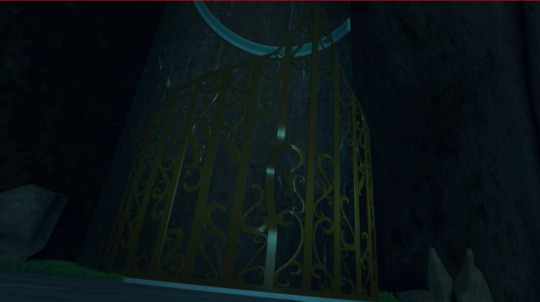

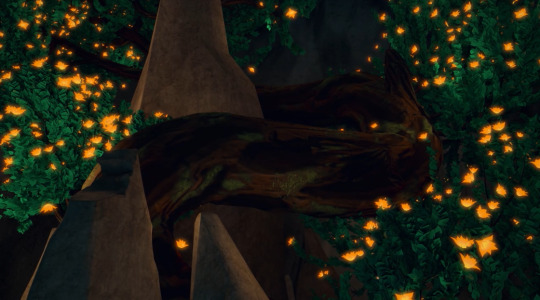
-THE SANCTUARY of the spring relic...which...Salem can just enter any time she wants apparently! Man, maiden powers AND a secret hideout, that’s awesome!

Hell, she can even invite FRIENDS inside! Just get some chairs, a TV and surround sound, you’ll have a chill pad!
Either way Cinder gives Neo the low-down about how Salem ordered Cinder to take Ruby alive NOT dead-ALL WHILE-

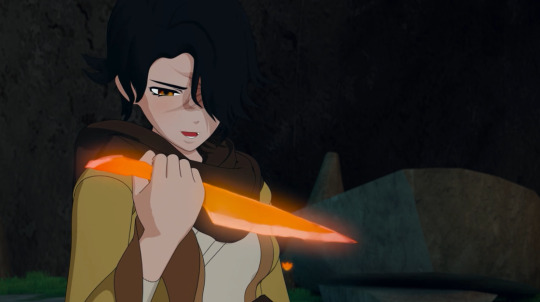


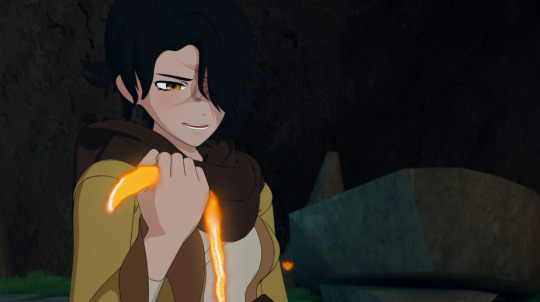
2:58 ...she...plays with her knife, like a total creep! I ain’t judging, we all gotta stim from time to time.
Anyway, Cinder tells Neo that while she can’t kill Ruby, NEO hasn’t taken ANYONE’S orders, and then the two become best murder friends forever!

Because we ALL KNOW how well the LAST time Cinder made a deal with a recurring antagonist...also holy crap Neo’s tiny, she’s like a murderous Felicity Smoak!
A THEN CUT TO-

3:38 THE BRIDGE FROM EVERY SAMURAI STORY! Don’t lie, you got Samurai Jack flashbacks to. It is HERE WE SEE-
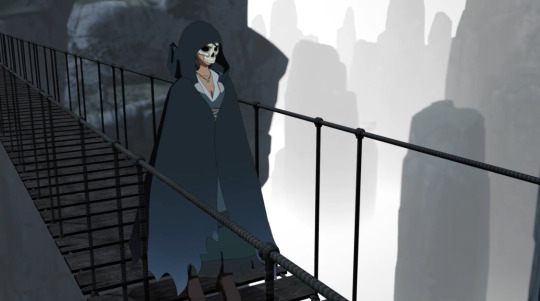

-absoLUTE cosplay bait! LOOK AT THAT-its glorious!
And you just KNOW what’s comin’ next folks-


4:20 ONE ON ONE MONSTER FIGHT BITCHES!
Maria starts out with a bridge back-flip-

THEN-does a gun-scythe-kama toss-
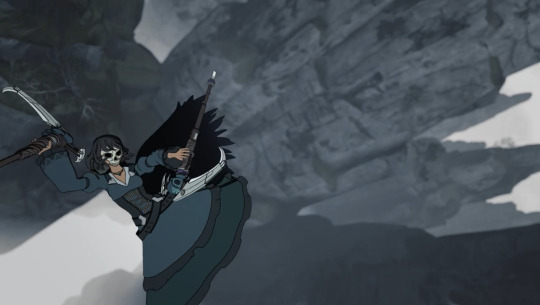
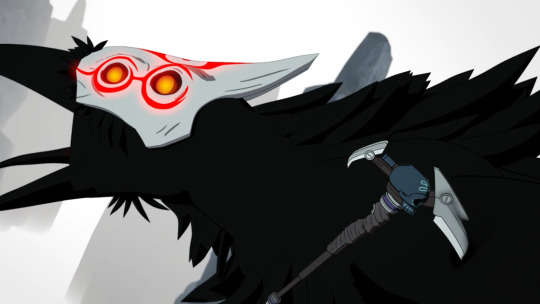
-AND LANDS THAT SHIT IN THE SHOULDER-but wait-THERE’S MORE!
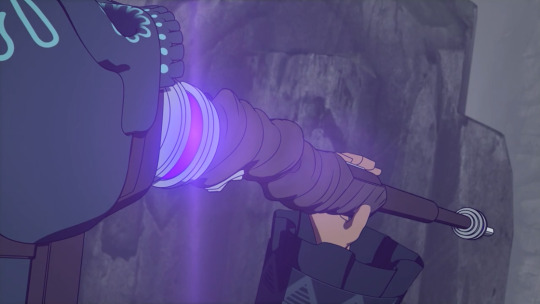
SHE FLICKS THE PURPLE SWITCH-oh Mauvisto we fear your dark power-WHICH TURNS OUT TO BE-
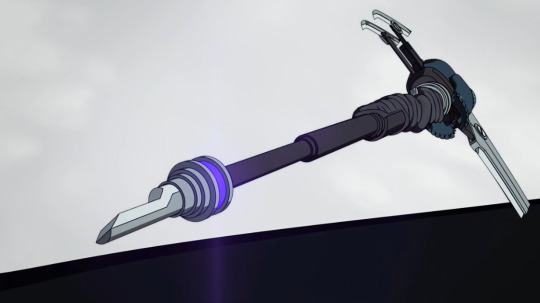
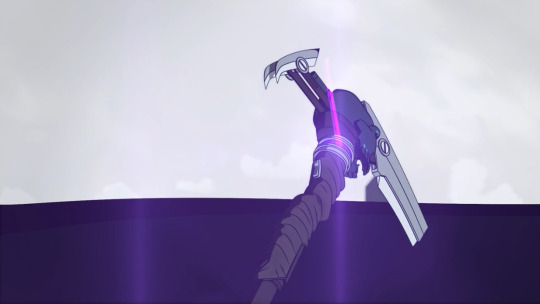
-MAGNETIIIIIIIIIIIIIIIIIIIIIIIIIIC SCYYYYYYYYYYYYYYYYYYTHES-bitch! Most likely due to gravity dust! She then uses it to FLOAT HER ASS up to the bird!
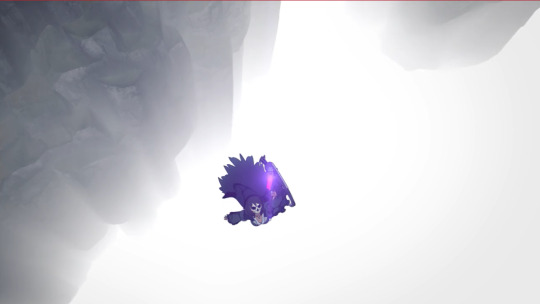

“I’M MARY POPPINS Y’ALL!”
She SPINS IN for a shoulder strike-
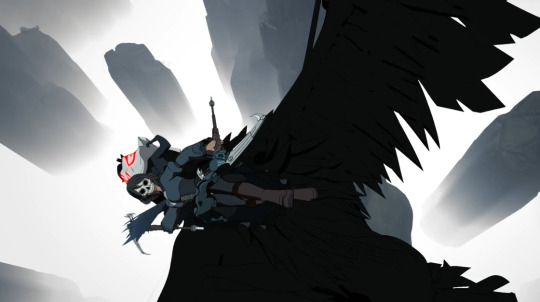

AND LANDS-in the shoulder! Lot of shoulder strikes with this bird.


She then steers it through the anime mountains-

THROWS-one of her kamas-IN THE MIDDLE OF THE AIR-

-creating what LOOKS like a fixed point of gravity-

-PULLS back her weapons forcing the bird into a quick-stop turn, STEERING THAT FUCKER-

-RIGHT INTO A MOUNTAIN! FUCK YES-pro Huntresses rule! She also LANDS that bitch-
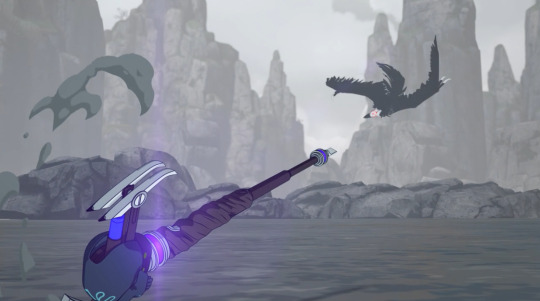
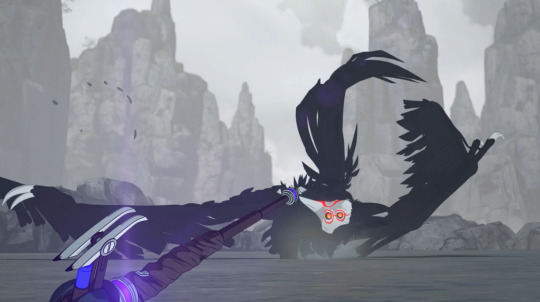
-RIGHT INTO A DITCH! RHYMING!
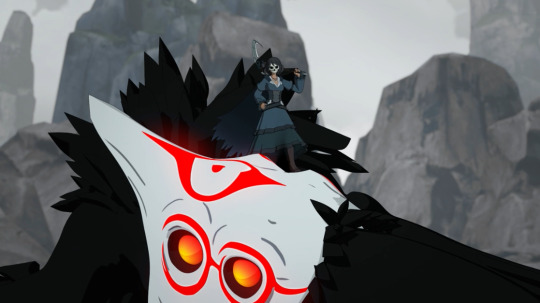
She then pulls one of her kmas out and everything is fine-OR IS IT?!
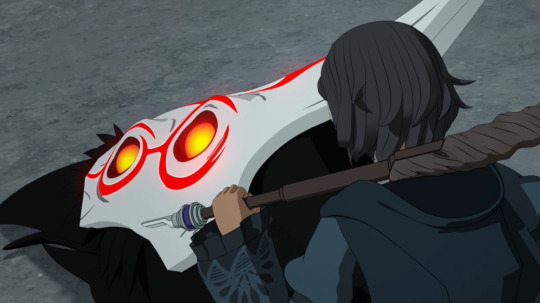
Nevermore: Hey.
Maria: Oh...hey.
Nevermore: Whatcha doin?
Maria: OH-I was just going to leave.
Nevermore: That’s nice, but how about I eat you instead?
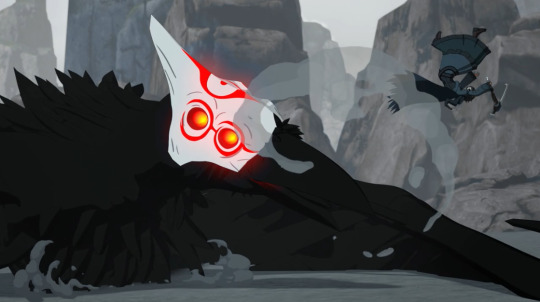
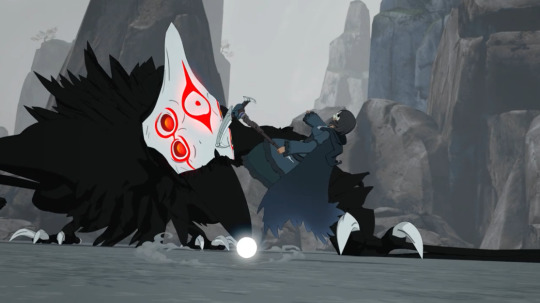
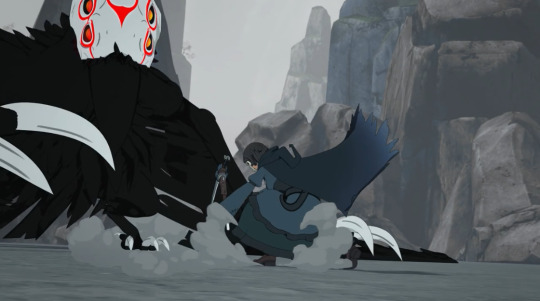
Maria tries zigging and zagging-BUT-

4:56 It knocks both her weapon-
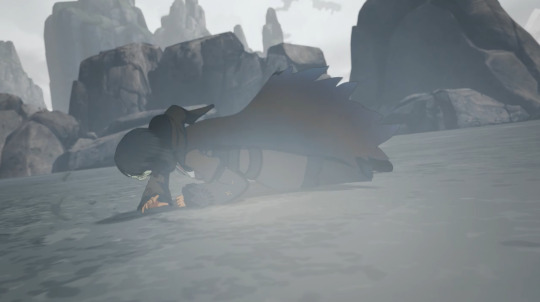
AS WELL AS HER! She’s only got ONE OPTION-



VAGUELY EXPLAINED MAGICAL SUPERPOWER GOOOOOOOOOOOOOOOOOOOOOOOOOOOOOOOO!


5:09 DAMN-petrified and then crumpled in MID-air!
After that kerfuffle, Maria than just goes on her merry way-

Tock: SURPRISE BITCH-I’m a crocodile!
We are then treated to one of the shortest...and MOST epic action exchanges of ALL time! Which starts out with THIS-
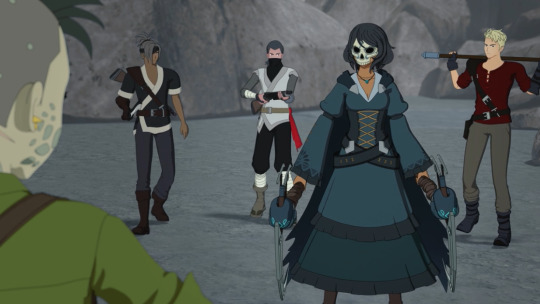
Maria: I don’t think you know who I am.
Tock: Course I do!
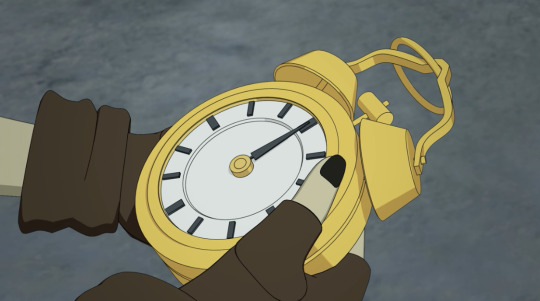
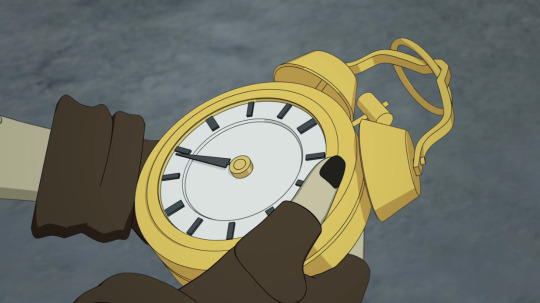

Clock: *Wiiiiiiiiiiiiiiiiiiiiind-DING!*




Tock: YOUR the Grim reaper!
AND YES-there are screws in her croco-teeth, don’t question it, its just awesome.

Tock: And THESE are the last 60 seconds of your life.
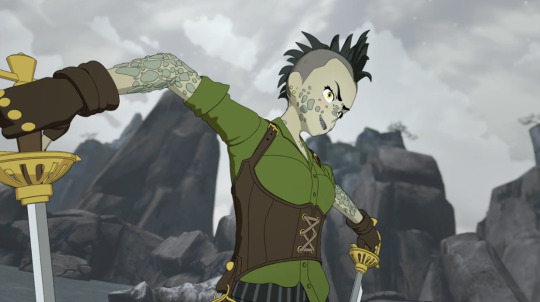
*SHING*
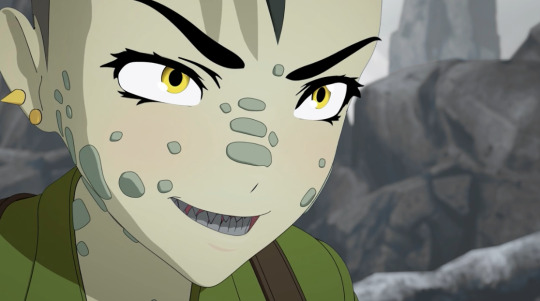

6:10*GLOOOOOOOOOOOOOOW*
And yes, the action scene ends exactly SIXTY seconds after she starts glowing, AS WELL as the clock stopping sixty seconds after it officially started and its absolutely brilliant-TO THE FIGHT-



6:13-Tock starts with a straightforward slash-BUT Grimm Reaper Maria blocks it like a boss-BUT-

6:16 -TOCK knocks away one of her mini-scythes-BUT MARIA-

-NOT ONLY gravetizes her other scythe back to her-

-BUT WHILE BLOCKING SHOTGUN CHARLIE-damn she was great in her prime. THEN-
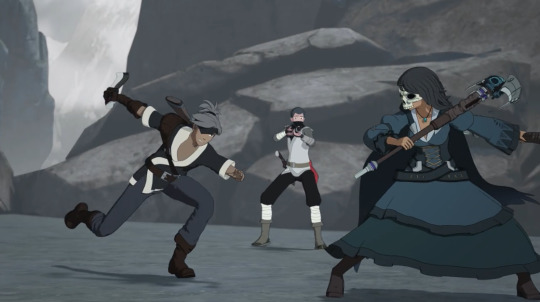
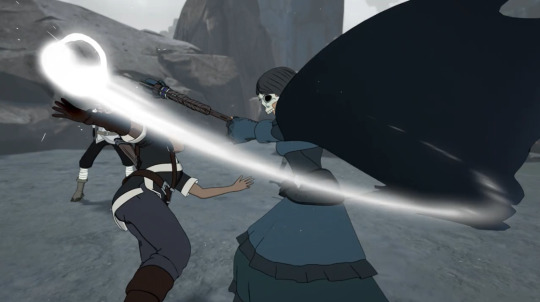
-she slashes Machete Jackson RIGHT in the face-

6:27 Knocks away BOTH of these punks-
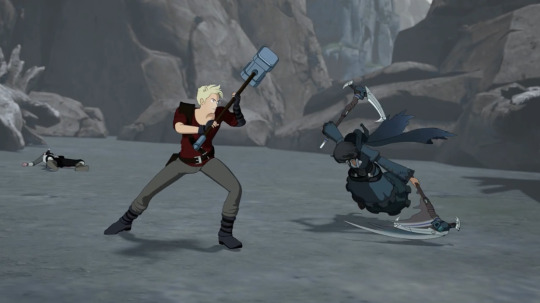

6:30 While knocking Hammer Armond down-LIKE A BOSS! BUT THEN-

6:31 TOCK comes in with the double slash, grinning like a mad woman.
Jackson and Tock get the jump on her, one zigs, the other zags, PROMPTING MARIA TO ACTIVATE-

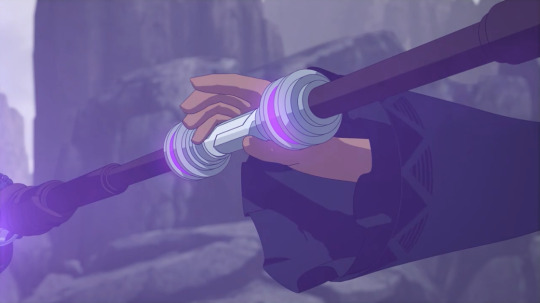
6:44 BO-STAFF MODE-now it has DOUBLE the attack power!
She goes in striking Jackson-
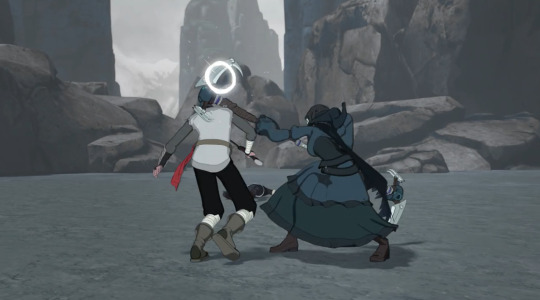
-BUT TOCK-gets up close and personal-

6:47
And in a SPLIT second-
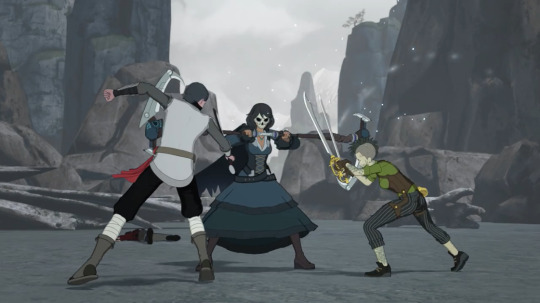
JACKSON’S back up and tag-teams Maria with Tock...wait, not like that.
Maria knocks back Jackson again, she zigs, Tock zags, LOTSA ZIGGING AND ZAGGIN UP IN THIS
ALL THE WHILE-the same tick-tick ticking is going on-OOOH-its like a Venture bros scene!
Maria looks like she’s got the upper hand-BUT TOCK-
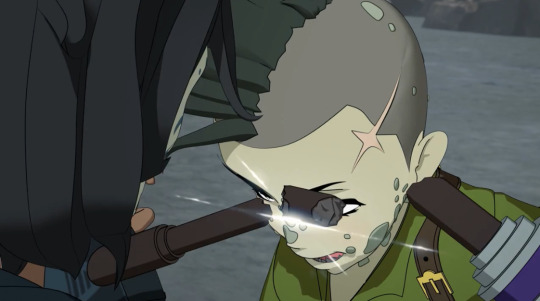
6:56 BITES THE FUCK THROUGH her battle staff-
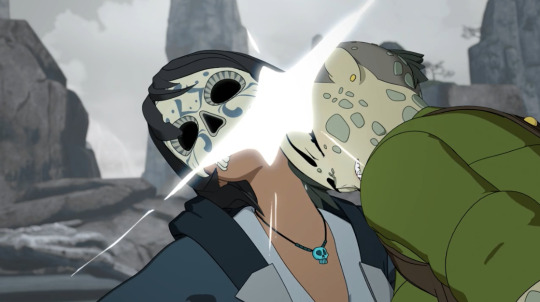
6:57 HEADBUTTS AWAY-her mask-
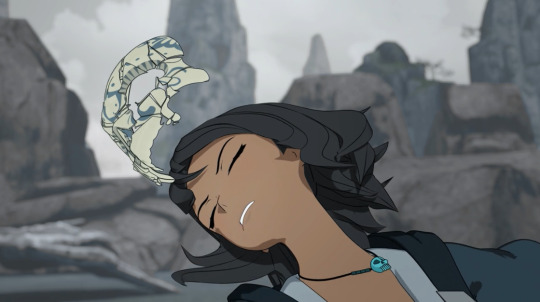
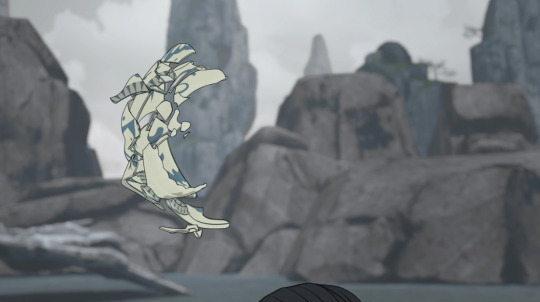
-where it SHATTERS in mid-air, holy SHIT! ALSO-Maria is pretty-HUZZAH!
Either way this LEADS TOCK-
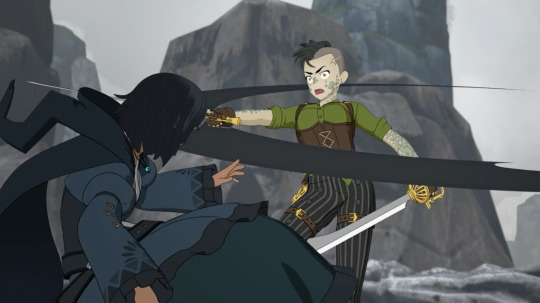
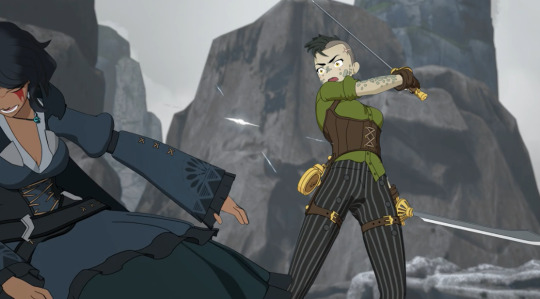
7:01 -to slash her GOD DAMNED eyes open! All. Within. 60. SECONDS! HOLY SHIT!
Tock high off her victory then starts gloating to the no de-eyed Grimm reaper, mocking her as weak while Maria blindly shoots her gun-scythes-WHILE ALSO-
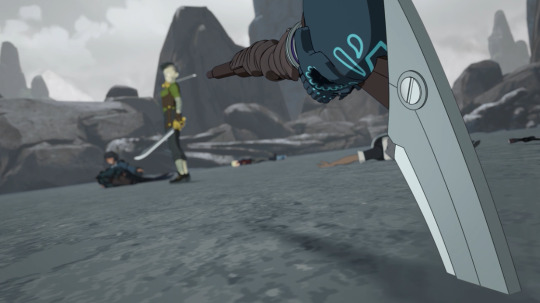
-throwing one of her weapons behind her, which Tock isn’t worried about at all...for some reason.

*CLICK*


*KER-SLASH* Dead...presumably.
Never doubt the power of purple folks.
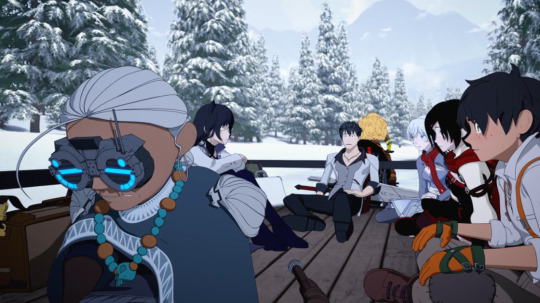
8:04 FLASH FORWARD to the present, where everyone in the cart being pulled by a SINGLE motorcycle deals with the fact that they were travelling with THE Grimm Reaper this whole time. Seriously Qrow straight up geeks out a little to, admitting he based his scythe on her weapon...well...just the scythe apparently, also his gun is more of a shot-gun where as hers seemed more like glocks AH whatever.
Maria than gives herself a BIG OLD pity party, mentioning that even after she got her new fancy robot eyes she couldn’t bare to go back out into the field, fearing the danger that comes with battle and...I KNOW she’s clearly going to be Ruby’s mentor, but I ALSO hope she bonds with Yang as well, as holy SHIT she’s similar to Yang.
Both lost appendages during battle, both had said appendages replaced with mechanical accouterments, and BOTH are hilarious! HELL for wall we know Maria also had an almost-girlfriend who ran out on her, another almost girlfriend who got shipped off to Narnia, and a little sister who kept battling because CRIME!
Hell, she PRACTICALLY acknowledges it-
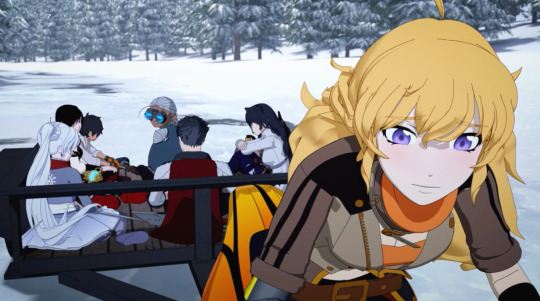
9:11 Maria: Because some of you are clearly stronger than me all ready.
Yang: *Sad ephiphany face*.
DAMN am I glad she’s part of the group!
After Maria avoids Ruby’s plea to train her to use her magical Grimm zapping super eyes-WE GETS A SCROLL CALL-
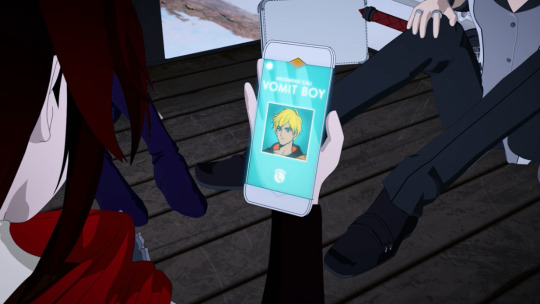
Jaune: OH MY GOD I WAS SO WORRIED ABOUT YOU ARE YOU ALIVE?!
Ruby: I answered the SCROLL Jaune, the answer is clearly yes.
Jaune: I just miss my friends.
-INFORMING THEM ALL-that they are RIGHT CLOSE TO-

10:20 BASINGSE-I mean-THE WALLED CITY OF ELDIA-wait not...ARGUS-yeah Argus! But FIRST Team RWBYQOM needs to FACE-

-THE STEEPEST HILL ON THE FACE OF THE PLANET! I mean...LOOK AT THAT THING-its huge! Also I love the design of the trees and the grass, its just beautiful!
BUT-through the magic of television-
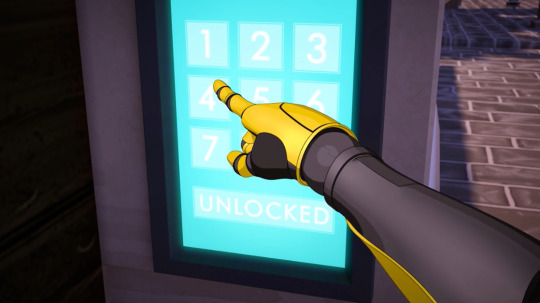

-THEY’RE ALL READY THERE! Seriously I bet it took them like TWO hours inching down that path. I know construction is always lax in Remnant due to Grimm attacks, but someone NEEDS to make that path safer!
But enough about that-BEHOLD-

-THIS CASTLE WALL-with lots of armed guards on the top! No Titan is gonna sneak up on the city on THEIR watch!
But enough abou that-ITS HUG TIME:


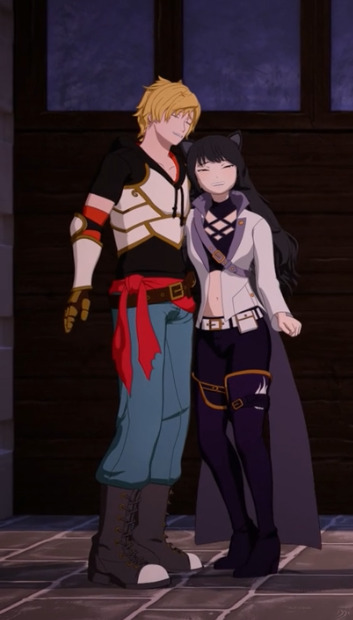
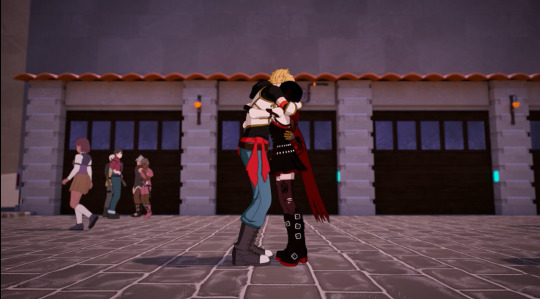
And a billion shippers hearts, just exploded.
After the love fest, we get-ARGUS SCENERY THROUGH WORLD-BUILDING:
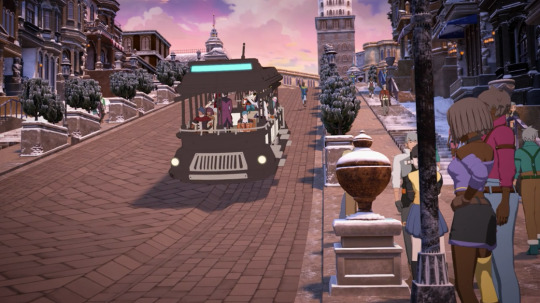
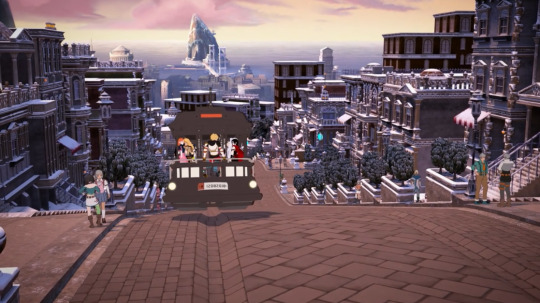
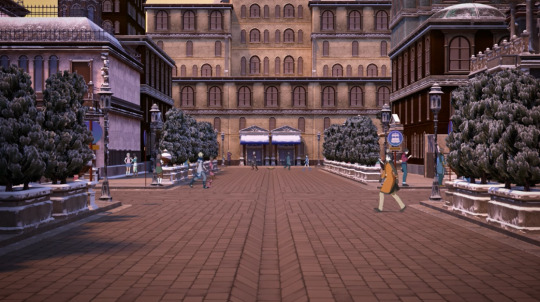
Look at all this, Rooster Teeth’s background budget got WAY bank and they are FLAUNTING that wealth!


This Objects and Oddities lady is my favorite, she’s just SO pissed off, I wander why?
We also see-
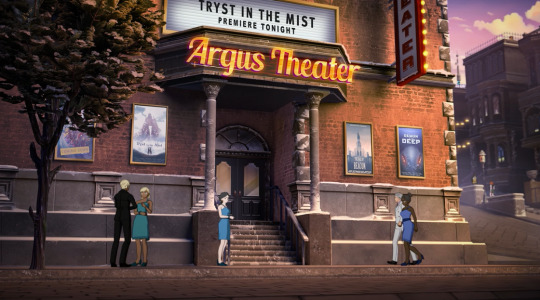
-A MOVIE THEATER-showing such brand spanking new films, INCLUDING-

TRYST IN THE MIST-a raunchy tale about a romantic affair that takes place IN THE MIST! Given 4 stars by “Incredibly specific affair based movie” monthly!

...a...MOVIE within a movie apparently...weird.
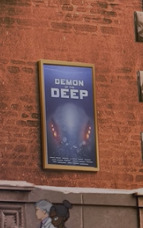
DEMON IN THE DEEP-one of several monster movies that SOMEHOW exist on Earth-RWBY. I’m just saying, with all the REAL monster attacks, wouldn’t monster movies seem insensitive? SPEAKING of insensitive-
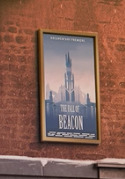
THE FALL...of Beacon...I know I’m not the first to say this but too soooooooooooooooooooooooooooooooooooooooooooooooooooooooon.
So bla bla bla, Argus was made to promote trade between kingdoms, bla bla bla, Atlas military has all but abandoned it bla bla bla-LET’S MEET JAUNE’S SISTER!
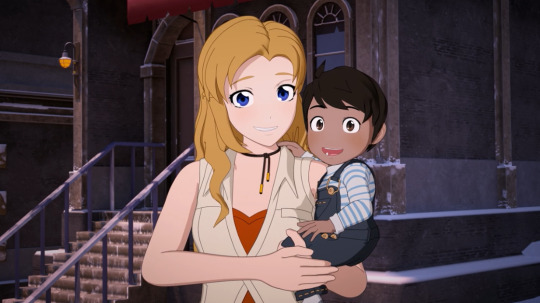
LOOK AT HER! FEEL-her youthful and adorable mom energy!
And the REST of the episode is PRETTY MUCH just an assortment of adorable images.
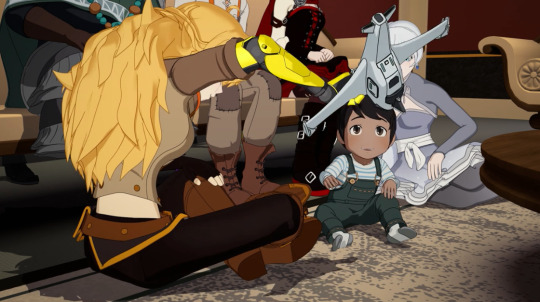
Yang playing airplane with baby Adrien(THE CUTENESS).

THE THREE ARMED-flopping Jaune-IN ALL of its glory!
AN INSULTED BOY-
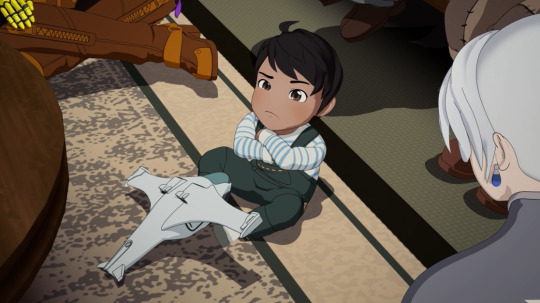
12:56 -and the women who adore him-

AND ALL THE ARC SIBLINGS:

Okay I don’t know HOW many fan-artists are left on Tumblr due to the incoming purge, but I want some ADORABLE web-comics based on this STAT! LOOK AT MINI-JAUNE-he’s so CUTE! And just when you things couldn’t get ANY better-

13:22
Sapphron: Everyone, this is my wife Terra Cotta.
BAM-twenty gay-TEEN mother fuckers!

SUBTLE-Renora sandwich time! Look at these two, YOUNG LOVE mother fuckers!
But more importantly Terra asks THE REAL questions-
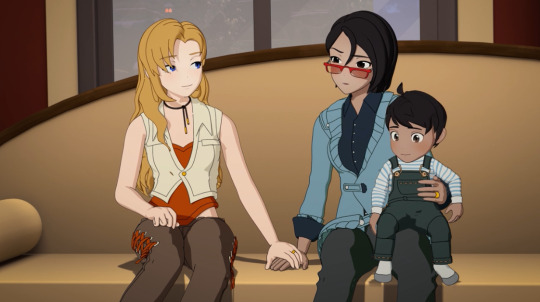
Terra: Is that (Bringing students along on dangerous Huntsman missions) even legal?
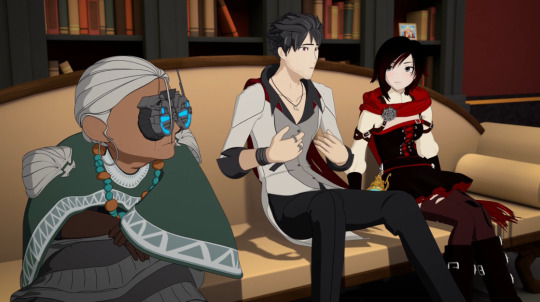
Qrow: Er, uh, of course!
And I just...LOVE that both Maria and Ruby have the exact same looks on their faces, their both thinking “The closest thing we have to a real chaperone is a bipolar alcoholic...this is what my life has become”.
After a nice little sandwich lunch, and learning that Terra Cotta-Arc is a hardworking radio engineer being unjustly accused of bad mistakes(if there’s ANYONE to blame its Lionheart), while team RWBY decides the best way to GO to Atlas is with the LOCAL MILITARY BASE-which I’m sure will accept them with OPEN AR-

SLAM
Ooooooooooooooooooor not. Hey, its only HALF way through the season, they gots PLENTY of time!
SUMMATION-this easily had one of the BEST action sequences of the ENTIRE season, the backgrounds were BEAUTIFUL and there were just so many cute scenes-TEN OUT OF TEN for me! AND WITH THAT-that’s the end of MICKSTERECAP-if you liked what you read, message me if you want to donate to my Paypal or Ko-Fi. With that I will see you NEXT WEEK-on Mick the Nerd’s a.k.a. Yoshimickster’s MICKSTERECAP! Sorry this one was a bit late!
#rwby#rwby volume 6#rooster teeth#vrv#ruby rose#weiss schnee#blake belladonna#yang xiao long#qrow branwen#maria calavera#the grimm reaper#jaune arc#lie ren#nora valkyrie#saffron cotta-arc#terra cotta-arc#adrien cotta-arc#tock#rwby tock#tock rwby#remnant#rwby spoilers#rwby volume 6 spoilers#rwby the grimm reaper#rooster teeth spoilers#rooster teeth first spoilers
90 notes
·
View notes
Video
youtube
ISBM on going exam answer sheets provided whatsapp 9924764558
INTERNATIONAL MANAGEMENT ISBM ONGOING EXAM ANSWER SHEETS PROVIDED WHATSAPP 91 9924764558
CONTACT
DR. PRASANTH BE MBA PH.D. MOBILE / WHATSAPP: +91 9924764558 OR +91 9447965521 EMAIL: [email protected] WEBSITE: www.casestudyandprojectreports.com
INTERNATIONAL MANAGEMENT Total Marks: 80 Note : All Questions are Compulsory Each Question Carries Equal Marks CASE STUDY : 1 (20 Marks) Zhuhai of Shanghai “I’m not sure whether they understand that a firm cannot he a bundle of discreet businesses. Most of the senior Chinese executives I talk to arc convinced that they can make anything . . . absolutely anything that will make money. After so many years of command economy, managers are oblivious to the concept of market ……they aren’t keen to get into bilateral trading even when it makes sense. They would rather pursue different ventures totally unrelated to each other,” said a financial analyst of an American brokerage firm located in Shanghai. Mr. Dong Hong is the president of Zhuhai To Zi Company (Zuhai) which was founded in 1980 as a construction company. Before joining the company in 1989, Hong was a high ranking army officer in the People’s Republic of China. As president of Zhuhai, he attended an executive management programme at Harvard Business School. Although Hong enjoyed the programme, he came back with some reservations about the relevance of what he learned. One of his oft-repeated summation of the programme was: “I have problem with the terms like core competency and synergy. At this point in time, there are ample opportunities in China to make good return in any business. You don’t mean to say that we simply stick to the knitting and pass these opportunities to others? China is a virgin land, you need to understand that.” HISTORY OF SGL Zhuhai has received a favorable media splash in China upon its taking a controlling interest of Shanghai Gue Za Liao Company (SGL), a poly-crystal manufacturer. SGL was founded in 1969. At that time, it was the largest manufacturer of poly-crystal in China employing 900 people. It received quality awards for six consecutive years. In 1992, SGL was authorized by the Shanghai Municipal Government to become a joint stock company. In less than 15 days, it sold RMB ¥(yen) 1.1 million worth of stock at RMB ¥22.00 per stock (¥10 par value) to the public and to the employees of the firm. The registered capital was RMB ¥33.799 after the fund raising. The Government owned RMB ¥18.799 million worth of stock. The stock was floated through the Shanghai Securities Exchange Centre. In 1993, the market price per stock was RMB ¥l8.79, with a price of RMB ¥7.85 at its lowest point. By being a listed company, SGL cased its cash flow problems but the rate of return was getting depressingly low and its market share went down from 51 per cent in 1970 to 36 per cent in 1993. MANUFACTURING TECHNOLOGY OF POLY-CRYSTAL Poly-crystal is a crystalline specimen which contains many small individual crystals. There are different methods of making this product. The most common and widely used method is called Chemical Vapour Disposition or CVP. In this process, the material to be crystallised is vaporised in a chamber and then condensed on a substrate to form crystals. Silicon crystals are mostly used in semiconductor (i.e., computer chips) and solar power applications for their unique properties and inexpensive raw materials (mainly sand). Though it is not a labour-intensive process, it requires rather sophisticated technical skills. The electronic industry in the developed countries produces its own crystals. IBM, RCA, Motorola, and Texas Instruments are the major producers of crystals in the U.S. Application of semiconductors and use of photovoltaic cells will continue to rise, and with it the demand for poly-crystal is expected to increase. OPERATIONAL EFFICIENCY OF SGL Since China started allowing imports, SGL’s market share had shrunk for a combination of reasons. First was the slow rate of growth of Chinese electronic industry where poly-crystal is mostly used. Second was that imports had been consistently of high quality which SGL could not match due to lack of skilled labour and obsolete technology. Third was the ever-increasing costs of power and raw materials contributing much to increasing cost per unit of production. Pricewise, SGL could not compete with the major importers from the U.S., Russia, Ukraine, and Germany inspite of the fact that the labour rate in China is about one-third of the U.S. and Germany. In 1994, SQL sold 34 tons of polycrystal where the total domestic demand was estimated to be about 105 tons. In an attempt to diversify the company, the board of directors decided to get into the taxi business as the city experienced a surge in the tourist market. As of 1994, Shanghai had about 35,000 taxis. A taxi owner typically receives V300 per day per taxi irrespective of the driver’s earnings. The driver makes on an average about V150 to 200 each day but he is responsible for buying gas and paying for repairs of any mechanical defects. In addition, he has to pay the police for any traffic violation. The time SGL entered this market, the Chinese banks eased their lending process allowing many of the existing drivers to buy their own taxis with easy repayment schedules. This had the salutary effect, for SQL, of not finding enough “qualified” drivers without lowering the owner’s usual income of 300 per day. Managing this line of business was becoming a headache. SGL asked several of its managers to move into the taxi-sector. Some of them flatly refused and a few accepted the assignment grudgingly. SQL, though doing poorly both in crystal and taxi business, did not lay-off employees or reduce their benefits. SGL’s top management thought that the company had gone as far as possible with its restructuring efforts and decided to be taken over either by a foreign or a domestic firm. It also tried in vain to form alliances. In April 1994, the Government decided to sell its RMB Vl2 million worth of stock of SGL to Zhuhai To Zi company, making it the largest stock holder holding 35.5 per cent of the entire stock. Immediately after the takeover, Zhuhai asked SGL to produce quartz glass for a particular Japanese company. The outsourcing attempt by this Japanese firm to SQL lasted about a year as it was not satisfied with the variance in quality and delivery schedule. With the available technology of SGL, Zhuhai decided to get into manufacturing electric energy meters for state-owned facilities. These stateowned operations had been the major customer base for SGL’ s poly-crystal. Working with the similar customer base, SGL started to make money with its energy meters. The two business segments, real estate and the energy meters, contributed much of Zhuhai’s net return of 15 per cent, providing an overall liquidity ratio of 2.7 per cent and a quick ratio of 1.94. The financial position of Zhuhai is provided in the Table 1.below RESTRUCTURING OF ZHUHAI The president of Zhuhai restructured the company making each division a separate strategic business unit (SBU). The revised organisation structure is provided below. Note that the positions immediately below the unit vice presidents and under them there were a cadre of personnel doing various jobs as directed by their bosses. Mr. Hong made it clear to all SBU vice presidents (VPs) that decisions regarding product development, pricing, procurement and human resource management would be taken by the president himself in consultation with the board of directors. Mr. Hong stated in a recent meeting that the VPs were responsible for making at least 20 per cent rate of return for their units. “Lower than 20 per cent will mean either demotion or transfer for that particular VP”, he said. “We have started making short cuts, saving money in every possible way.... but I’m not sure whether any strategic business unit can function without strategy. Just a promise of fixed rate of return at the end of the year? Is that all in the name of strategy?”, asked the vice president of an SBU. Question : 1) Discuss the typicality’s of Chinese Industrial system vis-à-vis the Western/global Industrial system. 2) Where does the Chinese system fault? 3) Is over production and mis-match in marketing leads to poor prices of Chinese products in the International market? 4) If you are offered, views as a top consultant, what would you like to suggest the Chinese Government and industry. Give your reasons. Case-2 (20 Marks) Toyota Comes to Georgetown Mrs. Friers, in her early sixties, of Georgetown’s new Wal-Mart store cannot be anything but polite when she discusses Toyota. In a low voice to my companion, the doctor at the local Scott County General Hospital, Friers said, “You know Doe, Toyota did not offer that job to my daughter.” “I am sorry to hear that,” the Doctor commented casually. “Are you all glad that Toyota came to town?” I asked Mrs. Friers, somewhat to fill the void. “Yes and no ... we were all excited when they first announced it . . . it kind of sank in now, I guess.” Toyota’s labour practices was the hot topic at the local drug store too. A middle aged man, who had worked in an iron foundry for 31 years, commented, “In Toyota you have to earn every penny . . . there is never a slag . . . never the time to say hello.” His youngest son, Dwayne, is currently employed in the Toyota plant. He is extremely pleased that the company has abandoned the practice of workout in the morning. A skeptical Baptist preacher asked, “what the heck have we got because of Toyota? Most of their people come from Indiana and Ohio. I hear some of them even commute from Arkansas.” TOYOTA COMES TO GEORGETOWN Georgetown, about 25 miles south of Lexington, Kentucky is the Scott County’s heartland. The county’s population is 25,000 out of which 22,000 are white. Over 53 per cent of the household income is between $15,000 to $49,999 per year. It has 93.7 males for every 100 females. About 43 per cent of the population are between the ages of 18 to 44 years. It was a puzzle to many residents as to why Toyota selected this sleepy town for their new venture. Some of them argued that the then Governor of the State, Martha Lay Collins, charmed the Japanese so much that they lost their way and their heads too. Some others contended that the State made huge tax concessions to the company and wrote blank checks. The local paper cashed in by printing all possible undocumented stories about Toyota. However the present Mayor of Georgetown denied charges of any underhanded deal. He rationalized the process of selection thus: Toyota selected this location mainly to take advantage of the transportation network of 1-75 (North and South) and 1-64 (East and West). He added, “the topography of the land here is very similar to the land around the Toyota City in Japan. I assume the company was also attracted because of non-union focus in this State.” The original plant location was about three miles outside the Georgetown city limit. The office of the Mayor made it clear to the Toyota people that since the city was the closest municipality it would end up providing most of the infrastructural services to the plant but without any return from Toyota. Why should the taxpayers of Georgetown accept this liability without any tax revenue coming from the company? The company’s vice-president had asked the Mayor to attend a series of breakfast meeting with him and other officials to sort out this and other related problems. The Mayor described the outcome of these meetings thus: “We were aware that this was a huge economic development opportunity but was also conscious of the fact that the town people should not be shortchanged in any shape or manner.” In April 1987, Toyota confirmed the setting up of the plant in Georgetown. TOYOTA’S OPERATIONS In May 1988, the first Kentucky Camry was introduced at a plantwide celebration. And in the same year, Camry received the J.D. Power Gold Plant Quality Award. In November 1988, Toyota announced plans to double the plant size and production at the Georgetown plant. In September 1991, Toyota unveiled a major model redesign for the year 1992. In January 1992, Toyota announced plans to expand Powertrain Plant to add V-6 productions. By March, the production of Camry Wagon began. In September 1994, the Georgetown plant began production of the Avalon, a new large sedan aimed at the North American market. In 1988, Toyota was able to produce about 200,000 Camry Sedans of which 20 per cent were exported. In 1995, it doubled the production to 400,000 with the hope of exporting 20 per cent to Taiwan, Europe and Japan. With this tremendous pace of change, the company demanded from its workforce nothing short of total dedication. The pace became such that the workers started using “Kaizen”, “Kieretsu”, “Kanban” and few other similar Japanese phrases even in dealing with their own family members. In 1995, the employees were told that since the sales had declined by 2.5 per cent, the process had to he streamlined, using fewer model variations and increasing white-collar productivity. An assembly line worker said, “Gosh, how could any more speed be achieved without killing each other . . . but this is Toyota. Find a way to do it . . . or a way out.” THE GAINS AND THE BARGAINS Toyota’s direct employment in the U.S., as of December 1993 was 16,674. including the 1438 Toyota/Lexus dealers, the company employs over 90,000 people in the U.S. In Georgetown alone, it employs 6000 people representing all 120 counties of the State of Kentucky. What Kentucky gained from Toyota is a question that ninny people ask. For instance, the company was provided with an incentive package of $325 million. Out of this amount, $68 million was paid for job training, and $40 million went to building roads and sewers. Toyota operates under the Free Trade Zone which provides tariff exemption of $14 million a year. The company was allowed to import parts and machinery without paying any additional tariffs. The State paid $167.6 million interest costs for its warehousing distribution. The balance sheet predicts that the Camry plant could generate $673.4 million in state tax revenue including individual and sales taxes. Further, due to Toyota’s plant expansion there will be a whole host of satellite industries around the area with vast potential for job opportunities. Estimates suggest that the Camry plant and its suppliers based in the State have already created 22,000 jobs in Kentucky. OTHER STATES FOLLOW LEAD The State of Tennessee, in order to bring in Nissan, convinced the Federal Government to approve $5 million-a-year tax break on plant expansion (production expanded from 250,000 to 450,000), and allowed it to operate under the Free Trade Zone as Kentucky did for Toyota. The State of South Carolina in its effort to get BMW also had to provide $5 million in state income tax credits and an additional $3 million for employee training. The State wl1 set the BMW’s property taxes at the same rate for 5 years at a time and extend the Zone on Greenville-Spartan airport. This venture estimates 10,000 additional jobs in the region including about 2,000 at the BMW location itself. According to his estimate, the State will benefit by $28 million a year in taxes. The latest in this league of getting large employers is the State of Alabama. Mercedes Benz has accepted we location to manufacture under the following conditions: the State will provide $92 million for site development, $77 million for infrastructure, $60 million for job training, and $8.6 million for sales and tax concessions on equipment. The State also made a good faith commitment to buy from the company, 2,500 vehicles at an estimated price of $75 million. Mercedes will employ 1,500 people and it expects a mushrooming of industries around the plant site. TOYOTA TRIES TO BE A GOOD CITIZEN From the day of inception. Toyota officials insisted that the company should be a part of the community. For instance, it cited the following contributions: $1 million for the citizens of Scott County to build a community centre, $15 million over a 20 year period to the County school system; $141,000 to develop a child care centre; $500,000 for the development of a Thoroughbred Park; $25,000 and $30,000 to the Lexington’s Children’s Museum and Philharmonic respectively. The city of Georgetown receives one per cent of the payroll tax and an additional percentage of the net profit of sales. The city’s general fund budget went up to $6.7 million in 1992 from a mere $2.2 million in earlier years. This allowed the city to extend its police force and add a fire station. Fire insurance rating for the city went sown from class 6 to class 4, resulting in savings of about $500,000 a year in insurance costs for the homeowners. Although Toyota has never agreed to give preferential treatment in employing Kentuckians or people from Georgetown, the mix at the shop floor level suggests that over 80 per cent of them are not residents of the county. At the managerial level, the Japanese are in charge of production control,’ purchasing, finance, engineering, and quality control functions. The president is also a Japanese national. The U.S. personnel occupy the positions of senior vicepresident, human resources, public affairs, and vehicle assembly production. A majority of managerial and supervisory staff live in Lexington and Louisville (Kentucky), and Cincinnati (Ohio). GEORGETOWN ON THE MAP Has Toyota not been the single most important factor to bring prominence to this area? The existence of two interstate highways 1-64 and 1-75 was what had attracted Toyota to Georgetown. Yet these two highways contributed negatively by moving people away, towards bigger cities like Lexington, Kentucky and Cincinnati, Ohio. Lexington and Cincinnati, for example, have better schools, shopping centres, cultural activities, and have legal liquor sales. The Director of Georgetown-Scott County Planning Commission notes, “the originally anticipated large increase in population has not occurred . . . and is not anticipated to rise substantially beyond the normal growth for a community of our size.” The Director agreed that traffic had dramatically increased since Toyota’s arrival and this was much to the annoyance of the local people. But on the plus side, he claims, the local schools have benefited from the company’s contributions. To Mrs. Friers and many others, the presence of Toyota has added to their frustration. They are angry and dismayed since the plant has changed their way of life. They feel that the way life was in Georgetown will never to be back, and they do not know how to fill the void they now experience. One of them aptly summarized the feeling of others thus: “we now see lots of new faces, and we don’t know where they come from, where they arc going. But they seem to leave us at night to guard this divided city—that’s the new city where Toyota is . . Japanese money, fancy cars, fast foods. The other city is where we folks are—still chewing our deep-fried catfish and spoon bread while recalling the long list of small mom and pop shops which used to be on the main street that are now being sucked up by the winds of the Wal-Marts and the Krogers of the new world. Do we have to destroy the yesteryears to get to the year 2000? There used to be a word called co-existen de. I guess, we don’t care what it means any more!” Questions 1. What is the difference between American production policy and Japanese production policy? 2. Where the Japanese Excel? 3. In quality control of Toyota what do you observe? 4. Can Japanese, be really leader in auto production and marketing, all over the world? Justify your moves. Case -3 (20 Marks) How to Win at Westinghouse Westinghouse founded the Westinghouse Electric Company in 1886, over 100 years ago. From the beginning, the hallmark of the company was one of entrepreneurship and creativity. By inventing a new for tr3nsmitting electric current over long distances, the firm penetrated the fledgling electric industry. Its aptitude for technological innovation led the firm into the development and creation of diverse products, from household appliances to watches to nuclear power equipment. The firm also demonstrated creative diversity, branching into such endeavours as radio station operations, softdrink bottling, and low income housing Today, the Westinghouse Corporation is organized into six operational groups broadcasting, commercial, electronics systems, energy and utility systems, financial services, and industries. As Westinghouse grew and began its expansion into foreign markets, it became apparent that the firm’s organisational structures and communication systems would have to be modernized to provide the flexibility demanded by overseas operations. Rigid procedures and red tape had to be eliminated, and ways had to be developed, by which key employees around the world could communicate with each other rapidly, so that their giant company could adequately react to changing conditions around the world. To meet this communication support challenge, Westinghouse established a change-responsive high-tech communication network to support its far-flung operations. A new commuter system allows employees at all levels of the corporation to communicate through decentralized support networks. Westinghouse employees from different divisions and different departments can link-up in order to share information around the world. The new support system, called the Westinghouse Information Network (WIN), links more than 600 Westinghouse facilities, providing both voice and data transmissions as well as an electronic mail system. Westinghouse employees can link WIN to their homes or to their lap-tops when travelling. WIN offers videoconferencing, which reduces or eliminates the need for costly and time-consuming travel to meetings. WIN also contains an advanced negotiation system, called EDGE, which supports sales personnel during complex sales negotiations. Every working day, over 90000 Westinghouse employees utilize the WIN system, which provides the flexible on-line support that Westinghouse needs to expand its global enterprises. (16). QUESTIONS 1. Describe the ways in which international business has an impact on your life. 2. Pick an Indian corporation with which you are familiar and analyse the reasons why it might be motivated to expand its internationalism. 3. What sorts of adjustments might McDonald’s have to make in its operations in India? 4. What do you believe India must do to improve its international competitiveness? 5. How do you perceive your managerial career will have an impact by the phenomenon of international business? Case-4 (20 Marks) Doing Business with the East—Motorola Style When Motorola decided to do business with the East, it was done in a big way. Motorola has penetrated virtually every niche in Asia’s booming telecommunication and semiconductor markets. It’s Asian strategy has already accounted for 13 new factories in nine countries. Its dynamic growth in Asia is exemplified by Tam Chung Ding, President of Motorola’s Asia-Pacific semiconductor division. His office is located in Motorola’s now $400 million Silicon Harbour complex with a grand view of the Hong Kong harbour. Motorola leans heavily on Turns instincts and his aggressive leadership style. Tam’s division is one of the most profitable and fastest-growing of Motorola’s far-flung industrial empire. In 1990, Motorola’s chip sales in non-Japan Asia rose by 20 per cent to $528 million, making it the world’s third largest chip producer. Motorola is also Asia’s top supplier of top-of-the-line walkietalkies and digital cordless telephones. The East is critical for Motorola, as Asian sales—outside Japan—total more than $1 billion per year— almost 10 per cent of Motorola’s total sales. Motorola has long recognised the potential of Asia. It began dabbling in Asian business in the early 1960s, when it established sales agencies in Tokyo and Hong Kong. A decade ago, Motorola split up its Asian semiconductor headquarters in Tokyo, locating the office for its non-Japan Asian business to Hong Kong under the charge of Mr. Tam. For years, Motorola had complained about Japanese trade barriers to no avail. Then in 1987, it formed an alliance with Toshiba. The two formed a successful chip-manufacturing joint venture, with Toshiba providing essential marketing services. In 1990, Toshiba executive Isamu Kuru joined Motorola after serving Toshiba for 28 years. Mr. Kuru provides the necessary insight and understanding necessary to guide the Motorola’s Japanese operations. Other notable Motorola successes have been recorded in India, Australia, Singapore, China, and South Korea. However, the latter two ventures have been serious challenges. In June of 1992, Motorola broke ground for a new $120 million semiconductor plant in Tianjin, a Chinese port city near Beijing. It will be the first U.S. semiconductor plant in China. In addition to making semiconductors, the new plant will produce telephone pagers, mobile telephones, and electronic equipment for automobiles. Many observers believe that such an investment, coming so soon after the Tiananmen Square disaster, is far too risky. Motorola is willing to take that risk, believing that China holds the key to future competitiveness in Asia. Hovever, to test those Chinese waters, while the new plant was just starting construction, Motorola opened a make-shift plant—also in Tianjin—to build the first of its paging devices. Originally, Motorola assumed that the local demand for pagers would be so small that it would have to export a large share of production. However, the plant now produces 10,000 units each week, and the entire output is sold in China, with each pager selling for $200. Experts indicate that the Chinese demand for pagers has risen from 1 million in 1991 to 4 million in 1993. With the make-shift plant performing well, the new plant scheduled to begin production by the end of 1993, and a second new plant planned for the near future, Motorola’s competitive position in China seems to be on a sound footing. Motorola had more serious difficulties with its “Motorola Korea”, Limited venture, especially with respect to labour problems. At first, the well-educated, hard-working Korean workforce seemed to be ideal for Motorola’s needs. However, in the late 1980s, Korean labour became disenchanted with long working hours, low pay, and poor working conditions. Noting the growing riches of the Chaebols, the working class wanted a greater piece of the economic pie. Thousands of Korean workers took to the streets in massive demonstrations, demanding economic reforms and the right to form labour unions. Motorola’s first taste of trouble co” when 34 of its more than 3,800 Korean workers petitioned the Korean government for the right to organise a union. Motorola has held a long-standing policy against the unionisation of its workers and refused to negotiate the matter with its employees. Some of them latter barricaded themselves in the factory cafeteria and threatened to stay there until their union demands were met. In response, Motorola closed the factory for a week in an effort to provide a cooling-off period. However, when the factory reopened, violence immediately broke out at the factory gates, and Motorola had to evacuate the facility. In the following weeks, violence continued, a union organiser was arrested, and public sentiment moved to the side of the ernployee. Before the matter was resolved, Motorola lost an estimated $2 million in property damage and lost product. The settlement also required Motorola to improve working conditions and to improve wages for its employees Despite this setback, the Motorola operations in Korea are still growing in keeping with the firm’s commitment to Asian development. Despite the nagging problems of unionisation, a shortage of engineers and technicians continuing trade barriers, and dealing with a divergence of local customs, Motorola continues to press Asian development strategy—without harm to its domestic reputation. A 1995 Fortune Corporate Reputation survey ranked Motorola the fourth most admired corporation in the U.S. (up from sixth in 1994) and the most admired firm in the electronics and electrical equipment industry (for the second year in a row). QUESTIONS: 1. Describe some recent changes in your life or in your community that reflects the world’s shift from the West to the East. 2. What factors would you suggest are behind the shift from the West to the East? 3. Did Japanese management style evolve from the Japanese culture, or did Japanese culture evolve from Japanese management style? 4. Describe the business-government ties that result in Japanese trade barriers. 5. Which of the Four Tigers of Asia do you believe has the greatest potential for long-term economic growth? Why? 6. What must China do to realise the magnitude of economic success earned by the Japanese? 7. Outside of Singapore, which of the other ASEAN nations holds potential for economic success? Why?
0 notes
Text
Did Japanese management style evolve from the Japanese culture, or did Japanese culture evolve from Japanese management style
Assignment Solutions, Case study Answer sheets
Project Report and Thesis contact
www.mbacasestudyanswers.com
ARAVIND – 09901366442 – 09902787224
INTERNATIONAL HR MANAGEMENT
Total Marks: 80
Note : All Questions are Compulsory
Each Question Carries Equal Marks
CASE STUDY : 1 (20 Marks)
Zhuhai of Shanghai
“I’m not sure whether they understand that a firm cannot he a bundle of discreet businesses. Most of the senior Chinese executives I talk to arc convinced that they can make anything . . . absolutely anything that will make money. After so many years of command economy, managers are oblivious to the concept ofmarket ……they aren’t keen to get into bilateral trading even when it makes sense. They would rather pursue different ventures totally unrelated to each other,” said a financial analyst of an American brokerage firm located in Shanghai. Mr. Dong Hong is the president of Zhuhai To Zi Company (Zuhai) which was founded in 1980 as a construction company. Before joining the company in 1989, Hong was a high ranking army officer in thePeople’s Republic of China. As president of Zhuhai, he attended an executive management programme at Harvard Business School. Although Hong enjoyed the programme, he came back with some reservations about the relevance of what he learned. One of his oft-repeated summation of the programme was: “I have problem with the terms like core competency and synergy. At this point in time, there are ample opportunities in China to make good return in any business. You don’t mean to say that we simply stick to the knitting and pass these opportunities to others? China is a virgin land, you need to understand that.”
HISTORY OF SGL
Zhuhai has received a favorable media splash in China upon its taking a controlling interest of Shanghai Gue Za Liao Company (SGL), a poly-crystal manufacturer. SGL was founded in 1969. At that time, it was the largest manufacturer of poly-crystal in China employing 900 people. It received quality awards for six consecutive years. In 1992, SGL was authorized by the Shanghai Municipal Government to become a joint stock company. In less than 15 days, it sold RMB ¥(yen) 1.1 million worth of stock at RMB ¥22.00 per stock (¥10 par value) to the public and to the employees of the firm. The registered capital was RMB ¥33.799 after the fund raising. The Government owned RMB ¥18.799 million worth of stock. The stock was floated through the Shanghai Securities Exchange Centre. In 1993, the market price per stock was RMB ¥l8.79, with
a price of RMB ¥7.85 at its lowest point. By being a listed company, SGL cased its cash flow problems but the rate of return was getting depressingly low and its market share went down from 51 per cent in 1970 to 36 per cent in 1993.
MANUFACTURING TECHNOLOGY OF POLY-CRYSTAL
Poly-crystal is a crystalline specimen which contains many small individual crystals. There are different methods of making this product. The most common and widely used method is called Chemical Vapour Disposition or CVP. In this process, the material to be crystallised is vaporised in a chamber and then condensed on a substrate to form crystals. Silicon crystals are mostly used in semiconductor (i.e., computer 3 chips) and solar power applications for their unique properties and inexpensive raw materials (mainly sand). Though it is not a labour-intensive process, it requires rather sophisticated technical skills. The electronic industry in the developed countries produces its own crystals. IBM, RCA, Motorola, andTexas Instruments are the major producers of crystals in the U.S. Application of semiconductors and use of photovoltaic cells will continue to rise, and with it the demand for poly-crystal is expected to increase.
OPERATIONAL EFFICIENCY OF SGL
Since China started allowing imports, SGL’s market share had shrunk for a combination of reasons. First was the slow rate of growth of Chinese electronic industry where poly-crystal is mostly used. Second was that imports had been consistently of high quality which SGL could not match due to lack of skilled labour and obsolete technology. Third was the ever-increasing costs of power and raw materials contributing much to increasing cost per unit of production. Pricewise, SGL could not compete with the major importers from the U.S., Russia, Ukraine, and Germany inspite of the fact that the labour rate in China is about one-third of the U.S. and Germany. In 1994, SQL sold 34 tons of polycrystal where the total domestic demand was estimated to be about 105 tons.
In an attempt to diversify the company, the board of directors decided to get into the taxi business as the city experienced a surge in the tourist market. As of 1994, Shanghai had about 35,000 taxis. A taxi owner typically receives V300 per day per taxi irrespective of the driver’s earnings. The driver makes on an average about V150 to 200 each day but he is responsible for buying gas and paying for repairs of any mechanical defects. In addition, he has to pay the police for any traffic violation. The time SGL entered this market, the Chinese banks eased their lending process allowing many of the
existing drivers to buy their own taxis with easy repayment schedules. This had the salutary effect, for SQL, of not finding enough “qualified” drivers without lowering the owner’s usual income of 300 per day. Managing this line of business was becoming a headache. SGL asked several of its managers to move into the taxi-sector. Some of them flatly refused and a few accepted the assignment grudgingly. SQL, though doing poorly both in crystal and taxi business, did not lay-off employees or reduce their benefits. SGL’s top management thought that the company had gone as far as possible with its restructuring efforts and decided to be taken over either by a foreign or a domestic firm. It also tried in vain to form alliances. In April 1994, the Government decided to sell its RMB Vl2 million worth of stock of SGL to Zhuhai To Zi company, making it the largest stock holder holding 35.5 per cent of the entire stock. Immediately after thetakeover, Zhuhai asked SGL to produce quartz glass for a particular Japanese company. The outsourcing attempt by this Japanese firm to SQL lasted about a year as it was not satisfied with the variance in quality and delivery schedule. With the available technology of SGL, Zhuhai decided to get into manufacturing electric energy meters for state-owned facilities. These state-owned operations had been the major customer base for SGL’ s poly-crystal. Working with the similar customer base, SGL started to make money with its energy meters. The two business segments, real estate and the energy meters, contributed much of Zhuhai’snet return of 15 per cent, providing an overall liquidity ratio of 2.7 per cent and a quick ratio of 1.94. The financial position of Zhuhai is provided in the Table 1.below
RESTRUCTURING OF ZHUHAI
The president of Zhuhai restructured the company making each division a separate strategic business unit (SBU). The revised organisation structure is provided below. Note that the positions immediately below the unit vice presidents and under them there were a cadre of personnel doing various jobs as directed by their bosses. Mr. Hong made it clear to all SBU vice presidents (VPs) that decisions regarding product development, pricing, procurement and human resource management would be taken by the president himself in consultation with the board of directors. Mr. Hong stated in a recent meeting that the VPs were responsible for making at least 20 per cent rate of return for their units. “Lower than 20 per cent will mean either demotion or transfer for that particular VP”, he said. “We have started making short cuts, saving money in every possible way.... but I’m not sure whether any strategic business unit can function without strategy. Just a promise of fixed rate of return at the end of the year? Is that all in the name of strategy?”, asked the vice president of an SBU.
Question :
1) Discuss the typicalities of Chinese Industrial system vis-à-vis the Western/global Industrial system.
2) Where does the Chinese system fault?
3) Is over production and mis-match in marketing leads to poor prices of Chinese products in the International Market?
4) If you are offered, views as a top consultant, what would you like to suggest the Chinese Government and industry? Give your reasons.
Case-2 (20 Marks)
Toyota Comes to Georgetown
Mrs. Friers, in her early sixties, of Georgetown’s new Wal-Mart store cannot be anything but polite when she discusses Toyota. In a low voice to my companion, the doctor at the local Scott County General Hospital, Friers said, “You know Doe, Toyota did not offer that job to my daughter.” “I am sorry to hear that,” theDoctor commented casually. “Are you all glad that Toyota came to town?” I asked Mrs. Friers, somewhat to fill the void. “Yes and no ... we were all excited when they first announced it . . . it kind of sank in now, I guess.” Toyota’s labour practices was the hot topic at the local drug store too. A middle aged man, who had worked in an iron foundry for 31 years, commented, “In Toyota you have to earn every penny . . . there is never a slag . . . never the time to say hello.” His youngest son, Dwayne, is currently employed in the Toyota plant. He is extremely pleased that the company has abandoned the practice of workout in the morning. A skeptical Baptist preacher asked, “what the heck have we got because of Toyota? Most of their people come from Indiana and Ohio. I hear some of them even commute from Arkansas.”
TOYOTA COMES TO GEORGETOWN
Georgetown, about 25 miles south of Lexington, Kentucky is the Scott County’s heartland. The county’s population is 25,000 out of which 22,000 are white. Over 53 per cent of the household income is between $15,000 to $49,999 per year. It has 93.7 males for every 100 females. About 43 per cent of the population are between the ages of 18 to 44 years. It was a puzzle to many residents as to why Toyota selected this sleepy town for their new venture. Some of them argued that the then Governor of the State, Martha Lay Collins, charmed the Japanese so much that they lost their way and their heads too. Some others contended that the State made huge tax concessions to the company and wrote blank checks. The local paper cashed in by printing all possible undocumented
stories about Toyota. However the present Mayor of Georgetown denied charges of any underhanded deal. He rationalized the process of selection thus: Toyota selected this location mainly to take advantage of the transportation network of 1-75 (North and South) and 1-64 (East and West). He added, “the topography of the land here is very similar to the land around the Toyota City in Japan. I assume the company was also attracted because of non-union focus in this State.” The original plant location was about three miles outside the Georgetown city limit. The office of the Mayor made it clear to the Toyota people that since the city was the closest municipality it would end up providing most of the infrastructural services to the plant but without any return from Toyota. Why should the taxpayers of Georgetown accept this liability without any tax revenue coming from the company? The company’s vice-president had asked the Mayor to attend a series of breakfast meeting with him andother officials to sort out this and other related problems. The Mayor described the outcome of these meetings thus: “We were aware that this was a huge economic development opportunity but was also onscious of the fact that the town people should not be shortchanged in any shape or manner.” In April 1987, Toyota confirmed the setting up of the plant in Georgetown.
TOYOTA’S OPERATIONS
In May 1988, the first Kentucky Camry was introduced at a plant wide celebration. And in the same year, Camry received the J.D. Power Gold Plant Quality Award. In November 1988, Toyota announced plans to double the plant size and production at the Georgetown plant. In September 1991, Toyota unveiled a major model redesign for the year 1992. In January 1992, Toyota announced plans to expand Power train Plant to add V-6 productions. By March, the production of Camry Wagon began. In September 1994, the Georgetown plant began production of the Avalon, a new large sedan aimed at the North American market. In 1988, Toyota was able to produce about 200,000 Camry Sedans of which 20 per cent were exported. In 1995, it doubled the production to 400,000 with the hope of exporting 20 per cent to Taiwan, Europe and Japan. With this tremendous pace of change, the company demanded from its workforce nothing short of total dedication. The pace became such that the workers started using “Kaizen”, “Kieretsu”, “Kanban” and few other similar Japanese phrases even in dealing with their own family members. In 1995, the employees were told that since the sales had declined by 2.5 per cent, the process had to he streamlined, using fewer model variations and increasing white-collar productivity. An assembly line worker said, “Gosh, how could any more speed be achieved without killing each other . . . but this is Toyota. Find a way to do it . . . or a way out.”
THE GAINS AND THE BARGAINS
Toyota’s direct employment in the U.S., as of December 1993 was 16,674. including the 1438 Toyota/Lexus dealers, the company employs over 90,000 people in the U.S. In Georgetown alone, it employs 6000 people representing all 120 counties of the State of Kentucky. What Kentucky gained from Toyota is a question that ninny people ask. For instance, the company was provided with an incentive package of $325 million. Out of
this amount, $68 million was paid for job training, and $40 million went to building roads and sewers. Toyota operates under the Free Trade Zone which provides tariff exemption of $14 million a year. The company was allowed to import parts and machinery without paying any additional tariffs. The State paid $167.6 million interest costs for its warehousing distribution. The balance sheet predicts that the Camry plant could generate $673.4 million in state tax revenue including individual and sales taxes. Further, due to Toyota’s plant expansion there will be a whole host of satellite industries around the area with vast potential for job opportunities. Estimates suggest that the Camry plant and its suppliers based in the State have already created 22,000 jobs in Kentucky.
OTHER STATES FOLLOW LEAD
The State of Tennessee, in order to bring in Nissan, convinced the Federal Government to approve $5 million-a-year tax break on plant expansion (production expanded from 250,000 to 450,000), and allowed it to operate under the Free Trade Zone as Kentucky did for Toyota. The State of South Carolina in its effort to get BMW also had to provide $5 million in state income tax credits and an additional $3 million for employee training. The State wl1 set the BMW’s property taxes at the same rate for 5 years at a time and extend the Zone on Greenville-Spartan airport. This venture estimates 10,000 additional jobs in the region including about 2,000 at the BMW location itself. According to his estimate, the State will benefit by $28million a year in taxes. The latest in this league of getting large employers is the State of Alabama. Mercedes Benz has accepted we location to manufacture under the following conditions: the State will provide $92 million for site development, $77 million for infrastructure, $60 million for job training, and $8.6 million for sales and tax concessions on equipment. The State also made a good faith commitment to buy from the company, 2,500 8 vehicles at an estimated price of $75 million. Mercedes will employ 1,500 people and it expects a mushrooming of industries around the plant site.
TOYOTA TRIES TO BE A GOOD CITIZEN
From the day of inception. Toyota officials insisted that the company should be a part of the community. For instance, it cited the following contributions: $1 million for the citizens of Scott County to build a community centre, $15 million over a 20 year period to the County school system; $141,000 to develop a child care centre; $500,000 for the development of a Thoroughbred Park; $25,000 and $30,000 to the Lexington’s Children’s Museum and Philharmonic respectively. The city of Georgetown receives one per cent of the payroll tax and an additional percentage of the net profit of sales. The city’s general fund budget went up to $6.7 million in 1992 from a mere $2.2 million in earlier years. This allowed the city to extend itspolice force and add a fire station. Fire insurance rating for the city went sown from class 6 to class 4, resulting in savings of about $500,000 a year in insurance costs for the home owners. Although Toyota has never agreed to give preferential treatment in employing Kentuckians or people from Georgetown, the mix at the shop floor level suggests that over 80 per cent of them are not residents of the county. At the managerial level, the Japanese are in charge of production control,’ purchasing, finance, engineering, and quality control functions. The president is also a Japanese national. The U.S. personnel occupy the positions of senior vice-president, human resources, public affairs, and vehicle assembly production. A majority of managerial and supervisory staff live in Lexington and Louisville (Kentucky), and Cincinnati (Ohio).
GEORGETOWN ON THE MAP
Has Toyota not been the single mo stimportant factor to bring prominence to this area? The existence of two interstate highways 1-64 and 1-75 was what had attracted Toyota to Georgetown. Yet these two highways contributed negatively by moving people away, towards bigger cities like Lexington, Kentucky and Cincinnati, Ohio. Lexington and Cincinnati, for example, have better schools, shopping centres, cultural activities, and have legal liquor sales. The Director of Georgetown-Scott County Planning Commission notes, “the originally anticipated large increase in population has not occurred . . . and is not anticipated to rise substantially beyond the normal growth for a community of our size.” The Director agreed that traffic had dramatically increased since Toyota’s arrival and this was much to the annoyance of the local people. But on the plus side, he claims, the local schools have benefited from the company’s contributions. To Mrs. Friers and many others, the presence of Toyota has added to their frustration. They are angry and
dismayed since the plant has changed their way of life. They feel that the way life was in Georgetown will never to be back, and they do not know how to fill the void they now experience. One of them aptly summarized the feeling of others thus: “we now see lots of new faces, and we don’t know where they comefrom, where they arc going. But they seem to leave us at night to guard this divided city—that’s the new city where Toyota is . . Japanese money, fancy cars, fast foods. The other city is where we folks are—still chewing our deep-fried catfish and spoon bread while recalling the long list of small mom and pop shops which used to be on the main street that are now being sucked up by the winds of the Wal-Marts and the Krogers of the new world. Do we have to destroy the yesteryears to get to the year 2000? There used to be a word called co-existen de. I guess, we don’t care what it means any more!”
Questions
1. What is the difference between American production policy and Japanese production policy?
2. Where the Japanese Excel?
3. In quality control of Toyota what do you observe?
4. Can Japanese, be really leader in auto production and marketing, all over the world? Justify your moves.
Case -3 (20 Marks)
How to Win at Westinghouse
Westinghouse founded the Westinghouse Electric Company in 1886, over 100 years ago. From the beginning, the hallmark of the company was one of entrepreneurship and creativity. By inventing a new fortr3nsmitting electric current over long distances, the firm penetrated the fledgling electric industry. Its aptitude for technological innovation led the firm into the development and creation of diverse products, from household appliances to watches to nuclear power equipment. The firm also demonstrated creative
diversity, branching into such endeavours as radio station operations, soft drink bottling, and low income housing Today, the Westinghouse Corporation is organized into six operational groups broadcasting, commercial, electronics systems, energy and utility systems, financial services, and industries. As Westinghouse grew and began its expansion into foreign markets, it became apparent that the firm’s organisational structures and communication systems would have to be modernized to provide the flexibility demanded by overseas operations. Rigid procedures and red tape had to be eliminated, and ways had to be developed, by which key employees around the world could communicate with each other rapidly, so that their giant company could adequately react to changing conditions around the world. To meet this communication support challenge, Westinghouse established a change-responsive high-techcommunication network to support its far-flung operations. A new commuter system allows employees at all levels of the corporation to communicate through decentralized support networks. Westinghouse employees from different divisions and different departments can link-up in order to share information around the world. The new support system, called the Westinghouse Information Network (WIN), links more than 600 Westinghouse facilities, providing both voice and data transmissions as well as an electronic mail system. Westinghouse employees can link WIN to their homes or to their lap-tops when travelling. WIN offers videoconferencing, which reduces or eliminates the need for costly and time-consuming travel to meetings. 10WIN also contains an advanced negotiation system, called EDGE, which supports sales personnel during complex sales negotiations. Every working day, over 90000 Westinghouse employees utilize the WIN system, which provides the flexible on-line support that Westinghouse needs to expand its global enterprises. (16).
QUESTIONS
1. Describe the ways in which international business has an impact on your life.
2. Pick an Indian corporation with which you are familiar and analyse the reasons why it might be motivated to expand its internationalism.
3. What sorts of adjustments might McDonald’s have to make in its operations in India?
4. What do you believe India must do to improve its international competitiveness?
5. How do you perceive your managerial career will have an impact by the phenomenon of international business?
Case-4 (20 Marks)
Doing Business with the East—Motorola Style
When Motorola decided to do business with the East, it was done in a big way. Motorola has penetrated virtually every niche in Asia’s booming telecommunication and semiconductor markets. It’s Asian strategy has already accounted for 13 new factories in nine countries. Its dynamic growth in Asia is exemplified by Tam Chung Ding, President of Motorola’s Asia-Pacific semiconductor division. His office is located in Motorola’s now $400 million Silicon Harbour complex with a grand view of the Hong Kong harbour. Motorola leans heavily on Turns instincts and his aggressive leadership style. Tam’s division is one of the most profitable and fastest-growing of Motorola’s far-flung industrial empire. In 1990, Motorola’s chip salesin non-Japan Asia rose by 20 per cent to $528 million, making it the world’s third largest chip producer. Motorola is also Asia’s top supplier of top-of-the-line walkie-talkies and digital cordless telephones. The East is critical for Motorola, as Asian sales—outside Japan—total more than $1 billion per year— almost 10 per cent of Motorola’s total sales. Motorola has long recognised the potential of Asia. It began dabbling in Asian business in the early 1960s, when it established sales agencies in Tokyo and Hong Kong.A decade ago, Motorola split up its Asian semiconductor headquarters in Tokyo, locating the office for its non-Japan Asian business to Hong Kong under the charge of Mr. Tam. For years, Motorola had complained about Japanese trade barriers to no avail. Then in 1987, it formed an alliance with Toshiba. The two formed a successful chip-manufacturing joint venture, with Toshiba providing essential marketing services. In 1990, Toshiba executive Isamu Kuru joined Motorola after serving Toshiba for 28 years. Mr. Kuru provides the necessary insight and understanding necessary to guide the Motorola’s Japanese operations. Other notable Motorola successes have been recorded in India, Australia, Singapore, China, and South Korea. However, the latter two ventures have been serious challenges. In June of 1992, Motorola broke ground for a new $120 million semiconductor plant in Tianjin, a Chinese port city near Beijing. It will be the first U.S. semiconductor plant in China. In addition to making semiconductors, the new plant will produce telephone pagers, mobile telephones, and electronic equipment for automobiles. Many observers believe that such an investment, coming so soon after the Tiananmen Square disaster, is far too risky. Motorola is willing to take that risk, believing that China holds the key to future competitiveness in Asia. However, to test those Chinese waters, while the new plant was just starting construction, Motorola opened a make-shift plant—also in Tianjin—to build the first of its paging devices. Originally, Motorola assumed that the local demand for pagers would be so small that it would have to export a large share of production. However, the plant now produces 10,000 units each week, and the entire output is sold in China, with each pager selling for $200. Experts indicate that the Chinese demand for pagers has risen from 1 million in 1991 to 4 million in 1993. With the make-shift plant performing well, the new plant scheduled to begin production by the end of 1993, and a second new plant planned for the near future, Motorola’s competitive position in China seems to be on a sound footing. Motorola had more serious difficulties with its “Motorola Korea”, Limited venture, especially with respect to labour problems. At first, the well-educated, hard-working Korean workforce seemed to be ideal for Motorola’s needs. However, in the late 1980s, Korean labour became disenchanted with long working hours, low pay, and poor working conditions. Noting the growing riches of the Chaebols, the working class wanted a greater piece of the economic pie. Thousands of Korean workers took to the streets in massive demonstrations, demanding economic reforms and the right to form labour unions. Motorola’s first taste of trouble co” when 34 of its more than 3,800 Korean workers petitioned the Korean government for the right to organise a union. Motorola has held a long-standing policy against the unionisation of its workers and refused to negotiate the matter with its employees. Some of them latter barricaded themselves in the factory cafeteria and threatened to stay there until their union demands were met. In response, Motorola closed the factory for a week in an effort to provide a cooling-off period. However, when the factory reopened, violence immediately broke out at the factory gates, and Motorola had to evacuate the facility. In the following weeks, violence continued, a union organiser was arrested, and public sentiment moved to the side of the ernployee. Before the matter was resolved, Motorola lost anestimated $2 million in property damage and lost product. The settlement also required Motorola to improve working conditions and to improve wages for its employees Despite this setback, the Motorola operations in Korea are still growing in keeping with the firm’s commitment to Asian development. Despite the nagging problems of unionisation, a shortage of engineers and technicians continuing trade barriers, and dealing with a divergence of local customs, Motorola continues to press Asian development strategy—without harm to its domestic reputation. A 1995 Fortune Corporate Reputation survey ranked Motorola the fourth most admired corporation in the U.S. (up from sixth in 1994) and the most admired firm in the electronics and electrical equipment industry (for the second year in a row).
QUESTIONS:
1. Describe some recent changes in your life or in your community that reflects the world’s shift from the West to the East.
2. What factors would you suggest are behind the shift from the West to the East?
3. Did Japanese management style evolve from the Japanese culture, or did Japanese culture evolve from Japanese management style?
4. Describe the business-government ties that result in Japanese trade barriers.
5. Which of the Four Tigers of Asia do you believe has the greatest potential for long-term economic growth? Why?
6. What must China do to realise the magnitude of economic success earned by the Japanese?
7. Outside of Singapore, which of the other ASEAN nations holds potential for economic success? Why?
Assignment Solutions, Case study Answer sheets
Project Report and Thesis contact
www.mbacasestudyanswers.com
ARAVIND – 09901366442 – 09902787224
style='��
0 notes
Text
Describe the ways in which international business has an impact on your life.
Assignment Solutions, Case study Answer sheets
Project Report and Thesis contact
www.mbacasestudyanswers.com
ARAVIND – 09901366442 – 09902787224
INTERNATIONAL HR MANAGEMENT
Total Marks: 80
Note : All Questions are Compulsory
Each Question Carries Equal Marks
CASE STUDY : 1 (20 Marks)
Zhuhai of Shanghai
“I’m not sure whether they understand that a firm cannot he a bundle of discreet businesses. Most of the senior Chinese executives I talk to arc convinced that they can make anything . . . absolutely anything that will make money. After so many years of command economy, managers are oblivious to the concept ofmarket ……they aren’t keen to get into bilateral trading even when it makes sense. They would rather pursue different ventures totally unrelated to each other,” said a financial analyst of an American brokerage firm located in Shanghai. Mr. Dong Hong is the president of Zhuhai To Zi Company (Zuhai) which was founded in 1980 as a construction company. Before joining the company in 1989, Hong was a high ranking army officer in thePeople’s Republic of China. As president of Zhuhai, he attended an executive management programme at Harvard Business School. Although Hong enjoyed the programme, he came back with some reservations about the relevance of what he learned. One of his oft-repeated summation of the programme was: “I have problem with the terms like core competency and synergy. At this point in time, there are ample opportunities in China to make good return in any business. You don’t mean to say that we simply stick to the knitting and pass these opportunities to others? China is a virgin land, you need to understand that.”
HISTORY OF SGL
Zhuhai has received a favorable media splash in China upon its taking a controlling interest of Shanghai Gue Za Liao Company (SGL), a poly-crystal manufacturer. SGL was founded in 1969. At that time, it was the largest manufacturer of poly-crystal in China employing 900 people. It received quality awards for six consecutive years. In 1992, SGL was authorized by the Shanghai Municipal Government to become a joint stock company. In less than 15 days, it sold RMB ¥(yen) 1.1 million worth of stock at RMB ¥22.00 per stock (¥10 par value) to the public and to the employees of the firm. The registered capital was RMB ¥33.799 after the fund raising. The Government owned RMB ¥18.799 million worth of stock. The stock was floated through the Shanghai Securities Exchange Centre. In 1993, the market price per stock was RMB ¥l8.79, with
a price of RMB ¥7.85 at its lowest point. By being a listed company, SGL cased its cash flow problems but the rate of return was getting depressingly low and its market share went down from 51 per cent in 1970 to 36 per cent in 1993.
MANUFACTURING TECHNOLOGY OF POLY-CRYSTAL
Poly-crystal is a crystalline specimen which contains many small individual crystals. There are different methods of making this product. The most common and widely used method is called Chemical Vapour Disposition or CVP. In this process, the material to be crystallised is vaporised in a chamber and then condensed on a substrate to form crystals. Silicon crystals are mostly used in semiconductor (i.e., computer 3 chips) and solar power applications for their unique properties and inexpensive raw materials (mainly sand). Though it is not a labour-intensive process, it requires rather sophisticated technical skills. The electronic industry in the developed countries produces its own crystals. IBM, RCA, Motorola, andTexas Instruments are the major producers of crystals in the U.S. Application of semiconductors and use of photovoltaic cells will continue to rise, and with it the demand for poly-crystal is expected to increase.
OPERATIONAL EFFICIENCY OF SGL
Since China started allowing imports, SGL’s market share had shrunk for a combination of reasons. First was the slow rate of growth of Chinese electronic industry where poly-crystal is mostly used. Second was that imports had been consistently of high quality which SGL could not match due to lack of skilled labour and obsolete technology. Third was the ever-increasing costs of power and raw materials contributing much to increasing cost per unit of production. Pricewise, SGL could not compete with the major importers from the U.S., Russia, Ukraine, and Germany inspite of the fact that the labour rate in China is about one-third of the U.S. and Germany. In 1994, SQL sold 34 tons of polycrystal where the total domestic demand was estimated to be about 105 tons.
In an attempt to diversify the company, the board of directors decided to get into the taxi business as the city experienced a surge in the tourist market. As of 1994, Shanghai had about 35,000 taxis. A taxi owner typically receives V300 per day per taxi irrespective of the driver’s earnings. The driver makes on an average about V150 to 200 each day but he is responsible for buying gas and paying for repairs of any mechanical defects. In addition, he has to pay the police for any traffic violation. The time SGL entered this market, the Chinese banks eased their lending process allowing many of the
existing drivers to buy their own taxis with easy repayment schedules. This had the salutary effect, for SQL, of not finding enough “qualified” drivers without lowering the owner’s usual income of 300 per day. Managing this line of business was becoming a headache. SGL asked several of its managers to move into the taxi-sector. Some of them flatly refused and a few accepted the assignment grudgingly. SQL, though doing poorly both in crystal and taxi business, did not lay-off employees or reduce their benefits. SGL’s top management thought that the company had gone as far as possible with its restructuring efforts and decided to be taken over either by a foreign or a domestic firm. It also tried in vain to form alliances. In April 1994, the Government decided to sell its RMB Vl2 million worth of stock of SGL to Zhuhai To Zi company, making it the largest stock holder holding 35.5 per cent of the entire stock. Immediately after thetakeover, Zhuhai asked SGL to produce quartz glass for a particular Japanese company. The outsourcing attempt by this Japanese firm to SQL lasted about a year as it was not satisfied with the variance in quality and delivery schedule. With the available technology of SGL, Zhuhai decided to get into manufacturing electric energy meters for state-owned facilities. These state-owned operations had been the major customer base for SGL’ s poly-crystal. Working with the similar customer base, SGL started to make money with its energy meters. The two business segments, real estate and the energy meters, contributed much of Zhuhai’snet return of 15 per cent, providing an overall liquidity ratio of 2.7 per cent and a quick ratio of 1.94. The financial position of Zhuhai is provided in the Table 1.below
RESTRUCTURING OF ZHUHAI
The president of Zhuhai restructured the company making each division a separate strategic business unit (SBU). The revised organisation structure is provided below. Note that the positions immediately below the unit vice presidents and under them there were a cadre of personnel doing various jobs as directed by their bosses. Mr. Hong made it clear to all SBU vice presidents (VPs) that decisions regarding product development, pricing, procurement and human resource management would be taken by the president himself in consultation with the board of directors. Mr. Hong stated in a recent meeting that the VPs were responsible for making at least 20 per cent rate of return for their units. “Lower than 20 per cent will mean either demotion or transfer for that particular VP”, he said. “We have started making short cuts, saving money in every possible way.... but I’m not sure whether any strategic business unit can function without strategy. Just a promise of fixed rate of return at the end of the year? Is that all in the name of strategy?”, asked the vice president of an SBU.
Question :
1) Discuss the typicalities of Chinese Industrial system vis-à-vis the Western/global Industrial system.
2) Where does the Chinese system fault?
3) Is over production and mis-match in marketing leads to poor prices of Chinese products in the International Market?
4) If you are offered, views as a top consultant, what would you like to suggest the Chinese Government and industry? Give your reasons.
Case-2 (20 Marks)
Toyota Comes to Georgetown
Mrs. Friers, in her early sixties, of Georgetown’s new Wal-Mart store cannot be anything but polite when she discusses Toyota. In a low voice to my companion, the doctor at the local Scott County General Hospital, Friers said, “You know Doe, Toyota did not offer that job to my daughter.” “I am sorry to hear that,” theDoctor commented casually. “Are you all glad that Toyota came to town?” I asked Mrs. Friers, somewhat to fill the void. “Yes and no ... we were all excited when they first announced it . . . it kind of sank in now, I guess.” Toyota’s labour practices was the hot topic at the local drug store too. A middle aged man, who had worked in an iron foundry for 31 years, commented, “In Toyota you have to earn every penny . . . there is never a slag . . . never the time to say hello.” His youngest son, Dwayne, is currently employed in the Toyota plant. He is extremely pleased that the company has abandoned the practice of workout in the morning. A skeptical Baptist preacher asked, “what the heck have we got because of Toyota? Most of their people come from Indiana and Ohio. I hear some of them even commute from Arkansas.”
TOYOTA COMES TO GEORGETOWN
Georgetown, about 25 miles south of Lexington, Kentucky is the Scott County’s heartland. The county’s population is 25,000 out of which 22,000 are white. Over 53 per cent of the household income is between $15,000 to $49,999 per year. It has 93.7 males for every 100 females. About 43 per cent of the population are between the ages of 18 to 44 years. It was a puzzle to many residents as to why Toyota selected this sleepy town for their new venture. Some of them argued that the then Governor of the State, Martha Lay Collins, charmed the Japanese so much that they lost their way and their heads too. Some others contended that the State made huge tax concessions to the company and wrote blank checks. The local paper cashed in by printing all possible undocumented
stories about Toyota. However the present Mayor of Georgetown denied charges of any underhanded deal. He rationalized the process of selection thus: Toyota selected this location mainly to take advantage of the transportation network of 1-75 (North and South) and 1-64 (East and West). He added, “the topography of the land here is very similar to the land around the Toyota City in Japan. I assume the company was also attracted because of non-union focus in this State.” The original plant location was about three miles outside the Georgetown city limit. The office of the Mayor made it clear to the Toyota people that since the city was the closest municipality it would end up providing most of the infrastructural services to the plant but without any return from Toyota. Why should the taxpayers of Georgetown accept this liability without any tax revenue coming from the company? The company’s vice-president had asked the Mayor to attend a series of breakfast meeting with him andother officials to sort out this and other related problems. The Mayor described the outcome of these meetings thus: “We were aware that this was a huge economic development opportunity but was also onscious of the fact that the town people should not be shortchanged in any shape or manner.” In April 1987, Toyota confirmed the setting up of the plant in Georgetown.
TOYOTA’S OPERATIONS
In May 1988, the first Kentucky Camry was introduced at a plant wide celebration. And in the same year, Camry received the J.D. Power Gold Plant Quality Award. In November 1988, Toyota announced plans to double the plant size and production at the Georgetown plant. In September 1991, Toyota unveiled a major model redesign for the year 1992. In January 1992, Toyota announced plans to expand Power train Plant to add V-6 productions. By March, the production of Camry Wagon began. In September 1994, the Georgetown plant began production of the Avalon, a new large sedan aimed at the North American market. In 1988, Toyota was able to produce about 200,000 Camry Sedans of which 20 per cent were exported. In 1995, it doubled the production to 400,000 with the hope of exporting 20 per cent to Taiwan, Europe and Japan. With this tremendous pace of change, the company demanded from its workforce nothing short of total dedication. The pace became such that the workers started using “Kaizen”, “Kieretsu”, “Kanban” and few other similar Japanese phrases even in dealing with their own family members. In 1995, the employees were told that since the sales had declined by 2.5 per cent, the process had to he streamlined, using fewer model variations and increasing white-collar productivity. An assembly line worker said, “Gosh, how could any more speed be achieved without killing each other . . . but this is Toyota. Find a way to do it . . . or a way out.”
THE GAINS AND THE BARGAINS
Toyota’s direct employment in the U.S., as of December 1993 was 16,674. including the 1438 Toyota/Lexus dealers, the company employs over 90,000 people in the U.S. In Georgetown alone, it employs 6000 people representing all 120 counties of the State of Kentucky. What Kentucky gained from Toyota is a question that ninny people ask. For instance, the company was provided with an incentive package of $325 million. Out of
this amount, $68 million was paid for job training, and $40 million went to building roads and sewers. Toyota operates under the Free Trade Zone which provides tariff exemption of $14 million a year. The company was allowed to import parts and machinery without paying any additional tariffs. The State paid $167.6 million interest costs for its warehousing distribution. The balance sheet predicts that the Camry plant could generate $673.4 million in state tax revenue including individual and sales taxes. Further, due to Toyota’s plant expansion there will be a whole host of satellite industries around the area with vast potential for job opportunities. Estimates suggest that the Camry plant and its suppliers based in the State have already created 22,000 jobs in Kentucky.
OTHER STATES FOLLOW LEAD
The State of Tennessee, in order to bring in Nissan, convinced the Federal Government to approve $5 million-a-year tax break on plant expansion (production expanded from 250,000 to 450,000), and allowed it to operate under the Free Trade Zone as Kentucky did for Toyota. The State of South Carolina in its effort to get BMW also had to provide $5 million in state income tax credits and an additional $3 million for employee training. The State wl1 set the BMW’s property taxes at the same rate for 5 years at a time and extend the Zone on Greenville-Spartan airport. This venture estimates 10,000 additional jobs in the region including about 2,000 at the BMW location itself. According to his estimate, the State will benefit by $28million a year in taxes. The latest in this league of getting large employers is the State of Alabama. Mercedes Benz has accepted we location to manufacture under the following conditions: the State will provide $92 million for site development, $77 million for infrastructure, $60 million for job training, and $8.6 million for sales and tax concessions on equipment. The State also made a good faith commitment to buy from the company, 2,500 8 vehicles at an estimated price of $75 million. Mercedes will employ 1,500 people and it expects a mushrooming of industries around the plant site.
TOYOTA TRIES TO BE A GOOD CITIZEN
From the day of inception. Toyota officials insisted that the company should be a part of the community. For instance, it cited the following contributions: $1 million for the citizens of Scott County to build a community centre, $15 million over a 20 year period to the County school system; $141,000 to develop a child care centre; $500,000 for the development of a Thoroughbred Park; $25,000 and $30,000 to the Lexington’s Children’s Museum and Philharmonic respectively. The city of Georgetown receives one per cent of the payroll tax and an additional percentage of the net profit of sales. The city’s general fund budget went up to $6.7 million in 1992 from a mere $2.2 million in earlier years. This allowed the city to extend itspolice force and add a fire station. Fire insurance rating for the city went sown from class 6 to class 4, resulting in savings of about $500,000 a year in insurance costs for the home owners. Although Toyota has never agreed to give preferential treatment in employing Kentuckians or people from Georgetown, the mix at the shop floor level suggests that over 80 per cent of them are not residents of the county. At the managerial level, the Japanese are in charge of production control,’ purchasing, finance, engineering, and quality control functions. The president is also a Japanese national. The U.S. personnel occupy the positions of senior vice-president, human resources, public affairs, and vehicle assembly production. A majority of managerial and supervisory staff live in Lexington and Louisville (Kentucky), and Cincinnati (Ohio).
GEORGETOWN ON THE MAP
Has Toyota not been the single mo stimportant factor to bring prominence to this area? The existence of two interstate highways 1-64 and 1-75 was what had attracted Toyota to Georgetown. Yet these two highways contributed negatively by moving people away, towards bigger cities like Lexington, Kentucky and Cincinnati, Ohio. Lexington and Cincinnati, for example, have better schools, shopping centres, cultural activities, and have legal liquor sales. The Director of Georgetown-Scott County Planning Commission notes, “the originally anticipated large increase in population has not occurred . . . and is not anticipated to rise substantially beyond the normal growth for a community of our size.” The Director agreed that traffic had dramatically increased since Toyota’s arrival and this was much to the annoyance of the local people. But on the plus side, he claims, the local schools have benefited from the company’s contributions. To Mrs. Friers and many others, the presence of Toyota has added to their frustration. They are angry and
dismayed since the plant has changed their way of life. They feel that the way life was in Georgetown will never to be back, and they do not know how to fill the void they now experience. One of them aptly summarized the feeling of others thus: “we now see lots of new faces, and we don’t know where they comefrom, where they arc going. But they seem to leave us at night to guard this divided city—that’s the new city where Toyota is . . Japanese money, fancy cars, fast foods. The other city is where we folks are—still chewing our deep-fried catfish and spoon bread while recalling the long list of small mom and pop shops which used to be on the main street that are now being sucked up by the winds of the Wal-Marts and the Krogers of the new world. Do we have to destroy the yesteryears to get to the year 2000? There used to be a word called co-existen de. I guess, we don’t care what it means any more!”
Questions
1. What is the difference between American production policy and Japanese production policy?
2. Where the Japanese Excel?
3. In quality control of Toyota what do you observe?
4. Can Japanese, be really leader in auto production and marketing, all over the world? Justify your moves.
Case -3 (20 Marks)
How to Win at Westinghouse
Westinghouse founded the Westinghouse Electric Company in 1886, over 100 years ago. From the beginning, the hallmark of the company was one of entrepreneurship and creativity. By inventing a new fortr3nsmitting electric current over long distances, the firm penetrated the fledgling electric industry. Its aptitude for technological innovation led the firm into the development and creation of diverse products, from household appliances to watches to nuclear power equipment. The firm also demonstrated creative
diversity, branching into such endeavours as radio station operations, soft drink bottling, and low income housing Today, the Westinghouse Corporation is organized into six operational groups broadcasting, commercial, electronics systems, energy and utility systems, financial services, and industries. As Westinghouse grew and began its expansion into foreign markets, it became apparent that the firm’s organisational structures and communication systems would have to be modernized to provide the flexibility demanded by overseas operations. Rigid procedures and red tape had to be eliminated, and ways had to be developed, by which key employees around the world could communicate with each other rapidly, so that their giant company could adequately react to changing conditions around the world. To meet this communication support challenge, Westinghouse established a change-responsive high-techcommunication network to support its far-flung operations. A new commuter system allows employees at all levels of the corporation to communicate through decentralized support networks. Westinghouse employees from different divisions and different departments can link-up in order to share information around the world. The new support system, called the Westinghouse Information Network (WIN), links more than 600 Westinghouse facilities, providing both voice and data transmissions as well as an electronic mail system. Westinghouse employees can link WIN to their homes or to their lap-tops when travelling. WIN offers videoconferencing, which reduces or eliminates the need for costly and time-consuming travel to meetings. 10WIN also contains an advanced negotiation system, called EDGE, which supports sales personnel during complex sales negotiations. Every working day, over 90000 Westinghouse employees utilize the WIN system, which provides the flexible on-line support that Westinghouse needs to expand its global enterprises. (16).
QUESTIONS
1. Describe the ways in which international business has an impact on your life.
2. Pick an Indian corporation with which you are familiar and analyse the reasons why it might be motivated to expand its internationalism.
3. What sorts of adjustments might McDonald’s have to make in its operations in India?
4. What do you believe India must do to improve its international competitiveness?
5. How do you perceive your managerial career will have an impact by the phenomenon of international business?
Case-4 (20 Marks)
Doing Business with the East—Motorola Style
When Motorola decided to do business with the East, it was done in a big way. Motorola has penetrated virtually every niche in Asia’s booming telecommunication and semiconductor markets. It’s Asian strategy has already accounted for 13 new factories in nine countries. Its dynamic growth in Asia is exemplified by Tam Chung Ding, President of Motorola’s Asia-Pacific semiconductor division. His office is located in Motorola’s now $400 million Silicon Harbour complex with a grand view of the Hong Kong harbour. Motorola leans heavily on Turns instincts and his aggressive leadership style. Tam’s division is one of the most profitable and fastest-growing of Motorola’s far-flung industrial empire. In 1990, Motorola’s chip salesin non-Japan Asia rose by 20 per cent to $528 million, making it the world’s third largest chip producer. Motorola is also Asia’s top supplier of top-of-the-line walkie-talkies and digital cordless telephones. The East is critical for Motorola, as Asian sales—outside Japan—total more than $1 billion per year— almost 10 per cent of Motorola’s total sales. Motorola has long recognised the potential of Asia. It began dabbling in Asian business in the early 1960s, when it established sales agencies in Tokyo and Hong Kong.A decade ago, Motorola split up its Asian semiconductor headquarters in Tokyo, locating the office for its non-Japan Asian business to Hong Kong under the charge of Mr. Tam. For years, Motorola had complained about Japanese trade barriers to no avail. Then in 1987, it formed an alliance with Toshiba. The two formed a successful chip-manufacturing joint venture, with Toshiba providing essential marketing services. In 1990, Toshiba executive Isamu Kuru joined Motorola after serving Toshiba for 28 years. Mr. Kuru provides the necessary insight and understanding necessary to guide the Motorola’s Japanese operations. Other notable Motorola successes have been recorded in India, Australia, Singapore, China, and South Korea. However, the latter two ventures have been serious challenges. In June of 1992, Motorola broke ground for a new $120 million semiconductor plant in Tianjin, a Chinese port city near Beijing. It will be the first U.S. semiconductor plant in China. In addition to making semiconductors, the new plant will produce telephone pagers, mobile telephones, and electronic equipment for automobiles. Many observers believe that such an investment, coming so soon after the Tiananmen Square disaster, is far too risky. Motorola is willing to take that risk, believing that China holds the key to future competitiveness in Asia. However, to test those Chinese waters, while the new plant was just starting construction, Motorola opened a make-shift plant—also in Tianjin—to build the first of its paging devices. Originally, Motorola assumed that the local demand for pagers would be so small that it would have to export a large share of production. However, the plant now produces 10,000 units each week, and the entire output is sold in China, with each pager selling for $200. Experts indicate that the Chinese demand for pagers has risen from 1 million in 1991 to 4 million in 1993. With the make-shift plant performing well, the new plant scheduled to begin production by the end of 1993, and a second new plant planned for the near future, Motorola’s competitive position in China seems to be on a sound footing. Motorola had more serious difficulties with its “Motorola Korea”, Limited venture, especially with respect to labour problems. At first, the well-educated, hard-working Korean workforce seemed to be ideal for Motorola’s needs. However, in the late 1980s, Korean labour became disenchanted with long working hours, low pay, and poor working conditions. Noting the growing riches of the Chaebols, the working class wanted a greater piece of the economic pie. Thousands of Korean workers took to the streets in massive demonstrations, demanding economic reforms and the right to form labour unions. Motorola’s first taste of trouble co” when 34 of its more than 3,800 Korean workers petitioned the Korean government for the right to organise a union. Motorola has held a long-standing policy against the unionisation of its workers and refused to negotiate the matter with its employees. Some of them latter barricaded themselves in the factory cafeteria and threatened to stay there until their union demands were met. In response, Motorola closed the factory for a week in an effort to provide a cooling-off period. However, when the factory reopened, violence immediately broke out at the factory gates, and Motorola had to evacuate the facility. In the following weeks, violence continued, a union organiser was arrested, and public sentiment moved to the side of the ernployee. Before the matter was resolved, Motorola lost anestimated $2 million in property damage and lost product. The settlement also required Motorola to improve working conditions and to improve wages for its employees Despite this setback, the Motorola operations in Korea are still growing in keeping with the firm’s commitment to Asian development. Despite the nagging problems of unionisation, a shortage of engineers and technicians continuing trade barriers, and dealing with a divergence of local customs, Motorola continues to press Asian development strategy—without harm to its domestic reputation. A 1995 Fortune Corporate Reputation survey ranked Motorola the fourth most admired corporation in the U.S. (up from sixth in 1994) and the most admired firm in the electronics and electrical equipment industry (for the second year in a row).
QUESTIONS:
1. Describe some recent changes in your life or in your community that reflects
the world’s shift from the West to the East.
2. What factors would you suggest are behind the shift from the West to the East?
3. Did Japanese management style evolve from the Japanese culture, or did Japanese culture evolve from Japanese management style?
4. Describe the business-government ties that result in Japanese trade barriers.
5. Which of the Four Tigers of Asia do you believe has the greatest potential for long-term economic growth? Why?
6. What must China do to realise the magnitude of economic success earned by the Japanese?
7. Outside of Singapore, which of the other ASEAN nations holds potential for economic success? Why?
Assignment Solutions, Case study Answer sheets
Project Report and Thesis contact
www.mbacasestudyanswers.com
ARAVIND – 09901366442 – 09902787224
0 notes
Text
Describe the business-government ties that result in Japanese trade barriers
Assignment Solutions, Case study Answer sheets
Project Report and Thesis contact
www.mbacasestudyanswers.com
ARAVIND – 09901366442 – 09902787224
INTERNATIONAL HR MANAGEMENT
Total Marks: 80
Note : All Questions are Compulsory
Each Question Carries Equal Marks
CASE STUDY : 1 (20 Marks)
Zhuhai of Shanghai
“I’m not sure whether they understand that a firm cannot he a bundle of discreet businesses. Most of the senior Chinese executives I talk to arc convinced that they can make anything . . . absolutely anything that will make money. After so many years of command economy, managers are oblivious to the concept ofmarket ……they aren’t keen to get into bilateral trading even when it makes sense. They would rather pursue different ventures totally unrelated to each other,” said a financial analyst of an American brokerage firm located in Shanghai. Mr. Dong Hong is the president of Zhuhai To Zi Company (Zuhai) which was founded in 1980 as a construction company. Before joining the company in 1989, Hong was a high ranking army officer in thePeople’s Republic of China. As president of Zhuhai, he attended an executive management programme at Harvard Business School. Although Hong enjoyed the programme, he came back with some reservations about the relevance of what he learned. One of his oft-repeated summation of the programme was: “I have problem with the terms like core competency and synergy. At this point in time, there are ample opportunities in China to make good return in any business. You don’t mean to say that we simply stick to the knitting and pass these opportunities to others? China is a virgin land, you need to understand that.”
HISTORY OF SGL
Zhuhai has received a favorable media splash in China upon its taking a controlling interest of Shanghai Gue Za Liao Company (SGL), a poly-crystal manufacturer. SGL was founded in 1969. At that time, it was the largest manufacturer of poly-crystal in China employing 900 people. It received quality awards for six consecutive years. In 1992, SGL was authorized by the Shanghai Municipal Government to become a joint stock company. In less than 15 days, it sold RMB ¥(yen) 1.1 million worth of stock at RMB ¥22.00 per stock (¥10 par value) to the public and to the employees of the firm. The registered capital was RMB ¥33.799 after the fund raising. The Government owned RMB ¥18.799 million worth of stock. The stock was floated through the Shanghai Securities Exchange Centre. In 1993, the market price per stock was RMB ¥l8.79, with
a price of RMB ¥7.85 at its lowest point. By being a listed company, SGL cased its cash flow problems but the rate of return was getting depressingly low and its market share went down from 51 per cent in 1970 to 36 per cent in 1993.
MANUFACTURING TECHNOLOGY OF POLY-CRYSTAL
Poly-crystal is a crystalline specimen which contains many small individual crystals. There are different methods of making this product. The most common and widely used method is called Chemical Vapour Disposition or CVP. In this process, the material to be crystallised is vaporised in a chamber and then condensed on a substrate to form crystals. Silicon crystals are mostly used in semiconductor (i.e., computer 3 chips) and solar power applications for their unique properties and inexpensive raw materials (mainly sand). Though it is not a labour-intensive process, it requires rather sophisticated technical skills. The electronic industry in the developed countries produces its own crystals. IBM, RCA, Motorola, andTexas Instruments are the major producers of crystals in the U.S. Application of semiconductors and use of photovoltaic cells will continue to rise, and with it the demand for poly-crystal is expected to increase.
OPERATIONAL EFFICIENCY OF SGL
Since China started allowing imports, SGL’s market share had shrunk for a combination of reasons. First was the slow rate of growth of Chinese electronic industry where poly-crystal is mostly used. Second was that imports had been consistently of high quality which SGL could not match due to lack of skilled labour and obsolete technology. Third was the ever-increasing costs of power and raw materials contributing much to increasing cost per unit of production. Pricewise, SGL could not compete with the major importers from the U.S., Russia, Ukraine, and Germany inspite of the fact that the labour rate in China is about one-third of the U.S. and Germany. In 1994, SQL sold 34 tons of polycrystal where the total domestic demand was estimated to be about 105 tons.
In an attempt to diversify the company, the board of directors decided to get into the taxi business as the city experienced a surge in the tourist market. As of 1994, Shanghai had about 35,000 taxis. A taxi owner typically receives V300 per day per taxi irrespective of the driver’s earnings. The driver makes on an average about V150 to 200 each day but he is responsible for buying gas and paying for repairs of any mechanical defects. In addition, he has to pay the police for any traffic violation. The time SGL entered this market, the Chinese banks eased their lending process allowing many of the
existing drivers to buy their own taxis with easy repayment schedules. This had the salutary effect, for SQL, of not finding enough “qualified” drivers without lowering the owner’s usual income of 300 per day. Managing this line of business was becoming a headache. SGL asked several of its managers to move into the taxi-sector. Some of them flatly refused and a few accepted the assignment grudgingly. SQL, though doing poorly both in crystal and taxi business, did not lay-off employees or reduce their benefits. SGL’s top management thought that the company had gone as far as possible with its restructuring efforts and decided to be taken over either by a foreign or a domestic firm. It also tried in vain to form alliances. In April 1994, the Government decided to sell its RMB Vl2 million worth of stock of SGL to Zhuhai To Zi company, making it the largest stock holder holding 35.5 per cent of the entire stock. Immediately after thetakeover, Zhuhai asked SGL to produce quartz glass for a particular Japanese company. The outsourcing attempt by this Japanese firm to SQL lasted about a year as it was not satisfied with the variance in quality and delivery schedule. With the available technology of SGL, Zhuhai decided to get into manufacturing electric energy meters for state-owned facilities. These state-owned operations had been the major customer base for SGL’ s poly-crystal. Working with the similar customer base, SGL started to make money with its energy meters. The two business segments, real estate and the energy meters, contributed much of Zhuhai’snet return of 15 per cent, providing an overall liquidity ratio of 2.7 per cent and a quick ratio of 1.94. The financial position of Zhuhai is provided in the Table 1.below
RESTRUCTURING OF ZHUHAI
The president of Zhuhai restructured the company making each division a separate strategic business unit (SBU). The revised organisation structure is provided below. Note that the positions immediately below the unit vice presidents and under them there were a cadre of personnel doing various jobs as directed by their bosses. Mr. Hong made it clear to all SBU vice presidents (VPs) that decisions regarding product development, pricing, procurement and human resource management would be taken by the president himself in consultation with the board of directors. Mr. Hong stated in a recent meeting that the VPs were responsible for making at least 20 per cent rate of return for their units. “Lower than 20 per cent will mean either demotion or transfer for that particular VP”, he said. “We have started making short cuts, saving money in every possible way.... but I’m not sure whether any strategic business unit can function without strategy. Just a promise of fixed rate of return at the end of the year? Is that all in the name of strategy?”, asked the vice president of an SBU.
Question :
1) Discuss the typicalities of Chinese Industrial system vis-à-vis the Western/global Industrial system.
2) Where does the Chinese system fault?
3) Is over production and mis-match in marketing leads to poor prices of Chinese products in the International Market?
4) If you are offered, views as a top consultant, what would you like to suggest the Chinese Government and industry? Give your reasons.
Case-2 (20 Marks)
Toyota Comes to Georgetown
Mrs. Friers, in her early sixties, of Georgetown’s new Wal-Mart store cannot be anything but polite when she discusses Toyota. In a low voice to my companion, the doctor at the local Scott County General Hospital, Friers said, “You know Doe, Toyota did not offer that job to my daughter.” “I am sorry to hear that,” theDoctor commented casually. “Are you all glad that Toyota came to town?” I asked Mrs. Friers, somewhat to fill the void. “Yes and no ... we were all excited when they first announced it . . . it kind of sank in now, I guess.” Toyota’s labour practices was the hot topic at the local drug store too. A middle aged man, who had worked in an iron foundry for 31 years, commented, “In Toyota you have to earn every penny . . . there is never a slag . . . never the time to say hello.” His youngest son, Dwayne, is currently employed in the Toyota plant. He is extremely pleased that the company has abandoned the practice of workout in the morning. A skeptical Baptist preacher asked, “what the heck have we got because of Toyota? Most of their people come from Indiana and Ohio. I hear some of them even commute from Arkansas.”
TOYOTA COMES TO GEORGETOWN
Georgetown, about 25 miles south of Lexington, Kentucky is the Scott County’s heartland. The county’s population is 25,000 out of which 22,000 are white. Over 53 per cent of the household income is between $15,000 to $49,999 per year. It has 93.7 males for every 100 females. About 43 per cent of the population are between the ages of 18 to 44 years. It was a puzzle to many residents as to why Toyota selected this sleepy town for their new venture. Some of them argued that the then Governor of the State, Martha Lay Collins, charmed the Japanese so much that they lost their way and their heads too. Some others contended that the State made huge tax concessions to the company and wrote blank checks. The local paper cashed in by printing all possible undocumented
stories about Toyota. However the present Mayor of Georgetown denied charges of any underhanded deal. He rationalized the process of selection thus: Toyota selected this location mainly to take advantage of the transportation network of 1-75 (North and South) and 1-64 (East and West). He added, “the topography of the land here is very similar to the land around the Toyota City in Japan. I assume the company was also attracted because of non-union focus in this State.” The original plant location was about three miles outside the Georgetown city limit. The office of the Mayor made it clear to the Toyota people that since the city was the closest municipality it would end up providing most of the infrastructural services to the plant but without any return from Toyota. Why should the taxpayers of Georgetown accept this liability without any tax revenue coming from the company? The company’s vice-president had asked the Mayor to attend a series of breakfast meeting with him andother officials to sort out this and other related problems. The Mayor described the outcome of these meetings thus: “We were aware that this was a huge economic development opportunity but was also onscious of the fact that the town people should not be shortchanged in any shape or manner.” In April 1987, Toyota confirmed the setting up of the plant in Georgetown.
TOYOTA’S OPERATIONS
In May 1988, the first Kentucky Camry was introduced at a plant wide celebration. And in the same year, Camry received the J.D. Power Gold Plant Quality Award. In November 1988, Toyota announced plans to double the plant size and production at the Georgetown plant. In September 1991, Toyota unveiled a major model redesign for the year 1992. In January 1992, Toyota announced plans to expand Power train Plant to add V-6 productions. By March, the production of Camry Wagon began. In September 1994, the Georgetown plant began production of the Avalon, a new large sedan aimed at the North American market. In 1988, Toyota was able to produce about 200,000 Camry Sedans of which 20 per cent were exported. In 1995, it doubled the production to 400,000 with the hope of exporting 20 per cent to Taiwan, Europe and Japan. With this tremendous pace of change, the company demanded from its workforce nothing short of total dedication. The pace became such that the workers started using “Kaizen”, “Kieretsu”, “Kanban” and few other similar Japanese phrases even in dealing with their own family members. In 1995, the employees were told that since the sales had declined by 2.5 per cent, the process had to he streamlined, using fewer model variations and increasing white-collar productivity. An assembly line worker said, “Gosh, how could any more speed be achieved without killing each other . . . but this is Toyota. Find a way to do it . . . or a way out.”
THE GAINS AND THE BARGAINS
Toyota’s direct employment in the U.S., as of December 1993 was 16,674. including the 1438 Toyota/Lexus dealers, the company employs over 90,000 people in the U.S. In Georgetown alone, it employs 6000 people representing all 120 counties of the State of Kentucky. What Kentucky gained from Toyota is a question that ninny people ask. For instance, the company was provided with an incentive package of $325 million. Out of
this amount, $68 million was paid for job training, and $40 million went to building roads and sewers. Toyota operates under the Free Trade Zone which provides tariff exemption of $14 million a year. The company was allowed to import parts and machinery without paying any additional tariffs. The State paid $167.6 million interest costs for its warehousing distribution. The balance sheet predicts that the Camry plant could generate $673.4 million in state tax revenue including individual and sales taxes. Further, due to Toyota’s plant expansion there will be a whole host of satellite industries around the area with vast potential for job opportunities. Estimates suggest that the Camry plant and its suppliers based in the State have already created 22,000 jobs in Kentucky.
OTHER STATES FOLLOW LEAD
The State of Tennessee, in order to bring in Nissan, convinced the Federal Government to approve $5 million-a-year tax break on plant expansion (production expanded from 250,000 to 450,000), and allowed it to operate under the Free Trade Zone as Kentucky did for Toyota. The State of South Carolina in its effort to get BMW also had to provide $5 million in state income tax credits and an additional $3 million for employee training. The State wl1 set the BMW’s property taxes at the same rate for 5 years at a time and extend the Zone on Greenville-Spartan airport. This venture estimates 10,000 additional jobs in the region including about 2,000 at the BMW location itself. According to his estimate, the State will benefit by $28million a year in taxes. The latest in this league of getting large employers is the State of Alabama. Mercedes Benz has accepted we location to manufacture under the following conditions: the State will provide $92 million for site development, $77 million for infrastructure, $60 million for job training, and $8.6 million for sales and tax concessions on equipment. The State also made a good faith commitment to buy from the company, 2,500 8 vehicles at an estimated price of $75 million. Mercedes will employ 1,500 people and it expects a mushrooming of industries around the plant site.
TOYOTA TRIES TO BE A GOOD CITIZEN
From the day of inception. Toyota officials insisted that the company should be a part of the community. For instance, it cited the following contributions: $1 million for the citizens of Scott County to build a community centre, $15 million over a 20 year period to the County school system; $141,000 to develop a child care centre; $500,000 for the development of a Thoroughbred Park; $25,000 and $30,000 to the Lexington’s Children’s Museum and Philharmonic respectively. The city of Georgetown receives one per cent of the payroll tax and an additional percentage of the net profit of sales. The city’s general fund budget went up to $6.7 million in 1992 from a mere $2.2 million in earlier years. This allowed the city to extend itspolice force and add a fire station. Fire insurance rating for the city went sown from class 6 to class 4, resulting in savings of about $500,000 a year in insurance costs for the home owners. Although Toyota has never agreed to give preferential treatment in employing Kentuckians or people from Georgetown, the mix at the shop floor level suggests that over 80 per cent of them are not residents of the county. At the managerial level, the Japanese are in charge of production control,’ purchasing, finance, engineering, and quality control functions. The president is also a Japanese national. The U.S. personnel occupy the positions of senior vice-president, human resources, public affairs, and vehicle assembly production. A majority of managerial and supervisory staff live in Lexington and Louisville (Kentucky), and Cincinnati (Ohio).
GEORGETOWN ON THE MAP
Has Toyota not been the single mo stimportant factor to bring prominence to this area? The existence of two interstate highways 1-64 and 1-75 was what had attracted Toyota to Georgetown. Yet these two highways contributed negatively by moving people away, towards bigger cities like Lexington, Kentucky and Cincinnati, Ohio. Lexington and Cincinnati, for example, have better schools, shopping centres, cultural activities, and have legal liquor sales. The Director of Georgetown-Scott County Planning Commission notes, “the originally anticipated large increase in population has not occurred . . . and is not anticipated to rise substantially beyond the normal growth for a community of our size.” The Director agreed that traffic had dramatically increased since Toyota’s arrival and this was much to the annoyance of the local people. But on the plus side, he claims, the local schools have benefited from the company’s contributions. To Mrs. Friers and many others, the presence of Toyota has added to their frustration. They are angry and
dismayed since the plant has changed their way of life. They feel that the way life was in Georgetown will never to be back, and they do not know how to fill the void they now experience. One of them aptly summarized the feeling of others thus: “we now see lots of new faces, and we don’t know where they comefrom, where they arc going. But they seem to leave us at night to guard this divided city—that’s the new city where Toyota is . . Japanese money, fancy cars, fast foods. The other city is where we folks are—still chewing our deep-fried catfish and spoon bread while recalling the long list of small mom and pop shops which used to be on the main street that are now being sucked up by the winds of the Wal-Marts and the Krogers of the new world. Do we have to destroy the yesteryears to get to the year 2000? There used to be a word called co-existen de. I guess, we don’t care what it means any more!”
Questions
1. What is the difference between American production policy and Japanese production policy?
2. Where the Japanese Excel?
3. In quality control of Toyota what do you observe?
4. Can Japanese, be really leader in auto production and marketing, all over the world? Justify your moves.
Case -3 (20 Marks)
How to Win at Westinghouse
Westinghouse founded the Westinghouse Electric Company in 1886, over 100 years ago. From the beginning, the hallmark of the company was one of entrepreneurship and creativity. By inventing a new fortr3nsmitting electric current over long distances, the firm penetrated the fledgling electric industry. Its aptitude for technological innovation led the firm into the development and creation of diverse products, from household appliances to watches to nuclear power equipment. The firm also demonstrated creative
diversity, branching into such endeavours as radio station operations, soft drink bottling, and low income housing Today, the Westinghouse Corporation is organized into six operational groups broadcasting, commercial, electronics systems, energy and utility systems, financial services, and industries. As Westinghouse grew and began its expansion into foreign markets, it became apparent that the firm’s organisational structures and communication systems would have to be modernized to provide the flexibility demanded by overseas operations. Rigid procedures and red tape had to be eliminated, and ways had to be developed, by which key employees around the world could communicate with each other rapidly, so that their giant company could adequately react to changing conditions around the world. To meet this communication support challenge, Westinghouse established a change-responsive high-techcommunication network to support its far-flung operations. A new commuter system allows employees at all levels of the corporation to communicate through decentralized support networks. Westinghouse employees from different divisions and different departments can link-up in order to share information around the world. The new support system, called the Westinghouse Information Network (WIN), links more than 600 Westinghouse facilities, providing both voice and data transmissions as well as an electronic mail system. Westinghouse employees can link WIN to their homes or to their lap-tops when travelling. WIN offers videoconferencing, which reduces or eliminates the need for costly and time-consuming travel to meetings. 10WIN also contains an advanced negotiation system, called EDGE, which supports sales personnel during complex sales negotiations. Every working day, over 90000 Westinghouse employees utilize the WIN system, which provides the flexible on-line support that Westinghouse needs to expand its global enterprises. (16).
QUESTIONS
1. Describe the ways in which international business has an impact on your life.
2. Pick an Indian corporation with which you are familiar and analyse the reasons why it might be motivated to expand its internationalism.
3. What sorts of adjustments might McDonald’s have to make in its operations in India?
4. What do you believe India must do to improve its international competitiveness?
5. How do you perceive your managerial career will have an impact by the phenomenon of international business?
Case-4 (20 Marks)
Doing Business with the East—Motorola Style
When Motorola decided to do business with the East, it was done in a big way. Motorola has penetrated virtually every niche in Asia’s booming telecommunication and semiconductor markets. It’s Asian strategy has already accounted for 13 new factories in nine countries. Its dynamic growth in Asia is exemplified by Tam Chung Ding, President of Motorola’s Asia-Pacific semiconductor division. His office is located in Motorola’s now $400 million Silicon Harbour complex with a grand view of the Hong Kong harbour. Motorola leans heavily on Turns instincts and his aggressive leadership style. Tam’s division is one of the most profitable and fastest-growing of Motorola’s far-flung industrial empire. In 1990, Motorola’s chip salesin non-Japan Asia rose by 20 per cent to $528 million, making it the world’s third largest chip producer. Motorola is also Asia’s top supplier of top-of-the-line walkie-talkies and digital cordless telephones. The East is critical for Motorola, as Asian sales—outside Japan—total more than $1 billion per year— almost 10 per cent of Motorola’s total sales. Motorola has long recognised the potential of Asia. It began dabbling in Asian business in the early 1960s, when it established sales agencies in Tokyo and Hong Kong.A decade ago, Motorola split up its Asian semiconductor headquarters in Tokyo, locating the office for its non-Japan Asian business to Hong Kong under the charge of Mr. Tam. For years, Motorola had complained about Japanese trade barriers to no avail. Then in 1987, it formed an alliance with Toshiba. The two formed a successful chip-manufacturing joint venture, with Toshiba providing essential marketing services. In 1990, Toshiba executive Isamu Kuru joined Motorola after serving Toshiba for 28 years. Mr. Kuru provides the necessary insight and understanding necessary to guide the Motorola’s Japanese operations. Other notable Motorola successes have been recorded in India, Australia, Singapore, China, and South Korea. However, the latter two ventures have been serious challenges. In June of 1992, Motorola broke ground for a new $120 million semiconductor plant in Tianjin, a Chinese port city near Beijing. It will be the first U.S. semiconductor plant in China. In addition to making semiconductors, the new plant will produce telephone pagers, mobile telephones, and electronic equipment for automobiles. Many observers believe that such an investment, coming so soon after the Tiananmen Square disaster, is far too risky. Motorola is willing to take that risk, believing that China holds the key to future competitiveness in Asia. However, to test those Chinese waters, while the new plant was just starting construction, Motorola opened a make-shift plant—also in Tianjin—to build the first of its paging devices. Originally, Motorola assumed that the local demand for pagers would be so small that it would have to export a large share of production. However, the plant now produces 10,000 units each week, and the entire output is sold in China, with each pager selling for $200. Experts indicate that the Chinese demand for pagers has risen from 1 million in 1991 to 4 million in 1993. With the make-shift plant performing well, the new plant scheduled to begin production by the end of 1993, and a second new plant planned for the near future, Motorola’s competitive position in China seems to be on a sound footing. Motorola had more serious difficulties with its “Motorola Korea”, Limited venture, especially with respect to labour problems. At first, the well-educated, hard-working Korean workforce seemed to be ideal for Motorola’s needs. However, in the late 1980s, Korean labour became disenchanted with long working hours, low pay, and poor working conditions. Noting the growing riches of the Chaebols, the working class wanted a greater piece of the economic pie. Thousands of Korean workers took to the streets in massive demonstrations, demanding economic reforms and the right to form labour unions. Motorola’s first taste of trouble co” when 34 of its more than 3,800 Korean workers petitioned the Korean government for the right to organise a union. Motorola has held a long-standing policy against the unionisation of its workers and refused to negotiate the matter with its employees. Some of them latter barricaded themselves in the factory cafeteria and threatened to stay there until their union demands were met. In response, Motorola closed the factory for a week in an effort to provide a cooling-off period. However, when the factory reopened, violence immediately broke out at the factory gates, and Motorola had to evacuate the facility. In the following weeks, violence continued, a union organiser was arrested, and public sentiment moved to the side of the ernployee. Before the matter was resolved, Motorola lost anestimated $2 million in property damage and lost product. The settlement also required Motorola to improve working conditions and to improve wages for its employees Despite this setback, the Motorola operations in Korea are still growing in keeping with the firm’s commitment to Asian development. Despite the nagging problems of unionisation, a shortage of engineers and technicians continuing trade barriers, and dealing with a divergence of local customs, Motorola continues to press Asian development strategy—without harm to its domestic reputation. A 1995 Fortune Corporate Reputation survey ranked Motorola the fourth most admired corporation in the U.S. (up from sixth in 1994) and the most admired firm in the electronics and electrical equipment industry (for the second year in a row).
QUESTIONS:
1. Describe some recent changes in your life or in your community that reflects the world’s shift from the West to the East.
2. What factors would you suggest are behind the shift from the West to the East?
3. Did Japanese management style evolve from the Japanese culture, or did Japanese culture evolve from Japanese management style?
4. Describe the business-government ties that result in Japanese trade barriers.
5. Which of the Four Tigers of Asia do you believe has the greatest potential for long-term economic growth? Why?
6. What must China do to realise the magnitude of economic success earned by the Japanese?
7. Outside of Singapore, which of the other ASEAN nations holds potential for economic success? Why?
Assignment Solutions, Case study Answer sheets
Project Report and Thesis contact
www.mbacasestudyanswers.com
ARAVIND – 09901366442 – 09902787224
��
0 notes
Text
Describe some recent changes in your life or in your community that reflects the world’s shift from the West to the East.
Assignment Solutions, Case study Answer sheets
Project Report and Thesis contact
www.mbacasestudyanswers.com
ARAVIND – 09901366442 – 09902787224
INTERNATIONAL HR MANAGEMENT
Total Marks: 80
Note : All Questions are Compulsory
Each Question Carries Equal Marks
CASE STUDY : 1 (20 Marks)
Zhuhai of Shanghai
“I’m not sure whether they understand that a firm cannot he a bundle of discreet businesses. Most of the senior Chinese executives I talk to arc convinced that they can make anything . . . absolutely anything that will make money. After so many years of command economy, managers are oblivious to the concept ofmarket ……they aren’t keen to get into bilateral trading even when it makes sense. They would rather pursue different ventures totally unrelated to each other,” said a financial analyst of an American brokerage firm located in Shanghai. Mr. Dong Hong is the president of Zhuhai To Zi Company (Zuhai) which was founded in 1980 as a construction company. Before joining the company in 1989, Hong was a high ranking army officer in thePeople’s Republic of China. As president of Zhuhai, he attended an executive management programme at Harvard Business School. Although Hong enjoyed the programme, he came back with some reservations about the relevance of what he learned. One of his oft-repeated summation of the programme was: “I have problem with the terms like core competency and synergy. At this point in time, there are ample opportunities in China to make good return in any business. You don’t mean to say that we simply stick to the knitting and pass these opportunities to others? China is a virgin land, you need to understand that.”
HISTORY OF SGL
Zhuhai has received a favorable media splash in China upon its taking a controlling interest of Shanghai Gue Za Liao Company (SGL), a poly-crystal manufacturer. SGL was founded in 1969. At that time, it was the largest manufacturer of poly-crystal in China employing 900 people. It received quality awards for six consecutive years. In 1992, SGL was authorized by the Shanghai Municipal Government to become a joint stock company. In less than 15 days, it sold RMB ¥(yen) 1.1 million worth of stock at RMB ¥22.00 per stock (¥10 par value) to the public and to the employees of the firm. The registered capital was RMB ¥33.799 after the fund raising. The Government owned RMB ¥18.799 million worth of stock. The stock was floated through the Shanghai Securities Exchange Centre. In 1993, the market price per stock was RMB ¥l8.79, with
a price of RMB ¥7.85 at its lowest point. By being a listed company, SGL cased its cash flow problems but the rate of return was getting depressingly low and its market share went down from 51 per cent in 1970 to 36 per cent in 1993.
MANUFACTURING TECHNOLOGY OF POLY-CRYSTAL
Poly-crystal is a crystalline specimen which contains many small individual crystals. There are different methods of making this product. The most common and widely used method is called Chemical Vapour Disposition or CVP. In this process, the material to be crystallised is vaporised in a chamber and then condensed on a substrate to form crystals. Silicon crystals are mostly used in semiconductor (i.e., computer 3 chips) and solar power applications for their unique properties and inexpensive raw materials (mainly sand). Though it is not a labour-intensive process, it requires rather sophisticated technical skills. The electronic industry in the developed countries produces its own crystals. IBM, RCA, Motorola, andTexas Instruments are the major producers of crystals in the U.S. Application of semiconductors and use of photovoltaic cells will continue to rise, and with it the demand for poly-crystal is expected to increase.
OPERATIONAL EFFICIENCY OF SGL
Since China started allowing imports, SGL’s market share had shrunk for a combination of reasons. First was the slow rate of growth of Chinese electronic industry where poly-crystal is mostly used. Second was that imports had been consistently of high quality which SGL could not match due to lack of skilled labour and obsolete technology. Third was the ever-increasing costs of power and raw materials contributing much to increasing cost per unit of production. Pricewise, SGL could not compete with the major importers from the U.S., Russia, Ukraine, and Germany inspite of the fact that the labour rate in China is about one-third of the U.S. and Germany. In 1994, SQL sold 34 tons of polycrystal where the total domestic demand was estimated to be about 105 tons.
In an attempt to diversify the company, the board of directors decided to get into the taxi business as the city experienced a surge in the tourist market. As of 1994, Shanghai had about 35,000 taxis. A taxi owner typically receives V300 per day per taxi irrespective of the driver’s earnings. The driver makes on an average about V150 to 200 each day but he is responsible for buying gas and paying for repairs of any mechanical defects. In addition, he has to pay the police for any traffic violation. The time SGL entered this market, the Chinese banks eased their lending process allowing many of the
existing drivers to buy their own taxis with easy repayment schedules. This had the salutary effect, for SQL, of not finding enough “qualified” drivers without lowering the owner’s usual income of 300 per day. Managing this line of business was becoming a headache. SGL asked several of its managers to move into the taxi-sector. Some of them flatly refused and a few accepted the assignment grudgingly. SQL, though doing poorly both in crystal and taxi business, did not lay-off employees or reduce their benefits. SGL’s top management thought that the company had gone as far as possible with its restructuring efforts and decided to be taken over either by a foreign or a domestic firm. It also tried in vain to form alliances. In April 1994, the Government decided to sell its RMB Vl2 million worth of stock of SGL to Zhuhai To Zi company, making it the largest stock holder holding 35.5 per cent of the entire stock. Immediately after thetakeover, Zhuhai asked SGL to produce quartz glass for a particular Japanese company. The outsourcing attempt by this Japanese firm to SQL lasted about a year as it was not satisfied with the variance in quality and delivery schedule. With the available technology of SGL, Zhuhai decided to get into manufacturing electric energy meters for state-owned facilities. These state-owned operations had been the major customer base for SGL’ s poly-crystal. Working with the similar customer base, SGL started to make money with its energy meters. The two business segments, real estate and the energy meters, contributed much of Zhuhai’snet return of 15 per cent, providing an overall liquidity ratio of 2.7 per cent and a quick ratio of 1.94. The financial position of Zhuhai is provided in the Table 1.below
RESTRUCTURING OF ZHUHAI
The president of Zhuhai restructured the company making each division a separate strategic business unit (SBU). The revised organisation structure is provided below. Note that the positions immediately below the unit vice presidents and under them there were a cadre of personnel doing various jobs as directed by their bosses. Mr. Hong made it clear to all SBU vice presidents (VPs) that decisions regarding product development, pricing, procurement and human resource management would be taken by the president himself in consultation with the board of directors. Mr. Hong stated in a recent meeting that the VPs were responsible for making at least 20 per cent rate of return for their units. “Lower than 20 per cent will mean either demotion or transfer for that particular VP”, he said. “We have started making short cuts, saving money in every possible way.... but I’m not sure whether any strategic business unit can function without strategy. Just a promise of fixed rate of return at the end of the year? Is that all in the name of strategy?”, asked the vice president of an SBU.
Question :
1) Discuss the typicalities of Chinese Industrial system vis-à-vis the Western/global Industrial system.
2) Where does the Chinese system fault?
3) Is over production and mis-match in marketing leads to poor prices of Chinese products in the International Market?
4) If you are offered, views as a top consultant, what would you like to suggest the Chinese Government and industry? Give your reasons.
Case-2 (20 Marks)
Toyota Comes to Georgetown
Mrs. Friers, in her early sixties, of Georgetown’s new Wal-Mart store cannot be anything but polite when she discusses Toyota. In a low voice to my companion, the doctor at the local Scott County General Hospital, Friers said, “You know Doe, Toyota did not offer that job to my daughter.” “I am sorry to hear that,” theDoctor commented casually. “Are you all glad that Toyota came to town?” I asked Mrs. Friers, somewhat to fill the void. “Yes and no ... we were all excited when they first announced it . . . it kind of sank in now, I guess.” Toyota’s labour practices was the hot topic at the local drug store too. A middle aged man, who had worked in an iron foundry for 31 years, commented, “In Toyota you have to earn every penny . . . there is never a slag . . . never the time to say hello.” His youngest son, Dwayne, is currently employed in the Toyota plant. He is extremely pleased that the company has abandoned the practice of workout in the morning. A skeptical Baptist preacher asked, “what the heck have we got because of Toyota? Most of their people come from Indiana and Ohio. I hear some of them even commute from Arkansas.”
TOYOTA COMES TO GEORGETOWN
Georgetown, about 25 miles south of Lexington, Kentucky is the Scott County’s heartland. The county’s population is 25,000 out of which 22,000 are white. Over 53 per cent of the household income is between $15,000 to $49,999 per year. It has 93.7 males for every 100 females. About 43 per cent of the population are between the ages of 18 to 44 years. It was a puzzle to many residents as to why Toyota selected this sleepy town for their new venture. Some of them argued that the then Governor of the State, Martha Lay Collins, charmed the Japanese so much that they lost their way and their heads too. Some others contended that the State made huge tax concessions to the company and wrote blank checks. The local paper cashed in by printing all possible undocumented
stories about Toyota. However the present Mayor of Georgetown denied charges of any underhanded deal. He rationalized the process of selection thus: Toyota selected this location mainly to take advantage of the transportation network of 1-75 (North and South) and 1-64 (East and West). He added, “the topography of the land here is very similar to the land around the Toyota City in Japan. I assume the company was also attracted because of non-union focus in this State.” The original plant location was about three miles outside the Georgetown city limit. The office of the Mayor made it clear to the Toyota people that since the city was the closest municipality it would end up providing most of the infrastructural services to the plant but without any return from Toyota. Why should the taxpayers of Georgetown accept this liability without any tax revenue coming from the company? The company’s vice-president had asked the Mayor to attend a series of breakfast meeting with him andother officials to sort out this and other related problems. The Mayor described the outcome of these meetings thus: “We were aware that this was a huge economic development opportunity but was also onscious of the fact that the town people should not be shortchanged in any shape or manner.” In April 1987, Toyota confirmed the setting up of the plant in Georgetown.
TOYOTA’S OPERATIONS
In May 1988, the first Kentucky Camry was introduced at a plant wide celebration. And in the same year, Camry received the J.D. Power Gold Plant Quality Award. In November 1988, Toyota announced plans to double the plant size and production at the Georgetown plant. In September 1991, Toyota unveiled a major model redesign for the year 1992. In January 1992, Toyota announced plans to expand Power train Plant to add V-6 productions. By March, the production of Camry Wagon began. In September 1994, the Georgetown plant began production of the Avalon, a new large sedan aimed at the North American market. In 1988, Toyota was able to produce about 200,000 Camry Sedans of which 20 per cent were exported. In 1995, it doubled the production to 400,000 with the hope of exporting 20 per cent to Taiwan, Europe and Japan. With this tremendous pace of change, the company demanded from its workforce nothing short of total dedication. The pace became such that the workers started using “Kaizen”, “Kieretsu”, “Kanban” and few other similar Japanese phrases even in dealing with their own family members. In 1995, the employees were told that since the sales had declined by 2.5 per cent, the process had to he streamlined, using fewer model variations and increasing white-collar productivity. An assembly line worker said, “Gosh, how could any more speed be achieved without killing each other . . . but this is Toyota. Find a way to do it . . . or a way out.”
THE GAINS AND THE BARGAINS
Toyota’s direct employment in the U.S., as of December 1993 was 16,674. including the 1438 Toyota/Lexus dealers, the company employs over 90,000 people in the U.S. In Georgetown alone, it employs 6000 people representing all 120 counties of the State of Kentucky. What Kentucky gained from Toyota is a question that ninny people ask. For instance, the company was provided with an incentive package of $325 million. Out of
this amount, $68 million was paid for job training, and $40 million went to building roads and sewers. Toyota operates under the Free Trade Zone which provides tariff exemption of $14 million a year. The company was allowed to import parts and machinery without paying any additional tariffs. The State paid $167.6 million interest costs for its warehousing distribution. The balance sheet predicts that the Camry plant could generate $673.4 million in state tax revenue including individual and sales taxes. Further, due to Toyota’s plant expansion there will be a whole host of satellite industries around the area with vast potential for job opportunities. Estimates suggest that the Camry plant and its suppliers based in the State have already created 22,000 jobs in Kentucky.
OTHER STATES FOLLOW LEAD
The State of Tennessee, in order to bring in Nissan, convinced the Federal Government to approve $5 million-a-year tax break on plant expansion (production expanded from 250,000 to 450,000), and allowed it to operate under the Free Trade Zone as Kentucky did for Toyota. The State of South Carolina in its effort to get BMW also had to provide $5 million in state income tax credits and an additional $3 million for employee training. The State wl1 set the BMW’s property taxes at the same rate for 5 years at a time and extend the Zone on Greenville-Spartan airport. This venture estimates 10,000 additional jobs in the region including about 2,000 at the BMW location itself. According to his estimate, the State will benefit by $28million a year in taxes. The latest in this league of getting large employers is the State of Alabama. Mercedes Benz has accepted we location to manufacture under the following conditions: the State will provide $92 million for site development, $77 million for infrastructure, $60 million for job training, and $8.6 million for sales and tax concessions on equipment. The State also made a good faith commitment to buy from the company, 2,500 8 vehicles at an estimated price of $75 million. Mercedes will employ 1,500 people and it expects a mushrooming of industries around the plant site.
TOYOTA TRIES TO BE A GOOD CITIZEN
From the day of inception. Toyota officials insisted that the company should be a part of the community. For instance, it cited the following contributions: $1 million for the citizens of Scott County to build a community centre, $15 million over a 20 year period to the County school system; $141,000 to develop a child care centre; $500,000 for the development of a Thoroughbred Park; $25,000 and $30,000 to the Lexington’s Children’s Museum and Philharmonic respectively. The city of Georgetown receives one per cent of the payroll tax and an additional percentage of the net profit of sales. The city’s general fund budget went up to $6.7 million in 1992 from a mere $2.2 million in earlier years. This allowed the city to extend itspolice force and add a fire station. Fire insurance rating for the city went sown from class 6 to class 4, resulting in savings of about $500,000 a year in insurance costs for the home owners. Although Toyota has never agreed to give preferential treatment in employing Kentuckians or people from Georgetown, the mix at the shop floor level suggests that over 80 per cent of them are not residents of the county. At the managerial level, the Japanese are in charge of production control,’ purchasing, finance, engineering, and quality control functions. The president is also a Japanese national. The U.S. personnel occupy the positions of senior vice-president, human resources, public affairs, and vehicle assembly production. A majority of managerial and supervisory staff live in Lexington and Louisville (Kentucky), and Cincinnati (Ohio).
GEORGETOWN ON THE MAP
Has Toyota not been the single mo stimportant factor to bring prominence to this area? The existence of two interstate highways 1-64 and 1-75 was what had attracted Toyota to Georgetown. Yet these two highways contributed negatively by moving people away, towards bigger cities like Lexington, Kentucky and Cincinnati, Ohio. Lexington and Cincinnati, for example, have better schools, shopping centres, cultural activities, and have legal liquor sales. The Director of Georgetown-Scott County Planning Commission notes, “the originally anticipated large increase in population has not occurred . . . and is not anticipated to rise substantially beyond the normal growth for a community of our size.” The Director agreed that traffic had dramatically increased since Toyota’s arrival and this was much to the annoyance of the local people. But on the plus side, he claims, the local schools have benefited from the company’s contributions. To Mrs. Friers and many others, the presence of Toyota has added to their frustration. They are angry and
dismayed since the plant has changed their way of life. They feel that the way life was in Georgetown will never to be back, and they do not know how to fill the void they now experience. One of them aptly summarized the feeling of others thus: “we now see lots of new faces, and we don’t know where they comefrom, where they arc going. But they seem to leave us at night to guard this divided city—that’s the new city where Toyota is . . Japanese money, fancy cars, fast foods. The other city is where we folks are—still chewing our deep-fried catfish and spoon bread while recalling the long list of small mom and pop shops which used to be on the main street that are now being sucked up by the winds of the Wal-Marts and the Krogers of the new world. Do we have to destroy the yesteryears to get to the year 2000? There used to be a word called co-existen de. I guess, we don’t care what it means any more!”
Questions
1. What is the difference between American production policy and Japanese production policy?
2. Where the Japanese Excel?
3. In quality control of Toyota what do you observe?
4. Can Japanese, be really leader in auto production and marketing, all over the world? Justify your moves.
Case -3 (20 Marks)
How to Win at Westinghouse
Westinghouse founded the Westinghouse Electric Company in 1886, over 100 years ago. From the beginning, the hallmark of the company was one of entrepreneurship and creativity. By inventing a new fortr3nsmitting electric current over long distances, the firm penetrated the fledgling electric industry. Its aptitude for technological innovation led the firm into the development and creation of diverse products, from household appliances to watches to nuclear power equipment. The firm also demonstrated creative
diversity, branching into such endeavours as radio station operations, soft drink bottling, and low income housing Today, the Westinghouse Corporation is organized into six operational groups broadcasting, commercial, electronics systems, energy and utility systems, financial services, and industries. As Westinghouse grew and began its expansion into foreign markets, it became apparent that the firm’s organisational structures and communication systems would have to be modernized to provide the flexibility demanded by overseas operations. Rigid procedures and red tape had to be eliminated, and ways had to be developed, by which key employees around the world could communicate with each other rapidly, so that their giant company could adequately react to changing conditions around the world. To meet this communication support challenge, Westinghouse established a change-responsive high-techcommunication network to support its far-flung operations. A new commuter system allows employees at all levels of the corporation to communicate through decentralized support networks. Westinghouse employees from different divisions and different departments can link-up in order to share information around the world. The new support system, called the Westinghouse Information Network (WIN), links more than 600 Westinghouse facilities, providing both voice and data transmissions as well as an electronic mail system. Westinghouse employees can link WIN to their homes or to their lap-tops when travelling. WIN offers videoconferencing, which reduces or eliminates the need for costly and time-consuming travel to meetings. 10WIN also contains an advanced negotiation system, called EDGE, which supports sales personnel during complex sales negotiations. Every working day, over 90000 Westinghouse employees utilize the WIN system, which provides the flexible on-line support that Westinghouse needs to expand its global enterprises. (16).
QUESTIONS
1. Describe the ways in which international business has an impact on your life.
2. Pick an Indian corporation with which you are familiar and analyse the reasons why it might be motivated to expand its internationalism.
3. What sorts of adjustments might McDonald’s have to make in its operations in India?
4. What do you believe India must do to improve its international competitiveness?
5. How do you perceive your managerial career will have an impact by the phenomenon of international business?
Case-4 (20 Marks)
Doing Business with the East—Motorola Style
When Motorola decided to do business with the East, it was done in a big way. Motorola has penetrated virtually every niche in Asia’s booming telecommunication and semiconductor markets. It’s Asian strategy has already accounted for 13 new factories in nine countries. Its dynamic growth in Asia is exemplified by Tam Chung Ding, President of Motorola’s Asia-Pacific semiconductor division. His office is located in Motorola’s now $400 million Silicon Harbour complex with a grand view of the Hong Kong harbour. Motorola leans heavily on Turns instincts and his aggressive leadership style. Tam’s division is one of the most profitable and fastest-growing of Motorola’s far-flung industrial empire. In 1990, Motorola’s chip salesin non-Japan Asia rose by 20 per cent to $528 million, making it the world’s third largest chip producer. Motorola is also Asia’s top supplier of top-of-the-line walkie-talkies and digital cordless telephones. The East is critical for Motorola, as Asian sales—outside Japan—total more than $1 billion per year— almost 10 per cent of Motorola’s total sales. Motorola has long recognised the potential of Asia. It began dabbling in Asian business in the early 1960s, when it established sales agencies in Tokyo and Hong Kong.A decade ago, Motorola split up its Asian semiconductor headquarters in Tokyo, locating the office for its non-Japan Asian business to Hong Kong under the charge of Mr. Tam. For years, Motorola had complained about Japanese trade barriers to no avail. Then in 1987, it formed an alliance with Toshiba. The two formed a successful chip-manufacturing joint venture, with Toshiba providing essential marketing services. In 1990, Toshiba executive Isamu Kuru joined Motorola after serving Toshiba for 28 years. Mr. Kuru provides the necessary insight and understanding necessary to guide the Motorola’s Japanese operations. Other notable Motorola successes have been recorded in India, Australia, Singapore, China, and South Korea. However, the latter two ventures have been serious challenges. In June of 1992, Motorola broke ground for a new $120 million semiconductor plant in Tianjin, a Chinese port city near Beijing. It will be the first U.S. semiconductor plant in China. In addition to making semiconductors, the new plant will produce telephone pagers, mobile telephones, and electronic equipment for automobiles. Many observers believe that such an investment, coming so soon after the Tiananmen Square disaster, is far too risky. Motorola is willing to take that risk, believing that China holds the key to future competitiveness in Asia. However, to test those Chinese waters, while the new plant was just starting construction, Motorola opened a make-shift plant—also in Tianjin—to build the first of its paging devices. Originally, Motorola assumed that the local demand for pagers would be so small that it would have to export a large share of production. However, the plant now produces 10,000 units each week, and the entire output is sold in China, with each pager selling for $200. Experts indicate that the Chinese demand for pagers has risen from 1 million in 1991 to 4 million in 1993. With the make-shift plant performing well, the new plant scheduled to begin production by the end of 1993, and a second new plant planned for the near future, Motorola’s competitive position in China seems to be on a sound footing. Motorola had more serious difficulties with its “Motorola Korea”, Limited venture, especially with respect to labour problems. At first, the well-educated, hard-working Korean workforce seemed to be ideal for Motorola’s needs. However, in the late 1980s, Korean labour became disenchanted with long working hours, low pay, and poor working conditions. Noting the growing riches of the Chaebols, the working class wanted a greater piece of the economic pie. Thousands of Korean workers took to the streets in massive demonstrations, demanding economic reforms and the right to form labour unions. Motorola’s first taste of trouble co” when 34 of its more than 3,800 Korean workers petitioned the Korean government for the right to organise a union. Motorola has held a long-standing policy against the unionisation of its workers and refused to negotiate the matter with its employees. Some of them latter barricaded themselves in the factory cafeteria and threatened to stay there until their union demands were met. In response, Motorola closed the factory for a week in an effort to provide a cooling-off period. However, when the factory reopened, violence immediately broke out at the factory gates, and Motorola had to evacuate the facility. In the following weeks, violence continued, a union organiser was arrested, and public sentiment moved to the side of the ernployee. Before the matter was resolved, Motorola lost anestimated $2 million in property damage and lost product. The settlement also required Motorola to improve working conditions and to improve wages for its employees Despite this setback, the Motorola operations in Korea are still growing in keeping with the firm’s commitment to Asian development. Despite the nagging problems of unionisation, a shortage of engineers and technicians continuing trade barriers, and dealing with a divergence of local customs, Motorola continues to press Asian development strategy—without harm to its domestic reputation. A 1995 Fortune Corporate Reputation survey ranked Motorola the fourth most admired corporation in the U.S. (up from sixth in 1994) and the most admired firm in the electronics and electrical equipment industry (for the second year in a row).
QUESTIONS:
1. Describe some recent changes in your life or in your community that reflects the world’s shift from the West to the East.
2. What factors would you suggest are behind the shift from the West to the East?
3. Did Japanese management style evolve from the Japanese culture, or did Japanese culture evolve from Japanese management style?
4. Describe the business-government ties that result in Japanese trade barriers.
5. Which of the Four Tigers of Asia do you believe has the greatest potential for long-term economic growth? Why?
6. What must China do to realise the magnitude of economic success earned by the Japanese?
7. Outside of Singapore, which of the other ASEAN nations holds potential for economic success? Why?
Assignment Solutions, Case study Answer sheets
Project Report and Thesis contact
www.mbacasestudyanswers.com
ARAVIND – 09901366442 – 09902787224
0 notes
Text
Can Japanese, be really leader in auto production and marketing, all over the world Justify your moves.
Assignment Solutions, Case study Answer sheets
Project Report and Thesis contact
www.mbacasestudyanswers.com
ARAVIND – 09901366442 – 09902787224
INTERNATIONAL HR MANAGEMENT
Total Marks: 80
Note : All Questions are Compulsory
Each Question Carries Equal Marks
CASE STUDY : 1 (20 Marks)
Zhuhai of Shanghai
“I’m not sure whether they understand that a firm cannot he a bundle of discreet businesses. Most of the senior Chinese executives I talk to arc convinced that they can make anything . . . absolutely anything that will make money. After so many years of command economy, managers are oblivious to the concept ofmarket ……they aren’t keen to get into bilateral trading even when it makes sense. They would rather pursue different ventures totally unrelated to each other,” said a financial analyst of an American brokerage firm located in Shanghai. Mr. Dong Hong is the president of Zhuhai To Zi Company (Zuhai) which was founded in 1980 as a construction company. Before joining the company in 1989, Hong was a high ranking army officer in thePeople’s Republic of China. As president of Zhuhai, he attended an executive management programme at Harvard Business School. Although Hong enjoyed the programme, he came back with some reservations about the relevance of what he learned. One of his oft-repeated summation of the programme was: “I have problem with the terms like core competency and synergy. At this point in time, there are ample opportunities in China to make good return in any business. You don’t mean to say that we simply stick to the knitting and pass these opportunities to others? China is a virgin land, you need to understand that.”
HISTORY OF SGL
Zhuhai has received a favorable media splash in China upon its taking a controlling interest of Shanghai Gue Za Liao Company (SGL), a poly-crystal manufacturer. SGL was founded in 1969. At that time, it was the largest manufacturer of poly-crystal in China employing 900 people. It received quality awards for six consecutive years. In 1992, SGL was authorized by the Shanghai Municipal Government to become a joint stock company. In less than 15 days, it sold RMB ¥(yen) 1.1 million worth of stock at RMB ¥22.00 per stock (¥10 par value) to the public and to the employees of the firm. The registered capital was RMB ¥33.799 after the fund raising. The Government owned RMB ¥18.799 million worth of stock. The stock was floated through the Shanghai Securities Exchange Centre. In 1993, the market price per stock was RMB ¥l8.79, with
a price of RMB ¥7.85 at its lowest point. By being a listed company, SGL cased its cash flow problems but the rate of return was getting depressingly low and its market share went down from 51 per cent in 1970 to 36 per cent in 1993.
MANUFACTURING TECHNOLOGY OF POLY-CRYSTAL
Poly-crystal is a crystalline specimen which contains many small individual crystals. There are different methods of making this product. The most common and widely used method is called Chemical Vapour Disposition or CVP. In this process, the material to be crystallised is vaporised in a chamber and then condensed on a substrate to form crystals. Silicon crystals are mostly used in semiconductor (i.e., computer 3 chips) and solar power applications for their unique properties and inexpensive raw materials (mainly sand). Though it is not a labour-intensive process, it requires rather sophisticated technical skills. The electronic industry in the developed countries produces its own crystals. IBM, RCA, Motorola, andTexas Instruments are the major producers of crystals in the U.S. Application of semiconductors and use of photovoltaic cells will continue to rise, and with it the demand for poly-crystal is expected to increase.
OPERATIONAL EFFICIENCY OF SGL
Since China started allowing imports, SGL’s market share had shrunk for a combination of reasons. First was the slow rate of growth of Chinese electronic industry where poly-crystal is mostly used. Second was that imports had been consistently of high quality which SGL could not match due to lack of skilled labour and obsolete technology. Third was the ever-increasing costs of power and raw materials contributing much to increasing cost per unit of production. Pricewise, SGL could not compete with the major importers from the U.S., Russia, Ukraine, and Germany inspite of the fact that the labour rate in China is about one-third of the U.S. and Germany. In 1994, SQL sold 34 tons of polycrystal where the total domestic demand was estimated to be about 105 tons.
In an attempt to diversify the company, the board of directors decided to get into the taxi business as the city experienced a surge in the tourist market. As of 1994, Shanghai had about 35,000 taxis. A taxi owner typically receives V300 per day per taxi irrespective of the driver’s earnings. The driver makes on an average about V150 to 200 each day but he is responsible for buying gas and paying for repairs of any mechanical defects. In addition, he has to pay the police for any traffic violation. The time SGL entered this market, the Chinese banks eased their lending process allowing many of the
existing drivers to buy their own taxis with easy repayment schedules. This had the salutary effect, for SQL, of not finding enough “qualified” drivers without lowering the owner’s usual income of 300 per day. Managing this line of business was becoming a headache. SGL asked several of its managers to move into the taxi-sector. Some of them flatly refused and a few accepted the assignment grudgingly. SQL, though doing poorly both in crystal and taxi business, did not lay-off employees or reduce their benefits. SGL’s top management thought that the company had gone as far as possible with its restructuring efforts and decided to be taken over either by a foreign or a domestic firm. It also tried in vain to form alliances. In April 1994, the Government decided to sell its RMB Vl2 million worth of stock of SGL to Zhuhai To Zi company, making it the largest stock holder holding 35.5 per cent of the entire stock. Immediately after thetakeover, Zhuhai asked SGL to produce quartz glass for a particular Japanese company. The outsourcing attempt by this Japanese firm to SQL lasted about a year as it was not satisfied with the variance in quality and delivery schedule. With the available technology of SGL, Zhuhai decided to get into manufacturing electric energy meters for state-owned facilities. These state-owned operations had been the major customer base for SGL’ s poly-crystal. Working with the similar customer base, SGL started to make money with its energy meters. The two business segments, real estate and the energy meters, contributed much of Zhuhai’snet return of 15 per cent, providing an overall liquidity ratio of 2.7 per cent and a quick ratio of 1.94. The financial position of Zhuhai is provided in the Table 1.below
RESTRUCTURING OF ZHUHAI
The president of Zhuhai restructured the company making each division a separate strategic business unit (SBU). The revised organisation structure is provided below. Note that the positions immediately below the unit vice presidents and under them there were a cadre of personnel doing various jobs as directed by their bosses. Mr. Hong made it clear to all SBU vice presidents (VPs) that decisions regarding product development, pricing, procurement and human resource management would be taken by the president himself in consultation with the board of directors. Mr. Hong stated in a recent meeting that the VPs were responsible for making at least 20 per cent rate of return for their units. “Lower than 20 per cent will mean either demotion or transfer for that particular VP”, he said. “We have started making short cuts, saving money in every possible way.... but I’m not sure whether any strategic business unit can function without strategy. Just a promise of fixed rate of return at the end of the year? Is that all in the name of strategy?”, asked the vice president of an SBU.
Question :
1) Discuss the typicalities of Chinese Industrial system vis-à-vis the Western/global Industrial system.
2) Where does the Chinese system fault?
3) Is over production and mis-match in marketing leads to poor prices of Chinese products in the International Market?
4) If you are offered, views as a top consultant, what would you like to suggest the Chinese Government and industry? Give your reasons.
Case-2 (20 Marks)
Toyota Comes to Georgetown
Mrs. Friers, in her early sixties, of Georgetown’s new Wal-Mart store cannot be anything but polite when she discusses Toyota. In a low voice to my companion, the doctor at the local Scott County General Hospital, Friers said, “You know Doe, Toyota did not offer that job to my daughter.” “I am sorry to hear that,” theDoctor commented casually. “Are you all glad that Toyota came to town?” I asked Mrs. Friers, somewhat to fill the void. “Yes and no ... we were all excited when they first announced it . . . it kind of sank in now, I guess.” Toyota’s labour practices was the hot topic at the local drug store too. A middle aged man, who had worked in an iron foundry for 31 years, commented, “In Toyota you have to earn every penny . . . there is never a slag . . . never the time to say hello.” His youngest son, Dwayne, is currently employed in the Toyota plant. He is extremely pleased that the company has abandoned the practice of workout in the morning. A skeptical Baptist preacher asked, “what the heck have we got because of Toyota? Most of their people come from Indiana and Ohio. I hear some of them even commute from Arkansas.”
TOYOTA COMES TO GEORGETOWN
Georgetown, about 25 miles south of Lexington, Kentucky is the Scott County’s heartland. The county’s population is 25,000 out of which 22,000 are white. Over 53 per cent of the household income is between $15,000 to $49,999 per year. It has 93.7 males for every 100 females. About 43 per cent of the population are between the ages of 18 to 44 years. It was a puzzle to many residents as to why Toyota selected this sleepy town for their new venture. Some of them argued that the then Governor of the State, Martha Lay Collins, charmed the Japanese so much that they lost their way and their heads too. Some others contended that the State made huge tax concessions to the company and wrote blank checks. The local paper cashed in by printing all possible undocumented
stories about Toyota. However the present Mayor of Georgetown denied charges of any underhanded deal. He rationalized the process of selection thus: Toyota selected this location mainly to take advantage of the transportation network of 1-75 (North and South) and 1-64 (East and West). He added, “the topography of the land here is very similar to the land around the Toyota City in Japan. I assume the company was also attracted because of non-union focus in this State.” The original plant location was about three miles outside the Georgetown city limit. The office of the Mayor made it clear to the Toyota people that since the city was the closest municipality it would end up providing most of the infrastructural services to the plant but without any return from Toyota. Why should the taxpayers of Georgetown accept this liability without any tax revenue coming from the company? The company’s vice-president had asked the Mayor to attend a series of breakfast meeting with him andother officials to sort out this and other related problems. The Mayor described the outcome of these meetings thus: “We were aware that this was a huge economic development opportunity but was also onscious of the fact that the town people should not be shortchanged in any shape or manner.” In April 1987, Toyota confirmed the setting up of the plant in Georgetown.
TOYOTA’S OPERATIONS
In May 1988, the first Kentucky Camry was introduced at a plant wide celebration. And in the same year, Camry received the J.D. Power Gold Plant Quality Award. In November 1988, Toyota announced plans to double the plant size and production at the Georgetown plant. In September 1991, Toyota unveiled a major model redesign for the year 1992. In January 1992, Toyota announced plans to expand Power train Plant to add V-6 productions. By March, the production of Camry Wagon began. In September 1994, the Georgetown plant began production of the Avalon, a new large sedan aimed at the North American market. In 1988, Toyota was able to produce about 200,000 Camry Sedans of which 20 per cent were exported. In 1995, it doubled the production to 400,000 with the hope of exporting 20 per cent to Taiwan, Europe and Japan. With this tremendous pace of change, the company demanded from its workforce nothing short of total dedication. The pace became such that the workers started using “Kaizen”, “Kieretsu”, “Kanban” and few other similar Japanese phrases even in dealing with their own family members. In 1995, the employees were told that since the sales had declined by 2.5 per cent, the process had to he streamlined, using fewer model variations and increasing white-collar productivity. An assembly line worker said, “Gosh, how could any more speed be achieved without killing each other . . . but this is Toyota. Find a way to do it . . . or a way out.”
THE GAINS AND THE BARGAINS
Toyota’s direct employment in the U.S., as of December 1993 was 16,674. including the 1438 Toyota/Lexus dealers, the company employs over 90,000 people in the U.S. In Georgetown alone, it employs 6000 people representing all 120 counties of the State of Kentucky. What Kentucky gained from Toyota is a question that ninny people ask. For instance, the company was provided with an incentive package of $325 million. Out of
this amount, $68 million was paid for job training, and $40 million went to building roads and sewers. Toyota operates under the Free Trade Zone which provides tariff exemption of $14 million a year. The company was allowed to import parts and machinery without paying any additional tariffs. The State paid $167.6 million interest costs for its warehousing distribution. The balance sheet predicts that the Camry plant could generate $673.4 million in state tax revenue including individual and sales taxes. Further, due to Toyota’s plant expansion there will be a whole host of satellite industries around the area with vast potential for job opportunities. Estimates suggest that the Camry plant and its suppliers based in the State have already created 22,000 jobs in Kentucky.
OTHER STATES FOLLOW LEAD
The State of Tennessee, in order to bring in Nissan, convinced the Federal Government to approve $5 million-a-year tax break on plant expansion (production expanded from 250,000 to 450,000), and allowed it to operate under the Free Trade Zone as Kentucky did for Toyota. The State of South Carolina in its effort to get BMW also had to provide $5 million in state income tax credits and an additional $3 million for employee training. The State wl1 set the BMW’s property taxes at the same rate for 5 years at a time and extend the Zone on Greenville-Spartan airport. This venture estimates 10,000 additional jobs in the region including about 2,000 at the BMW location itself. According to his estimate, the State will benefit by $28million a year in taxes. The latest in this league of getting large employers is the State of Alabama. Mercedes Benz has accepted we location to manufacture under the following conditions: the State will provide $92 million for site development, $77 million for infrastructure, $60 million for job training, and $8.6 million for sales and tax concessions on equipment. The State also made a good faith commitment to buy from the company, 2,500 8 vehicles at an estimated price of $75 million. Mercedes will employ 1,500 people and it expects a mushrooming of industries around the plant site.
TOYOTA TRIES TO BE A GOOD CITIZEN
From the day of inception. Toyota officials insisted that the company should be a part of the community. For instance, it cited the following contributions: $1 million for the citizens of Scott County to build a community centre, $15 million over a 20 year period to the County school system; $141,000 to develop a child care centre; $500,000 for the development of a Thoroughbred Park; $25,000 and $30,000 to the Lexington’s Children’s Museum and Philharmonic respectively. The city of Georgetown receives one per cent of the payroll tax and an additional percentage of the net profit of sales. The city’s general fund budget went up to $6.7 million in 1992 from a mere $2.2 million in earlier years. This allowed the city to extend itspolice force and add a fire station. Fire insurance rating for the city went sown from class 6 to class 4, resulting in savings of about $500,000 a year in insurance costs for the home owners. Although Toyota has never agreed to give preferential treatment in employing Kentuckians or people from Georgetown, the mix at the shop floor level suggests that over 80 per cent of them are not residents of the county. At the managerial level, the Japanese are in charge of production control,’ purchasing, finance, engineering, and quality control functions. The president is also a Japanese national. The U.S. personnel occupy the positions of senior vice-president, human resources, public affairs, and vehicle assembly production. A majority of managerial and supervisory staff live in Lexington and Louisville (Kentucky), and Cincinnati (Ohio).
GEORGETOWN ON THE MAP
Has Toyota not been the single mo stimportant factor to bring prominence to this area? The existence of two interstate highways 1-64 and 1-75 was what had attracted Toyota to Georgetown. Yet these two highways contributed negatively by moving people away, towards bigger cities like Lexington, Kentucky and Cincinnati, Ohio. Lexington and Cincinnati, for example, have better schools, shopping centres, cultural activities, and have legal liquor sales. The Director of Georgetown-Scott County Planning Commission notes, “the originally anticipated large increase in population has not occurred . . . and is not anticipated to rise substantially beyond the normal growth for a community of our size.” The Director agreed that traffic had dramatically increased since Toyota’s arrival and this was much to the annoyance of the local people. But on the plus side, he claims, the local schools have benefited from the company’s contributions. To Mrs. Friers and many others, the presence of Toyota has added to their frustration. They are angry and
dismayed since the plant has changed their way of life. They feel that the way life was in Georgetown will never to be back, and they do not know how to fill the void they now experience. One of them aptly summarized the feeling of others thus: “we now see lots of new faces, and we don’t know where they comefrom, where they arc going. But they seem to leave us at night to guard this divided city—that’s the new city where Toyota is . . Japanese money, fancy cars, fast foods. The other city is where we folks are—still chewing our deep-fried catfish and spoon bread while recalling the long list of small mom and pop shops which used to be on the main street that are now being sucked up by the winds of the Wal-Marts and the Krogers of the new world. Do we have to destroy the yesteryears to get to the year 2000? There used to be a word called co-existen de. I guess, we don’t care what it means any more!”
Questions
1. What is the difference between American production policy and Japanese production policy?
2. Where the Japanese Excel?
3. In quality control of Toyota what do you observe?
4. Can Japanese, be really leader in auto production and marketing, all over the world? Justify your moves.
Case -3 (20 Marks)
How to Win at Westinghouse
Westinghouse founded the Westinghouse Electric Company in 1886, over 100 years ago. From the beginning, the hallmark of the company was one of entrepreneurship and creativity. By inventing a new fortr3nsmitting electric current over long distances, the firm penetrated the fledgling electric industry. Its aptitude for technological innovation led the firm into the development and creation of diverse products, from household appliances to watches to nuclear power equipment. The firm also demonstrated creative
diversity, branching into such endeavours as radio station operations, soft drink bottling, and low income housing Today, the Westinghouse Corporation is organized into six operational groups broadcasting, commercial, electronics systems, energy and utility systems, financial services, and industries. As Westinghouse grew and began its expansion into foreign markets, it became apparent that the firm’s organisational structures and communication systems would have to be modernized to provide the flexibility demanded by overseas operations. Rigid procedures and red tape had to be eliminated, and ways had to be developed, by which key employees around the world could communicate with each other rapidly, so that their giant company could adequately react to changing conditions around the world. To meet this communication support challenge, Westinghouse established a change-responsive high-techcommunication network to support its far-flung operations. A new commuter system allows employees at all levels of the corporation to communicate through decentralized support networks. Westinghouse employees from different divisions and different departments can link-up in order to share information around the world. The new support system, called the Westinghouse Information Network (WIN), links more than 600 Westinghouse facilities, providing both voice and data transmissions as well as an electronic mail system. Westinghouse employees can link WIN to their homes or to their lap-tops when travelling. WIN offers videoconferencing, which reduces or eliminates the need for costly and time-consuming travel to meetings. 10WIN also contains an advanced negotiation system, called EDGE, which supports sales personnel during complex sales negotiations. Every working day, over 90000 Westinghouse employees utilize the WIN system, which provides the flexible on-line support that Westinghouse needs to expand its global enterprises. (16).
QUESTIONS
1. Describe the ways in which international business has an impact on your life.
2. Pick an Indian corporation with which you are familiar and analyse the reasons why it might be motivated to expand its internationalism.
3. What sorts of adjustments might McDonald’s have to make in its operations in India?
4. What do you believe India must do to improve its international competitiveness?
5. How do you perceive your managerial career will have an impact by the phenomenon of international business?
Case-4 (20 Marks)
Doing Business with the East—Motorola Style
When Motorola decided to do business with the East, it was done in a big way. Motorola has penetrated virtually every niche in Asia’s booming telecommunication and semiconductor markets. It’s Asian strategy has already accounted for 13 new factories in nine countries. Its dynamic growth in Asia is exemplified by Tam Chung Ding, President of Motorola’s Asia-Pacific semiconductor division. His office is located in Motorola’s now $400 million Silicon Harbour complex with a grand view of the Hong Kong harbour. Motorola leans heavily on Turns instincts and his aggressive leadership style. Tam’s division is one of the most profitable and fastest-growing of Motorola’s far-flung industrial empire. In 1990, Motorola’s chip salesin non-Japan Asia rose by 20 per cent to $528 million, making it the world’s third largest chip producer. Motorola is also Asia’s top supplier of top-of-the-line walkie-talkies and digital cordless telephones. The East is critical for Motorola, as Asian sales—outside Japan—total more than $1 billion per year— almost 10 per cent of Motorola’s total sales. Motorola has long recognised the potential of Asia. It began dabbling in Asian business in the early 1960s, when it established sales agencies in Tokyo and Hong Kong.A decade ago, Motorola split up its Asian semiconductor headquarters in Tokyo, locating the office for its non-Japan Asian business to Hong Kong under the charge of Mr. Tam. For years, Motorola had complained about Japanese trade barriers to no avail. Then in 1987, it formed an alliance with Toshiba. The two formed a successful chip-manufacturing joint venture, with Toshiba providing essential marketing services. In 1990, Toshiba executive Isamu Kuru joined Motorola after serving Toshiba for 28 years. Mr. Kuru provides the necessary insight and understanding necessary to guide the Motorola’s Japanese operations. Other notable Motorola successes have been recorded in India, Australia, Singapore, China, and South Korea. However, the latter two ventures have been serious challenges. In June of 1992, Motorola broke ground for a new $120 million semiconductor plant in Tianjin, a Chinese port city near Beijing. It will be the first U.S. semiconductor plant in China. In addition to making semiconductors, the new plant will produce telephone pagers, mobile telephones, and electronic equipment for automobiles. Many observers believe that such an investment, coming so soon after the Tiananmen Square disaster, is far too risky. Motorola is willing to take that risk, believing that China holds the key to future competitiveness in Asia. However, to test those Chinese waters, while the new plant was just starting construction, Motorola opened a make-shift plant—also in Tianjin—to build the first of its paging devices. Originally, Motorola assumed that the local demand for pagers would be so small that it would have to export a large share of production. However, the plant now produces 10,000 units each week, and the entire output is sold in China, with each pager selling for $200. Experts indicate that the Chinese demand for pagers has risen from 1 million in 1991 to 4 million in 1993. With the make-shift plant performing well, the new plant scheduled to begin production by the end of 1993, and a second new plant planned for the near future, Motorola’s competitive position in China seems to be on a sound footing. Motorola had more serious difficulties with its “Motorola Korea”, Limited venture, especially with respect to labour problems. At first, the well-educated, hard-working Korean workforce seemed to be ideal for Motorola’s needs. However, in the late 1980s, Korean labour became disenchanted with long working hours, low pay, and poor working conditions. Noting the growing riches of the Chaebols, the working class wanted a greater piece of the economic pie. Thousands of Korean workers took to the streets in massive demonstrations, demanding economic reforms and the right to form labour unions. Motorola’s first taste of trouble co” when 34 of its more than 3,800 Korean workers petitioned the Korean government for the right to organise a union. Motorola has held a long-standing policy against the unionisation of its workers and refused to negotiate the matter with its employees. Some of them latter barricaded themselves in the factory cafeteria and threatened to stay there until their union demands were met. In response, Motorola closed the factory for a week in an effort to provide a cooling-off period. However, when the factory reopened, violence immediately broke out at the factory gates, and Motorola had to evacuate the facility. In the following weeks, violence continued, a union organiser was arrested, and public sentiment moved to the side of the ernployee. Before the matter was resolved, Motorola lost anestimated $2 million in property damage and lost product. The settlement also required Motorola to improve working conditions and to improve wages for its employees Despite this setback, the Motorola operations in Korea are still growing in keeping with the firm’s commitment to Asian development. Despite the nagging problems of unionisation, a shortage of engineers and technicians continuing trade barriers, and dealing with a divergence of local customs, Motorola continues to press Asian development strategy—without harm to its domestic reputation. A 1995 Fortune Corporate Reputation survey ranked Motorola the fourth most admired corporation in the U.S. (up from sixth in 1994) and the most admired firm in the electronics and electrical equipment industry (for the second year in a row).
QUESTIONS:
1. Describe some recent changes in your life or in your community that reflects
the world’s shift from the West to the East.
2. What factors would you suggest are behind the shift from the West to the East?
3. Did Japanese management style evolve from the Japanese culture, or did Japanese culture evolve from Japanese management style?
4. Describe the business-government ties that result in Japanese trade barriers.
5. Which of the Four Tigers of Asia do you believe has the greatest potential for long-term economic growth? Why?
6. What must China do to realise the magnitude of economic success earned by the Japanese?
7. Outside of Singapore, which of the other ASEAN nations holds potential for economic success? Why?
Assignment Solutions, Case study Answer sheets
Project Report and Thesis contact
www.mbacasestudyanswers.com
ARAVIND – 09901366442 – 09902787224
0 notes